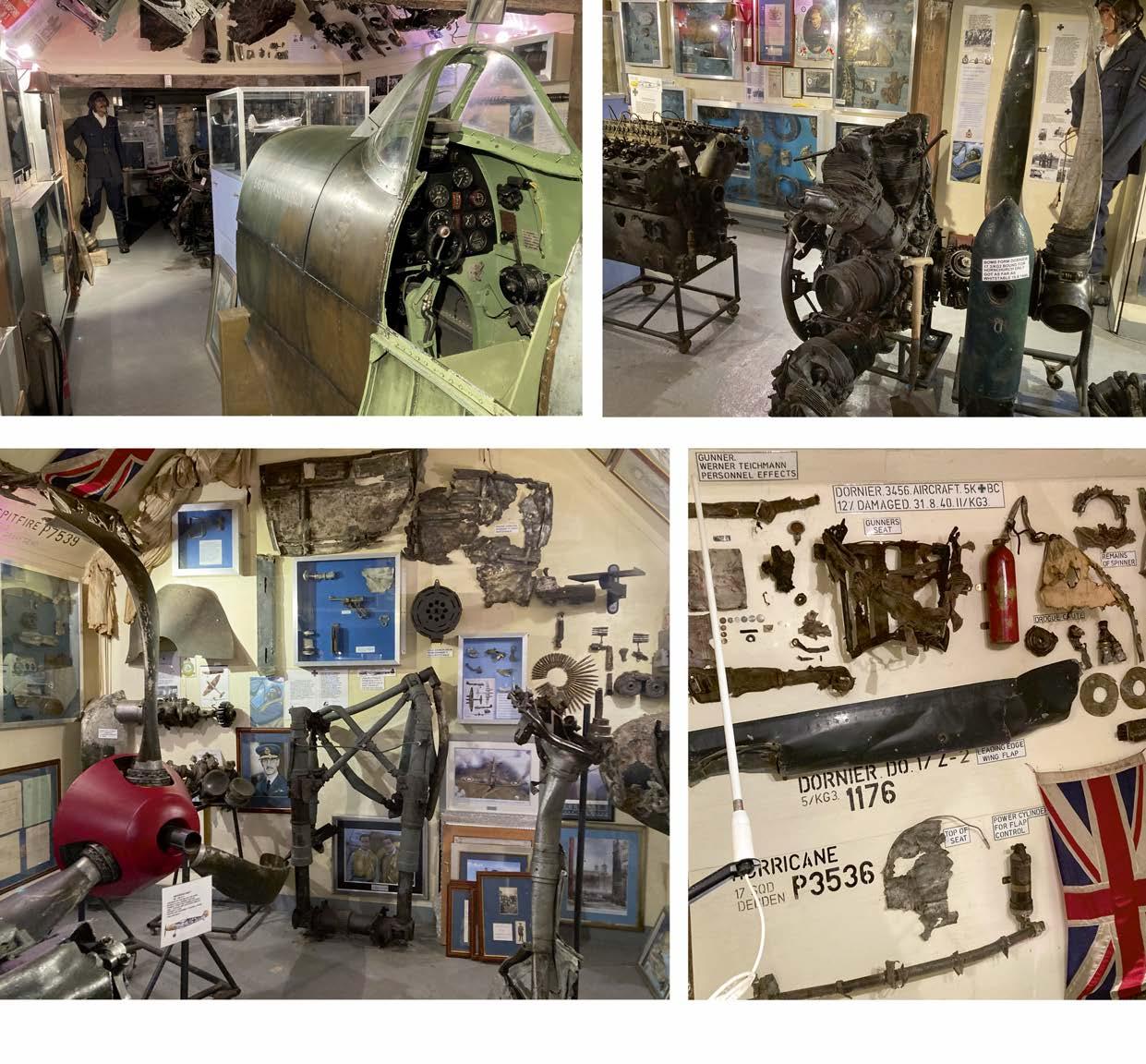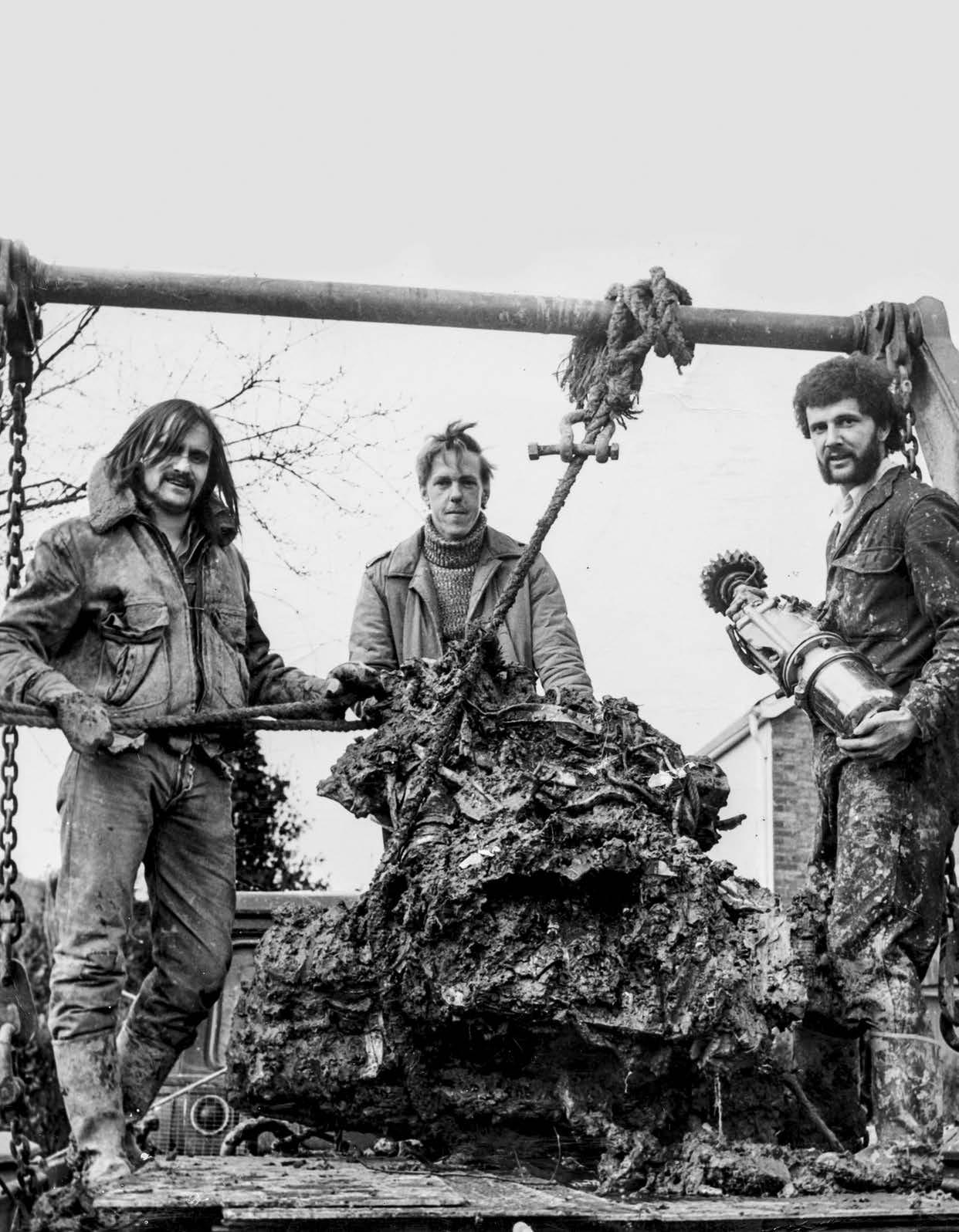Aviation & Military History Medals & Militaria
The Tonbridge Battle of Britain Museum Collection
18 MAY 2023



18 MAY 2023


18 May 2023 at 10am
VIEWING (LOTS 1-381: ONLY ON VIEW IN SOUTH CERNEY)
Tuesday 16 May 9.30am-5.30pm
Wednesday 17 May 9.30am-5.30pm
Morning of sale from 9am (other times strictly by appointment)
VIEWING (LOTS 401-557: ONLY ON VIEW IN TONBRIDGE, KENT)
Tuesday 9 May 10am-4.30pm (strictly by appointment)
Wednesday 10 May 9.30am-4pm (strictly by appointment)
The whole auction will be conducted from our offices in South Cerney and bidders cannot personally attend the sale in Tonbridge, Kent.
AUCTIONEER
Henry Meadows MRICS
Mallard House, Broadway Lane, South Cerney, Cirencester, Gloucestershire, GL7 5UQ
T: +44 (0) 1285 860006
E: info@dominicwinter.co.uk www.dominicwinter.co.uk
Condition reports now including video conferencing can be requested in the following ways:
T: +44 (0)1285 860006
E: info@dominicwinter.co.uk
Via the relevant lot page on our website www.dominicwinter.co.uk
All lots are fully illustrated on our website (www.dominicwinter.co.uk) and all our specialist staff are ready to provide detailed condition reports and additional images on request. We recommend that customers visit the online catalogue regularly as extra lot information and images will be added in the lead-up to the sale
Customers may submit commission bids or request to bid by telephone in the following ways:
T: +44 (0)1285 860006
E: info@dominicwinter.co.uk
Via the relevant lot page on our website www.dominicwinter.co.uk
Live online bidding is available on our website www.dominicwinter.co.uk (surcharge of 3% + vat): a live bidding button will appear 60 minutes before the sale commences. Bidding is also available at the-saleroom.com (surcharge of 4.95% + vat) and invaluable.com (surcharge of 3% + vat).
For payment information see our Information for Buyers page at the rear of this catalogue. For details regarding storage, collection, and delivery please see our Information for Buyers page or contact our office for advice.
If you intend to export goods you must find out in advance if:
a. there is a prohibition on exporting goods of that character e.g. if the goods contain prohibited materials such as ivory.
b. if they require an Export Licence on the grounds of exceeding a specific age and/or monetary value threshold as set by the Export Licensing Unit. We are happy to offer the submission of necessary applications on behalf of our buyers but we will charge for this service to cover the costs of our time. The typical cost of an application is £50 + VAT, but this price cannot be guaranteed or fixed.

All lots are offered subject to the Conditions of Sale and Business printed at the back of this catalogue. For full terms and conditions of sale please see our website or contact the auction office. A buyer’s premium of 20% of the hammer price is payable by the buyers of all lots, except those marked with an asterisk, in which case the buyer’s premium is 24%. Artist’s Resale Rights Law (Droit de Suite). Lots marked with AR next to the lot number may be subject to Droit de Suite. For further details see Information for Buyers at rear of catalogue.
CBP006075
Catalogue Produced by Jamm Design – 020 7459 4749 info@jammdesign.co.uk
Photography by Marc Tielemans – 07710 974000 | marc@tielemans.co.uk Darren Ball – 07593 024858 | darrenball1989@gmail.com
Motoring & Railway 1-10
Military Ephemera 11-31
Militaria & English Civil War Armour
Antique Swords & Fighting Knives
Antique Guns & Powder Flasks
Orders, Decorations & Medals
Aviation Art
Aviation Ephemera
Wing Commander W.M. Sizer, DFC & Bar
The Tony Parsons Aviation Collection
Aviation Memorabilia
The Tonbridge Battle of Britain Museum Collection

32-60
61-139
140-172
173-199
200-228
229-266
267-271
272-308
309-381
401-557
Please note that while the whole auction will be conducted in South Cerney all the lots in this final section of the sale will remain in situ in Tonbridge, Kent. Please see the catalogue title-page and page 114 for further details about viewing and collecting arrangements.

£300-500 : 17 May
Wednesday 10 May Printed Books, Maps & Atlases
The Brian (Kala Singh) & Nirmal Russell Library of British India
Thursday 17 May
Photographs, Autographs & Historical Documents British Royalty Memorabilia

Wednesday 14 June Printed Books, Maps & Documents
Thursday 15 June Modern First Editions & Literature Private Press, Illustrated Books & Original Art Playing Cards from the Dudley Ollis Collection
Wednesday 19 July
Thursday 20 July
Printed Books, Maps & Documents
British & European Paintings Old Master Prints & Drawings 20th Century Pictures
Friday 21 July
Antiques & Historic Textiles
Entries are invited for the above sales: please contact one of our specialist staff for further advice
King Charles III. A Signed Christmas and New Year Card, 1993, in very fine condition From a large collection of signed British royalty Christmas cards and photographs sent to Michael Ashley Mann KCVO (1924-2011), Anglican bishop and Dean of Windsor, 1976-1989.
To commence at 10am
Please note that while the whole auction will be conducted in South Cerney, all the lots from the Tonbridge Battle of Britain Museum Collection (lots 401-557) will remain in situ in Tonbridge, Kent. Please see the catalogue title-page and page 114 for further details about viewing and collecting arrangements.
1* Locomotive & Tender. A fine 5 Inch Gauge Live Steam Coal-fired GWR Class 4-6-0 Locomotive and Tender, beautifully executed in GWR green livery as No. 7829 ‘Ramsbury Manor’, with 6-wheel non-corridor tender fitted with hand pump, the 3-cylinder locomotive with conjugated valve gear and screw reverse, whistle, injector, twin water gauges, boiler and steam chest pressure gauges, steam brake with pressure gauge, in excellent condition with boiler certificate by Morewood Model Engineers Ltd dated 14 July 1987, presented in a glazed wooden display case, 97 cm high x 189 cm wide x 39 cm deep


The Great Western Railway 7800 Class or Manor Class of steam locomotives were designed as a lighter version of the Grange Class, giving them a wider Route Availability. The first of the Manors No. 7800 Torquay Manor was built at Swindon Works and entered traffic in January 1938. By February 1939 twenty were in service but the outbreak of World War II forced the cancellation of construction of a further batch of twenty locomotives. However, after nationalization, the newly created Western Region of British Railways was authorized to build ten more of the class. Nos. 7820–29 at the Swindon Works in November and December 1950. They were named after Manors in the area covered by the Great Western Railway. The Manor class, with an axle loading of just over 17 tons, could be utilised on many lines from which the heavier Granges were barred. No. 7829 Ramsbury Manor was the last of the Manor Class steam locomotives to be built. It was constructed in December 1950 and withdrawn from service in December 1965, being scraped at Cashmore’s in Newport. During its time of service, Ramsbury Manor conducted improved draughting tests in February 1954. The original nameplate was sold at auction in September 1995 for £7550. Nine of the original Manor Class locomotives have been preserved.
(1) £4,000 - £6,000

2 Aston Martin. A brochure for the DB2 Sports Saloon and Drophead Coupe, 1950, ref num 1013, 9pp., monochrome and colour illustrations, outlining full specification, original printed wrappers, with glassine wrapper, slim oblong 4to (1) £100 - £150
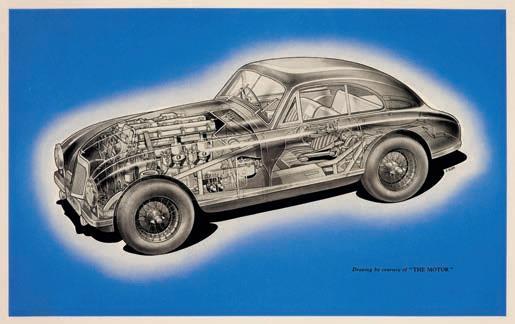
3* Motor Car Racing. An archive relating to racing car driver Joan Chetwynd (The Honourable Mrs Chetwynd) (1898-1979), including letters, newspaper cuttings, Christmas card from Malcolm Campbell with facsimile signature and photographs of Blue Bird, six Brooklands Racing Car Driver Christmas cards dated 1931-35, newspaper cuttings from Le Mans 1931/32, black and white motoring photographs, RAC Rally & Coachworks Competition brochure, The British Driver Double Twelve 1921 armband and other related items all relating the motoring career of Lady Chetwynd

Joan Chetwynd (1898-1979) née Joan Gilbert Casson was a British driver at the 24 Hours of Le Mans. She was introduced to motorsport shortly after her marriage in 1928 to her second husband Adam Duncan Chetwynd, 9th Viscount Chetwynd of Bearhaven (1904-65). Her early outings were in circuit racing and she was both a regular at Brooklands and Le Mans. She used the nom de course The Honourable Mrs Chetwynd. The earliest records of Joan's racing career appear in 1929, when she set a new twelve-hour Class F speed record at Brooklands, driving a 1500cc Lea-Francis, with an average speed of 82.98 mph. In 1931 Joan was involved in "The Brooklands Society Ladies' Private Handicap", a handicap race for female drivers at the Weybridge circuit, organised by the novelist Barbara Cartland. It was not a genuine race but comprised a series of scenes and amateur driving stunts performed for the benefit of a camera crew. Joan, the only experienced Brooklands racer in the group was scheduled to finish second. The motoring press discovered there was an experienced racing driver present and as a consequence, the participants were lambasted by journalists. Joan defended herself in a letter to The Motor, which stated that she had agreed to take part in a film about motor racing on an anonymous basis. She proceeded to condemn the poor driving standards of the other drivers present in a scathing manner. In 1932 Joan won the Women's Automobile Sports Association Ladies' Handicap at the Guys Gala Meeting, Brooklands, but after 1932, she appears to have concentrated predominately on rallying, achieving considerable success. During the Second World War, she served in the WAAF and didn’t return to competitive motorsport after the war. See lot 5.
(an archive)
Each lot is subject to a Buyer’s Premium of 20% (Lots marked * 24% inclusive of VAT @ 20%)
£300 - £500
4* Brooklands. A collection of early Brooklands Automobile Racing Club Badges circa 1911-20 belonging to Colonel F. Lindsay Lloyd C.M.G. C.B.E. (1866-1940), comprising eight Members Enclosure badges and an Official 1920 badge, together with a collection of motorcar keys including two AA and one RAC, plus two motoring maps of England & Wales by Forster Groom & Co, circa 1910

Provenance: Colonel F. Lindsay Lloyd C.M.G. C.B.E. (1866-1940), then by family descent.
Colonel Lloyd was commissioned into the Royal Engineers in 1885, Lloyd spent time in Hong Kong on sea defence work where they had to build the boats they needed to work from. He served in the South African campaign (1899-1901). He was involved in testing early motorised equipment for the army. In 1908 as the “new” Clerk of the Brooklands track he was elected to the Aero Club of Great Britain. He continued as Clerk of the Course for the next 20 years, as well as becoming The Manager of Brooklands Racing Club.
The RAC and BARC introduced the first record regulation which were drawn up by Major F. Lindsay Lloyd in his position as Clerk of the Course at Brooklands. President of the British Motor-Cycling Racing Club in 1926 Auto Cycle Union Vice President 1925-1939 Racing Committee of B.A.R.C. 1935. (15) £150 - £200
5* Car Badge. Royal Automobile Club Associate car badge circa 1938, chromed with red and white enamel ‘Junior Car Club’ centre, numbered F97422, with bracket, together with three pamphlets for The Junior Car Club Members Meeting, July 1938 plus J.C.C. British Double-Twelve Hour Race, Brooklands 8/9 May 1931 brochure

Provenance: “Speedqueen” Joan Chetwynd (The Honourable Mrs. Chetwynd) (1898-1979), then by family descent. See lot 3.
(1) £150 - £200

6 Sunbeam Motor Car Company. The History and Development of the Sunbeam Car 1899-1924, Wolverhampton: Sunbeam Motor Car Company Ltd., [1924], 2 tipped-in photogravure plates including portrait and frontispiece of a Sunbeam car, tipped-in colour plan of Moorfield Works, black & white plates from photographs, printed red side-notes, some spotting, original buff wrappers, printed title to upper cover, soiling and wear, upper wrapper near detached, 4to

(1) £100 - £150
(1) £80 - £120
8* Shell Oil Posters. A 1960s re-issue after the original by Norman Keene 1924, ‘A Sound Investment’ “Bank” On Super Shell Motor Lubricating Oil, printed by W.R. Royale & Son Limited, 51 x 75 cm, together with The Leading Line, reprint after an unknown artist, 51 x 75 cm, both folded

(2) £100 - £150
9* Ship’s Bell. A good 19th century bronze ships bell, with decorative belfy, 34 cm high, mounted on an oak base

(1) £150 - £200
10* Transport Sign. A London transport bus destination indicator, black and white Waterloo sign, issued 17 June 1976, 17.2 cm x 109.5 cm, framed and glazed, together with a carved wooden ‘Wellington boot’ caricature wall hanging 58 cm x 38 cm

(2) £100 - £150
to a
11* World War One Letters. An archive of approximately 29 letters sent between temporary Captain Cyril Parry with the Yorkshire Regiment/Green Howards, 1915-19, to his sweetheart Dorothy ‘Dot’ Forster in Bradford, Yorkshire, comprising uncensored letters from the Front, whilst on leave in England, and returning to active duty in Salonika, all one to four pages, together with their original envelopes, plus approximately 15 miscellaneous family letters and related ephemera, including some photographs, postcards, Field Cards, etc.
After service in Belgium and France and Eastern Europe in the First World War Major Arthur Cyril Lawes Parry MBE MC (born 1893) was to serve in India and Palestine in the 1930s. Captain Parry’s letters (particularly ones from the Front) contain some explicit and unusual, uncensored comments. One of the first letters, 1 October 1915, describes the appalling conditions and of Parry killing his first German soldier: ‘We came into the trenches last Sunday night and have had a rotten time. It has been bitterly cold and rained everyday, it is not at all pleasant to be wet and cold for five days. Of course the whole place is one lake of mud and you go floundering about in it just like tadpoles, you are simply covered in it from head to foot, but funny to say everybody is very cheerful and it is the unfortunate German who gets blamed for everything ... I killed my first German yesterday he was a sniper and I spotted him with my field glasses sitting in a tree. I had three shots at him and he tumbled out at the third. He is also the first German I have seen.’ A later letter from 25 October gives details of close combat: ‘I had quite an exciting time last Friday afternoon, I was sniping away at the Germans from a ruined farm house which was in our trenches. The Germans however spotted me and sent two shells into the place, covering me with dust etc I thought it was time to clear out and a good job I did as they put 18 more in and blew the house to pieces. We were quite sorry to leave those trenches as we had such spiffing dug outs. Mine had a bed, armchair, table and a fire place, as you can imagine when there was a fire in it, it was very cosy.’ On 5 January 1916 Parry describes action on the first day of the year: ‘... had a most excellent new years eve and I am afraid a good many Bosches (sic) only saw one hour of 1916, poor beggars, however war is war. About 90 of our men raided the German trenches opposite use and proceeded to lay out everybody they came across. We took them absolutely by surprise and were in their trenches before they were aware of the fact.’ The letters also mention daily life at the Front, his Military Cross nomination (awarded January 1918), training various Battalions of the Green Howards in England, his revolver accidentally discharging in his pocket, and action and subsequent injury whilst fighting in Salonika.


(a folder)
12* WWII Maps. A collection of 23 maps of the Italian campaign 1943-44, 1:250,000 and 1:2500 scale, together with Air Staff Planning Charts 1949-50, four sheets covering Middle East to Australia, Madagascar to Japan, used for plan flights from any RAF or RN airfields plus 94 sheets of War Office issued maps, New Popular 1 inch OS maps, both English and Scottish Ordinance Surveys, there are two copies of 15 of these sheets, the Isle of Man is a 1940 War Edition on cloth of the previous ‘Popular Series’ (120) £100 - £150
£400 - £600
(1) £100 - £150
14* WWII Photographs. A WWII photograph album, containing approximately 80 snapshot size photographs of British Western Desert and Italy, many soldiers, RAF vehicles, Matilda tank, scammel tank recovery, Italian tank, German 88 gun, Me110, British bomber and other subjects, presented in a photograph album but lacking covers, 17 x 25 cm, together with another WWII photograph album, containing approximately 170 photographs compiled by J Scott, showing training in England, RAF camps at Cardington, RAF motorcycle, ARP dugouts, RAF Austin Tily pickup, Rome, desert Vickers Wellington with bomb tractor, various aircraft including B17, Bristol Blenheim, crashed Me109, Ju88 and Ju52 with Afrika Korp prisoners, presented in a souvenir style photograph album, 20 x 28 cm
(2) £70 - £100
15* WWII Japan. A WWII Japanese photograph album, containing approximately 140 black and white photographs including soldiers, swords, daily life and training etc., presented in a soft cloth album

18.5 x 27 cm

(1) £70 - £100
16 Special Air Service. SAS War Diary 1941-1945, the Association Edition, London: Extraordinary Editions Ltd., [2011], facsimile with colour and monochrome illustrations printed on thick paper, original blind-stamped light brown leather over bevelled boards with leather strap, large thick folio, contained in original packaging for postage.
Limited edition 300/500. The limitation leaf is applied as the front pastedown and made out for ‘J.E.E.W.’. Accompanying the book is a generic letter from the purchaser.
(1) £300 - £500
17 Naval books. A collection of naval books, including Blue Star Line, A Record of Service 1939-1945 by Taffrail; Naval Brigades in the Indian Mutiny 1857-58; Navy Records 1947; Navy List January 1892; Navy List December 1912 and other related books
(5 cartons) £100 - £150
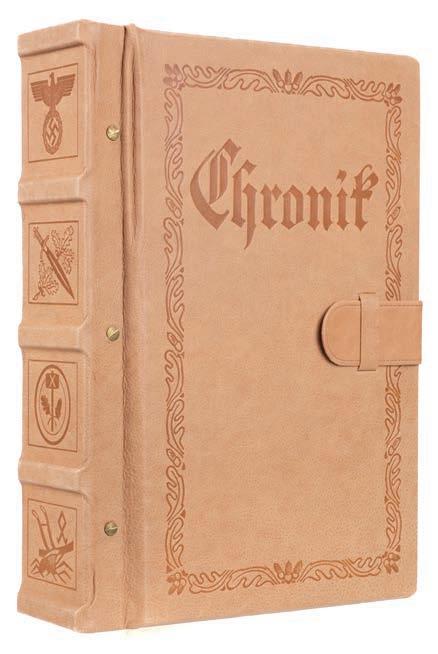
18* War Savings. WWII Savings and Welfare in the Royal Navy H.M. Forces Savings poster printed for H.M. Stationery Office by R.B. Macmillan Ltd, showing historical views, 73 x 48.5 cm, together with The Royal Navy Badges of H.M. Ships H.M. Forces Savings poster, 73 x 49 cm, National Savings poster by Fosh & Cross Ltd, London showing uniforms of the British Army from 1600 to the present day and six other posters
(8) £70 - £100 Lot
19* Victoria Cross Interest. WWI identity bracelet belonging to Corporal James McGregor, Cameron Highlanders who died on 18 April 1918 and brother of Lieutenant Colonel John MacGregor the highly decorated VC winner, the oval aluminium disc stamped ‘J McGregor 1729 P 4 Cameron’, on a steel link chain

James McGregor served during the Great War with 1st Bn, Cameron Highlanders, he died during the German Spring Offences on 18 April 1918 and is commemorated in the Woburn Cemetery, Cuinchy, he was 26 years old. His brother was Lieutenant Colonel John McGregor, VC, MC & Bar, DCM, ED, 2nd Canadian Mounted Rifles Later 1st Central Ontario Regiment, C.E.F., (1889-1952).
John was Canada’s most highly decorated Infantryman of the Great War. His VC is in the collection of the Canadian National Army Museum.
(1) £100 - £150
20* Talbot-Booth (Paymr. Lieut-Comdr, E.C.), Merchant Ships 1940, Sampson Low, Marston & Co., Ltd, hard-bound publication with dust wrapper, Brassey’s Naval Annual 1938 and 1940, Jane’s Fighting Ships 1941, Thornycroft photograph album, containing approximately 45 black and white photographs of motorboats, album 25 x 30 cm

(a carton) £70 - £100
21* Victoria Cross Interest. A WWII letter written by Air Vice Marshal Francis Hubert (Frank) McNamara, VC, CB, CBE to his son Robert dated 30 October (1944), the letter written on Air Mail Letter Paper addressed to 300242 AC2. McNamara. R.E. Royal Air Force, RAF Eastcliffe Hotel, Babbacombe, Torquay, stamped RAF Censor 136 in purple ink, the letter details general family chitchat and signs off, yours Dad, 19 x 12 cm
Francis Hubert (Frank) McNamara (1894-1961) was born in Rushworth, Victoria, Australia. He was the first Australian airman to receive the Victoria Cross. McNamara served during the Great War with the Australian Flying Corps and received the VC for his actions on 20 March 1917. He rescued a fellow pilot who had been forced down behind enemy lines. McNamara held senior posts in England and in Aden during WWII and rose to the rank of Air Vice Marshal in 1942. He retired from service in 1946.
(1) £100 - £150
22* Worcestershire Yeomanry. An archive relating to Trooper Walter Ronald Repton who was killed in action on 23 April 1916, including letters, photographs of his childhood and military service and his memorial, pocket diary, original documents, and letter notifying his death to the next of kin from the War Office, contained in two folders with a detailed list which is available on request Walter Ronald Repton served during WWI with Queen’s Own Worcestershire (Worcester Yeomanry), he embarked at Avonmouth on 9 April 1915 for service with the Mediterranean Expeditionary Force, he disembarked at Alexandria, Egypt on 24 April 1915 and was killed in action on 23 April 1916, Repton is commemorated in the Jerusalem Memorial, Israel.
(1) £200 - £300
23* WWII RAF. A WWII collection belonging to Charles John Allen, 116 Squadron, comprising a sterling silver identity bracelet engraved ‘Luck be with you all my lover Doris’, pilots cloth wings, airman’s pay book with entries for 1943 at North Weald, No 22 EFTS, 116 Squadron, Gatwick and Biggin Hill 1944 plus 24 black and white photographs showing training in Canada with Fairey Battle cockpit, loading bombs on wings, Spitfires and other subjects and a large image of Horsa Glider



(1) £200 - £300
24* Regimental Colours. Australian Commonwealth Forces, Souvenir of the Greatest War, coloured lithographic print on paper, showing a rising sun with divisions of the Australian Commonwealth Forces, four vignettes showing topographical views of Belgium, France, Egypt and Gallipoli, with a list of medal decorations, some creases and staining, 53 x 70 cm mount aperture, framed and glazed, frame size 67 x 83 cm
(1) £100 - £150

25 World War II Uniforms and Insignia. J.A.N. #1. Joint Army and Navy Publication. Uniforms and Insignia, prepared by the Military Intelligence Service and the Division of Naval Intelligence, c. 1944, unpaginated colour plates with individual printed card covers and thumb tabs for sections on Japanese Navy, Netherlands Navy, German Air, French Navy, German Navy, Portuguese Navy, Italian Navy, Spanish Navy and Turkish Navy, a few pencil scribbles to blank pages, in original printed cloth box with shoestring spine tie binding, upper cover stating ‘Not for sale’, rubbed and soiled, a little fraying at spine ends, oblong 8vo (16 x 27 cm)

(1)
£100 - £150
26* D-Day Landings. Ver-sur-Mer, [Normandy, Northern France], May 1944, colour printed 1:12,500 scale operations map, stamped ‘This map will not be carried in operational aircraft’ and ‘Top Secret until issued for briefing ground troops, thereafter Secret’ at upper margin, covering the area around Ver-sur-Mer, overprinted in blue with all known German defences, obstacles and weapon-emplacements covering the beaches to the north of the town as at May 1944, with details of ramps, surfaces, sandbanks and exits from the beaches printed in red, some spotting, light dampstaining and minor creasing, closed tear to left margin, 53 x 64 cm, framed and glazed Issued in preparation for the D-Day landings on 6 June 1944.
(1) £100 - £150
27* Hezlet (Vice Admiral Sir Arthur). British and Allied Submarine Operations in World War II, limited edition 8/200, two volumes with slipcase, 31.5 x 22.5
(1) £200 - £300
29* WWI Photographs. Royal Flying Corps photograph album, containing 84 photographs of RFC uniforms, aircraft on ground and in flight DH6, Sopwith Baby, RE8, DH4, troop ships at dock etc


(1) £100 - £150
£100 - £150
30*
A photograph album belonging to Major General William Scott Cole, 1920-24, approximately 100 mounted gelatin silver prints (mostly two per page, to recto and verso), hand-written captions to margins, contemporary green cloth gilt, neat ownership inscription of Cole to front board and front pastedown, bumped, oblong 4to

(1) £150 - £200
31*
and
Air
photographs albums, containing approximately 180 photographs in two albums, both compiled by Flight Sub Lieutenant Neil Howard McDiarmid, stationed at Royal Naval Station Yarmouth from July to October 1916, mostly captioned including uniforms, flying apparel, aircraft crashes, DSO recipient FSL Pulling, C17 airship, HMS Brocklesby (airship), HMS Illustrious, British Submarine, Short 150 and various airships, various names including Captain Robert Kilgour Shives, George Brittles etc
(2) £400 - £600
cm 28* Cigarette Cards. Victoria Cross Heroes, Gallaher Ltd, series 1-8 of 25, a complete set of 200 (200) Royal Military Academy, Woolwich. WWI Photographs. Royal Flying Corps Royal Naval Service32* Major Bruce Shand, MC & Bar. The WWII tropical tunic belonging to Major Bruce Shand, MC & Bar, 12th Lancers, who was the father of Camilla, Queen Consort, light brown cloth with brass regimental buttons, MC & Bar medal ribbon, the pocket with tailors label for H. Huntsman & Sons Ltd, 11 Saville Row, London, inscribed in ink ‘Capt B.H.H. Shand 18/44 795’, approximately 85 cm long, chest-length 40 cm, inner arm length 50 cm, together with a pair of green heavy cloth trousers inscribed ‘Shand’
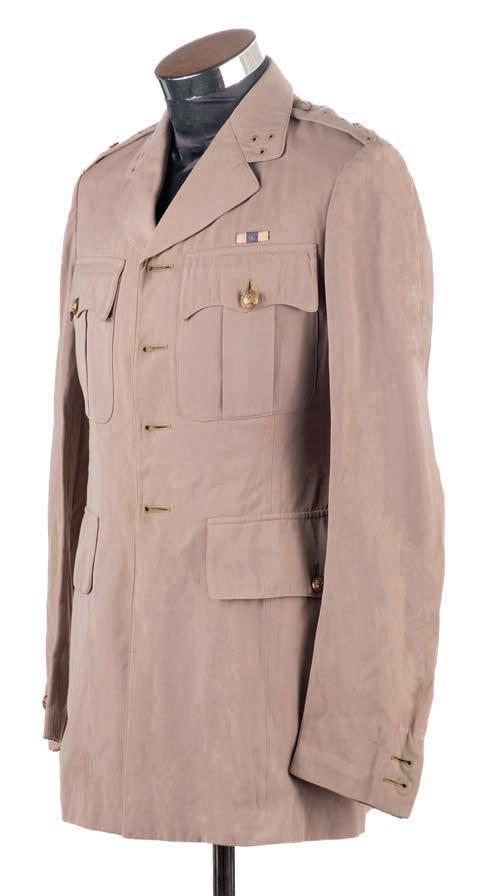
Major Bruce Middleton Hope Shand MC & Bar (1917-2006) was an officer in the British Army. He is best known as the father of Camilla, Queen Consort. Major Shand was born in London and educated at Rugby and Sandhurst before being commissioned into the 12th Lancers (2nd Lieutenant) in 1937. He was promoted to Lieutenant in 1940 and served in France where he aided in covering the withdrawal to Dunkirk from where he was evacuated back to England. He received the Military Cross for his actions on 5 July 1940. Major Shand returned to overseas service in September 1941 when the regiment was sent to North Africa where he was awarded the second award bar for the MC on 9 July 1942.
He met Winston Churchill shortly before the Second Battle of El Alamein and on 6 November 1942 his vehicle was surrounded and destroyed. Shand’s two crewmen were killed and he was wounded and captured. Shand spent the remainder of the war in the POW camp, Oflag IX A in Spangenberg Castle. (1) £300 - £500
Each lot is subject to a Buyer’s Premium of 20% (Lots marked * 24% inclusive of VAT @ 20%)
33* Armour. A copy of a 16th century cabaset steel helmet, brass flower head roundels and pear stalk finial
(1) £70 - £100
34* Badges. A collection of military and university bullion embroidered badges, all post-WWII, including Royal Artillery, Merchant Navy and Order of the Thistle, presented in a ring folder (32) £70 - £100
35* Denison Smock. WWII Airborne Troops Denison smock dated 1943, with printed tailor’s label for Parkinson (Walsall) Ltd 1943 (size 4), green camouflage with four pockets to the front, brass pop studs and ‘G’ zip, shoulder epaulettes with composite button, elasticated cuffs and named ‘Richard H Greenfield’ (stitched to the lining), an additional label numbered ‘2534’ and inscribed in black ink ‘805’, 84 cm long, 50 cm chest, 42 cm inner arm

Provenance: From the estate of Sir Harry Greenfield (1898-1981), Royal Tunbridge Wells.
(1) £300 - £500
36* English Civil War. A Cromwellian period ‘lobster tail’ helmet, with rounded skull piece, three-bar face protection and onepiece comb, blackened finish and lacking ear flaps (1)


£1,500 - £2,000
37* English Civil War. A Cromwellian period Doglock Musketoon, the 63 cm two-stage barrel with flared muzzle and proof marks, flintlock action with doglock, fully stocked (refurbished), overall length 100 cm, with ramrod

Provenance: Pembroke Fine Arms and formerly from a private collection. This dates from around 1640 and has a second English lock with early London Gunmaker’s view mark identified as circa 1640 from Howard Blackmore’s excellent book British Military Firearms 1650-1850. Originally this would have had a thick wrist but this has been reshaped about a hundred years later, maybe as early as 1720 and is now similar to the more familiar “Brown Bess”. The forend has also been repaired in the distant past and the horn tipped ramrod has been added later (probably 18th Century). The gun has been used and remodelled to suit both fashion and practicality for at least a hundred years since it was first made. I’ve personally never seen such an early English gun in private ownership, most are held in museums. See Baxter (Arms and Armour Press 1970) for more information. Pembroke Fine Arms refers. (1)
£2,000 - £3,000
£1,500 - £2,000
38* English Civil War. A Cromwellian period ‘lobster tail’ helmet, with rounded skull piece, three-bar face protection and onepiece comb, blackened finish and lacking ear flaps (1)39* Escape & Evasion. A WWII RAF button compass, the brass button by Buttons Ltd, Birmingham, unscrews to reveal the small airmans compass, 15 mm diameter and scarce


(1) £150 - £200
40* Escape & Evasion. A WWII silk escape map, Scandinavia and the Baltic, 1: 3,000,000 dated 1 April 1940, two tissue paper maps for Eritrea and Northern Europe, plus four 1950s silk maps, flechettes, German padding dated 1939 and various badges

(1) £100 - £150
41* Letter Opener. WWI Imperial German officer’s sword letter opener, 18.5 cm curved steel blade, brass lions head grip, overall length 23 cm, in its steel scabbard, together with suspension straps from a full-size German army dagger, silver bullion with oak leaf decoration and green velvet lining

(2) £100 - £150
42* Military Pin Badges. A collection of French military and civil pin badges, including 6 Commando Entertainment, Ecole Militaire Strasbourg and others
(125) £200 - £300
Each lot is subject to a Buyer’s Premium of 20% (Lots marked * 24% inclusive of VAT @ 20%)
Lot 41
Lot 43
43* Mortar Rounds. A pair of decommissioned inert military 80 mm mortar rounds, late 20th century, polished chrome finish, 66cm long


(2) £200 - £300
44* Munition. A collection of 11 30 mm Aden Rounds, each stamped 30 mm RG 72, 20 cm long, together with 3 Mauser 27 mm Tornado rounds, the bases stamped 27-145-DM1001, 24 cm long plus three 30 mm 170 Rarden rounds as used in armoured fighting vehicles such a Warrior, Scimitar, Sabre and Fox, and other single rounds, all inert
(22) £200 - £300
45* Munitions. A collection of WWII and later brass shell cases, including a 105 mm British brass cartridge for use in the 105 mm Light Gun, with fired primer, transfer of Prince of Wales feathers applied to the side of the case, and other shell cases
(18) £200 - £300
46 Munitions. A fired 17 Pr. armour piercing projectile, capped (APC), repainted black body with blue cap and 1/2” red band to nose and immediately below the blue cap

(1) £100 - £150
47 Munitions. An inert WWI British 6pdr Tank Round Shell dated 1918, brass case being well stamped to the base with projectile, 49 cm long
(1) £150 - £200
48* Munitions. An inert WWII German 5 cm PAK anti tank round, 60 cm long together with another German round stamped auz C/30 St with waffen eagle, 52 cm long
(2) £150 - £200
49* Munitions. An inert 30 mm 170 Oerlikon round, for use on Oerlikin KCB used on Type 22 frigates, 28 cm long, together with another plus a collection on inert rounds including 7.62 mm NATO drill rounds, .50 Browning drill rounds etc
(17) £100 - £200
50* Munitions. Inert rounds including a German mortar rounds, together with a British 3 Pr IV round dated 1938, 49 cm long, 2 Pr MkII dated 1943, 30.5 cm and other items
(6) £100 - £150
51* Munitions. An inert 120mm round for the recoilless Battalion Anti-Tank gun, brass case with deep bronze green painted HESH projectile, filled with inert explosive substitute and used for proof of propellant charge, projectile stencilled (white): 120MM BAT”; “SX434GF REP SX369GF”: “HE SUB”; “21-9-76”; “CSR PROOF OF PROP” Projectile stamped “P”; “SN 103 GE”; “LY 3867 A0 RLB”; “3 69 LOT 359”, together with another similar, inert (2) £200 - £300
52* Munitions. WWI German Howitzer cartridge case converted for use as a bucket, the base stamped OKT 1917, 20 cm high x 23 cm diameter, together with a collection of WWI period brass shell cases including a 6pr dated 1916, 30.5 cm high
(8) £100 - £150
 Lot 46
Lot 46
53* Regimental Colour. The remnant of the Regimental Colour of the 71st Highland Light Infantry 1817-37, silver bullion wire on silk, the embroidered battle honour scroll with one side for ‘Peninsula’ the other for ‘Almarez’, laid on an early 19th century map of Tipperary and presented in a period gilt moulded frame, glazed, frame size 21.5 x 64.5 cm, with an inscribed note which according to the information with the lot was found behind the backing board ‘This is a portion of the Colour of the 71st Regiment (Highland Light Infantry) and was borne through the Peninsular War’ (which is inaccurate, see notes provided with the lot)

Provenance: Reputedly laid over the monument to Major-General Sir Denis Pack ay St. Canice’s Cathedral, Kilkenny, Ireland and purchased in Ireland by the A.S.J.
The Battle of Almarez was a battle of the Peninsular War which took place on 18-19 May 1812 between the Anglo-Portuguese Army under Lord Hill destroyed the French pontoon across the River Tagus, Almarez, Spain. The bridge was protected by two French garrisons at either end. The action was swift-moving, deceptive and daring. The decisive result produced improvement in the Allied position by keeping French forces separated ahead of the imminent Battle of Salamanca. (1) £200 - £300
54* Royal Irish Rifles. A Victorian white metal badge of the Royal Irish Rifles, with harp and crown and the motto Quis Separabit and battle honours, two lugs to the back, 10 cm long, presented in an Edwardian style silver frame

(1) £100 - £150
55* Sculpture. A patinated spelter figure of a Boer soldier circa 1900, modelled kneeling and firing a rifle, indistinctly signed ‘Gamavily’ [?], slight loss of feather, 36 cm high x 35 cm long

(1) £200 - £300
56* Sculpture. An Imperial German patinated spelter figure modelled as an Infantry soldier after C. Silbernagel 1898, with pack and rifle (the barrel broken and needs re-affixing), the base additionally signed C. Rakenius & Co, Berlin, with an engraved white metal plaque, 34.5 cm high, together with various miscellanea comprising two Imperial German framed certificates, a powder horn, Third Reich porcelain butter dish
(5) £100 - £150
57* Third Reich. Allach white glazed porcelain bear by Theodore Karner circa 1935-45, modelled with paws resting on a ball, incised SS runes mark and ‘6’ to base 8.5 cm high Allach porcelain was produced in Germany between 1935 and 1945. After its first year of operation, the factory was run by the SS. The emphasis on decorative ceramics.
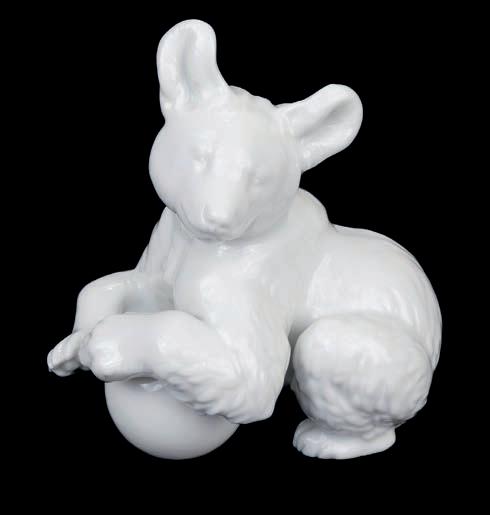
(1)
£300 - £500
59* Trench Watch. A WWI trench watch, circular white enamel dial with illuminated arabic numerals, subsidiary seconds dial with pierced steel hands, the nickel metal case with distinctive protective cover, stamped ‘Depose’, 35 mm diameter case with original thin brown leather strap (non running)

(1) £100 - £150
58* Trench Art. A shell case projectile in relic form with a printed label ‘Battle of the Somme 1st July - 18th November 1916 “Rememering”’, 18 cm long together with an inert hand grenade circa 1916 converted to a pen stand with George V farthing and .303 rounds as decoration 10 cm high
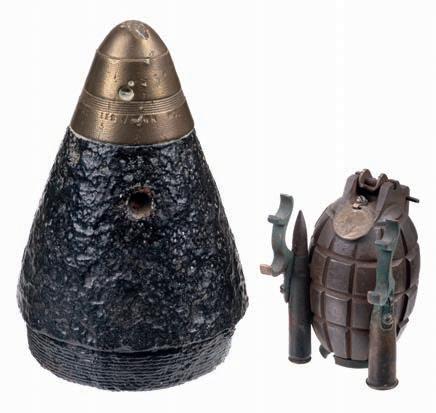
(2)
£100 - £150
60* U-Boat Binoculars. A pair of WWII Kriegsmarine binoculars, probably 7 x 50, green composite casing, fixed focus, rubber eyepieces and objective lenses, with leather neck strap (the strap perishing), optics clear but the rubber cracked and the casing worn The rubber is in a fragile state and therefore unable to remove to see markings.
(1) £800 - £1,200

61* Applegate Knife. A Boker Applegate Fairbairn “Fighting Knife”, serial number ‘7739’, in cordura scabbard. With fine Fairbairn and Applegate etched signatures to blade, together with ‘Boker and APPLEGATE FAIRBAIRN’ logo and ‘Germany 440-C STAINLESS’ to ricasso

(1) £100 - £150
62* Applegate Knife. A Blackjack Applegate Fairbairn “Fighting Knife”, serial number ‘05620’, in original leather scabbard. With Fairbairn and Applegate etched signatures to blade, together with ‘Blackjack Knives and APPLEGATE FAIRBAIRN’ logo and ‘Made in U.S.A.’ to ricasso.
(1) £100 - £150
63* Bayonet. A good example of a French Gras bayonet with matching serial numbers 96734, engraved along the top edge as standard and dated 1877, hooked quillon and wooden and brass grip, overall length 64.5 cm
(1) £50 - £70
64* Bayonet. An American M9 Phobis III bayonet, the 18 cm bowie style blade stamped MK100573, black crossguard and composite green grip, overall length 30.5 cm, in its green sheath with pouch and belt strap
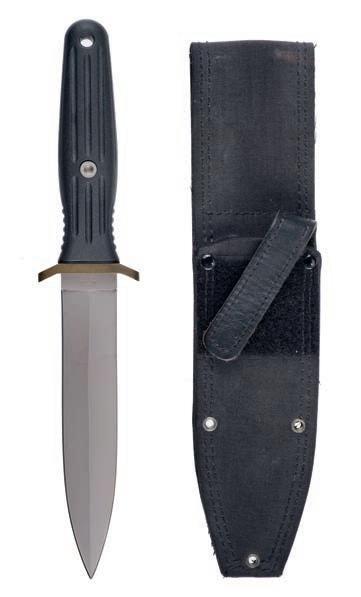
(1) £100 - £150
65* Bayonets. A Garrand bayonet, the 25 cm blade stamped US with flaming grenade and PAL, composite grip, overall length 36 cm, in its scabbard, together with an American M4 knife bayonet, the 17 cm blackened steel blade stamped 127307, black composite grip, overall length 29 cm, in its green scabbard with webbing plus three other bayonets
(5) £150 - £200
66* Bowie Knife. A Victorian bowie knife, the 18 cm blade stamped ‘J Rodgers & Sons 6 Norfolk St Sheffield England’, star and Maltese cross marks, German silver oval crossguard, chequered horn grip with ‘hoof’ pommel, overall length 30.5 cm, in its brown leather sheath (1) £100 - £150

67* Court Sword. A George V court sword, the 80 cm straight steel blade with brass guard applied with silver G.V.R. cypher and thistle wreath with brass kuncklebow and grip with urn finial, overall length 94.5 cm, in a brown leather scabbard with brass mounts together with a similar George V example but with crown finial and lacking scabbard, overall length 85 cm
(2) £100 - £150
68* Court Swords. Continental court sword, the 72 cm straight steel blade with brass hilt and urn pommel, overall 84 cm, in its black leather scabbard with brass mounts, together with two further Continental court swords,
(3) £200 - £300
69* Court Swords. Victorian court sword by Boulter, Hepburn & Watts, 28 George Street, Hannover Square West, the 79 cm steel blade etched with foliate scrolls, brass hilt with urn pommel with sword knot, overall length 94.5 cm, in its black leather scabbard with brass mounts (scabbard damaged), together with a later court sword by Hill Brothers, Old Bond Street, London W, in its black leather scabbard with chamois frog
(2) £100 - £150
70* Fighting Knife. A WWII collection belonging to Corporal R.G. Wall, No 6 Commando, including a 1st Pattern Fairbairn Sykes Fighting Knife by Wilkinson Sword & Co Ltd, London, a fine original example with 17.5 cm double edge blade etched with trademarks on either side of the ricasso, "S" guard, chequered grip and top nut, overall length 30 cm, in its brown leather scabbard with brass chape, WWII service medals comprising 1939-45 Star, War and Defence Medals, Police Long Service Medal, E.II.R. (Const. Reginald. G. Wall) extremely fine, the latter in named card box of issue, several original WWII Commando documents including Commando Service Certificate dated 28 September 1945, Holding Operational Commando Pass dated 2 August 1945, another dated 23 August 1945, Old Comrades Association of the Special Service Brigade blue book dated 19 August 1943, No 6 Commando cloth shoulder title, Combined Operations Command cloth badge, silk escape map of Scandinavia and the Baltic 1:3,000,000, another double-sided of France and Germany 1:2,350,000, "war souvenirs" including a German Army belt, the leather faintly scratched with the initial R.G.W. (presumably Corporal Wall laying claim), Norwegian M1894 bayonet in its scabbard numbered 286, veterans Commando badges and other items

See lot 193 (WWI medals awarded to Wall's father).
A letter is sold with the lot which gives vague details of the previous owner’s father's service in Norway to carry out attacks. It is therefore surmised that Wall took part in Operation Archery.
On 27 December 1941, No 6 Commando took part in Operation Archery, also known as the Måløy Raid. It was a British Combined Operation raid against the Germans on the island of Vågsøy, Norway.
The objective was the destruction of fish-oil production and stores which the Germans used in the manufacture of high explosives. Another intention was to cause the Germans to maintain and increase forces in Norway, which would reduce forces deployed on the Eastern Front, thereby giving a numerical advantage to Allied forces.
Four fish oil factories and stores were destroyed and German prisoners were taken with a loss of 17 Allied killed and 53 wounded. (1) £3,000 - £5,000
71* Fighting Knife. A WWII American alloy fighting knife, the 17 cm steel blade with integral alloy guard and ribbed grip, 30 cm long, with brown leather sheath
(1) £400 - £600
72* Fighting Knife. A WWII Italian ‘MVSN’ fighting knife, the 20 cm bowie style blade with oval steel crossguard and ‘folk art’ style carved wooden grips, one side with a swastika, the other ‘Bice Silvana’ and ‘Mamma’ (some loss of grip)

(1) £50 - £80
73* Fighting Knife. A WWII period American fighting knife by Cattaraugus, the 15.5 cm blade with fuller, stamped Cattaraugus 225Q, steel guard, leather washer grip, overall length 27 cm, in its brown leather sheath

(1) £100 - £150
74* Fighting Knife. An American M-3 Utica fighting knife, the 17 cm blade with steel crossguard stamped ‘U.S. M-3 Utica’, wooden grip and flat steel pommel with flaming grenade stamp, overall length 29 cm, together with a U.S. M3 Utica fighting knife, overall length 29 cm, both lacking scabbard plus a WWII British Army clasp knife, composite grips, blade worn

(3) £100 - £150
75* Fighting Knife. WWII 2nd pattern fighting knife, the 16.5 cm with blackened steel crossguard with B2 and broad arrow stamps, chequered brass grip and steel top nut, overall length 29 cm, in its brown leather scabbard with brass mounts, general pitting and wear commensurate with age and use
(1) £150 - £200
76* Fighting Knife. WWII American M3 fighting knife dated 1943, the 16.5 cm blade stamped ‘U.S. M3 PAL 1943’, steel crossguard and wooden grip, the late steel pommel with double rivets, overall length 28.5 cm, in its green scabbard with webbing belt loop
(1) £70 - £100
 Lot 73
Lot 75
Lot 73
Lot 75
77* Fighting Knives. WWII American U.S. M3 Camillus fighting knife, the 17 cm steel blade with wooden grip, overall length 29.5 cm, in its green scabbard stamped U.S. M.8AI PWH, together with an American fighting knife, unidentified but with bowie type blade, wooden grip, overall length 30 cm in a black leather sheath

(2) £100 - £150
78* Gerber Knife. A Gerber MkI Boot Knife, serial number ‘C1629S’ in original leather scabbard. Gerber logo to ricasso together with serial number. Gerber logo address to scabbard boot clip.
(1) £50 - £80
79* Gerber Knife. A Gerber MkII “Combat” Knife, serial number ‘017526’, dating this knife to 1970 and the Vietnam War. With straight narrow-wasp blade. Gerber logo and serial number to ricasso. No scabbard.

(1) £200 - £300
80* Gerber Knife. A Gerber MkII 35th Anniversary Limited Edition Presentation Knife. Serial number ‘010052’. Complete in a presentation box with scabbard and Certificate of Authenticity. The knife is a faithful reproduction of the original knife with a “Cat’s Tongue” handle. Etched on the blade “Mark II™ / 35th. Anniversary 1966 - 2001”
(1) £300 - £400
81* Gerber Knife. A Gerber MkII Survival Knife, serial number ‘030751’, dating this knife to 1973 and the Vietnam War. 14 TPI serrated section to stainless steel blade in original leather scabbard. Gerber logo to ricasso.
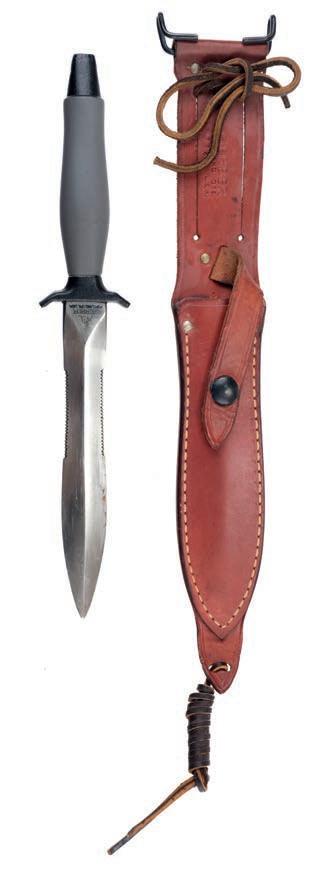
(1) £200 - £300
 Lot 79
Lot 80
Lot 79
Lot 80
82* Gerber Knife. A Gerber MkII Survival Knife, serial number ‘H8312S’, dating this knife to 1989. 8 TPI serrated section to stainless steel blade in original cordura scabbard. Etched ‘Mark II TM’ to blade.

(1) £150 - £200
83* Gerber Knife. An early Gerber MkII Combat Knife, serial number ‘002808’. Dating this knife to 1967 and the Vietnam war. With Cats tonge grey handles grip and canted 5-degree ‘narrowwasp’ blade. Presented in replacement ‘Randall style’ leather scabbard. This is a rare, early production Gerber MkII knife as sold by US PX stores throughout the Vietnam war that met with the designer’s, U.S. Army Captain Clarence A. “Bud” Holzmann, original specifications.
(1) £400 - £600
84* Hunting Knife. An early 20th-century hunting hanger, the 26 cm double edge blade stamped ‘Whitby Solingen Germany’, etched with a mountainous landscape, German silver shell guard, S shape quillon with acorn finials, stag antler grip with black and red roundels, flared pommel with oak leaves, overall length 36.5 cm, in its black leather scabbard with white metal mounts

(1) £100 - £150
85* Indian Swords. 19th century Indian tulwar, the 78 cm curved blade with iron steel hilt and shaped kuckleguard, overall length 93 cm, the whole piece heavily pitted, together with another tulwar, overall length 86.5 cm (lacking top), an East European short sword, the 54 cm curved steel blade with brass guard cast with an exotic bird, wooden grip with brass studs, overall length 66.5 cm, in its green cloth covered scabbard plus a large jungle knife and a huge cutlass probably South American, each with leather sheath
(5) £200 - £300

86* Knives. A Victorian Bushman hunting knife, the 13 cm engraved ‘Bushman’ within scroll, stamped Warranted Cast Steel Sheffield’ with crown and VR, rosewood grip inset with two Warranted Superior brass roundels and a brass vacant cartouche, overall length 23 cm, in its brown leather sheath, together with a 19th century Green River hunting knife, the 13 cm steel blade faintly engraved Green River within scroll and clipped along the top edge, rosewood grips with brass rivets, overall length 22.5 cm, in its black leather sheath, plus another 19th century Green River knife with 15 cm steel blade faintly marked and clipped along the top edge, rosewood grips with brass rivets, overall length 25.5 cm, in its brown leather sheath plus a 20th century Spanish hunting knife, the 15 cm nickel plated blade stamped ‘R. Zafrilla Albacete, plated crossguard and leather washer grip with plated pommel, overall length 24.5 cm, in its brown leather sheath


(4)
£150 - £200
87* Knives. An American hunting knife, the 17.5 cm bowie type blade blackened, with crossguard and leather washer grip, overall length 30 cm, together with a three further hunting knives including one by C. Wostenholm & Son, Washing Works, Sheffield, England, the 12.5 cm blade stamped IXL, chequered composite grip, overall length 23.5 cm, in brown leather sheath with military arrow numbered ‘3’
(5) £150 - £200
88* Knives. A Swedish hunting knife by Bahco, the 14 cm blade numbered 3921 with makers markings, black composite grip, overall length 26 cm, in its black composite sheath with leather belt strap stamped Bahco, together with an identical knife but the leather belt strap stamped ‘Volvo’

(2) £100 - £150
89* Prussian Sword. A Prussian Artillery Officer’s sword, the 78 cm slightly curved blade with cast brass langets, knucklebow and lion head back strap, wirebound fishskin grip, overall length 91 cm, in its steel scabbard (pitted)
(1) £100 - £150
90* Prussian Sword. A Prussian model 1889 Infantry Officer’s sword, the 80.5 cm straight steel blade with double fuller, hinged Prussian eagle folding guard, the black celluloid grip wire-bound with Kaiser Wilhelm II cypher, knucklebow and angled steel pommel, overall length 96 cm, with gold bullion sword knot, in its black painted steel scabbard
(1) £200 - £300
91*
A
171/4088.
as
handle with brass crossguard with red/white/black/white/red spacers. Randall mark to blade together with serial number “RKS 171/4088. Leather scabbard with Randall snaps, orange honing stone, Made in USA. Stamped on reverse ‘Randall Made Knives, Orlando, FLA’ with additional ‘The Randall Knife Society’ stamp, with green paracord leg tie
This knife is number 171 of 1200.
(1) £400 - £500
honing stone, Made in USA. Stamped on reverse ‘Randall Made Knives, Orlando, FLA’ and ‘7’.
(1) £300 - £500
Randall Knife. Randall Knife Society RKS Model 4-8 “Fighter”. Serial number RKS Also known the RKS4. Stag 92* Randall Knife. A Randall Model 1-7, “All Purpose Fighting Knife” c.1950. Leather stacked handle with brass crossguard with red/white/black/white/red spacers. Randall mark to blade. Leather scabbard with plain steel snaps, orange93* Randall Knife. A Randall Model 1-7, “All Purpose Fighting Knife” late 20th Century. Antler (possibly Simba) handle with brass crossguard with red/white/black/white/red spacers. Randall mark to blade. Leather scabbard with Randall snaps, orange honing stone, Made in USA. Stamped on reverse ‘Randall Made Knives, Orlando, FLA’ and ‘7’
(1) £300 - £500
94* Randall Knife. A Randall Model 2-8, “Fighting Stiletto” late 20th Century. Stag (possibly Simba) handle with brass crossguard with red/white/black/white/red spacers. Randall mark to blade. Leather scabbard with Randall snaps, orange honing stone, Made in USA. Stamped on reverse ‘Randall Made Knives, Orlando, FLA’ and ‘2-8’. Light staining to blade.
(1) £200 - £300
Each lot is subject to a Buyer’s Premium of 20% (Lots marked * 24% inclusive of VAT @ 20%)
95* Randall Knife. A WW2 Randall Model 1-8, “All Purpose Fighting Knife” a “Springfield Randall’ c.1943/44. Leather stacked handle with brass crossguard with red/white/black/white/red spacers. The blade marked ‘Randall Made, SPFLD MASS’ making this knife one of the rare Unmatched but period leather scabbard with plain steel snap
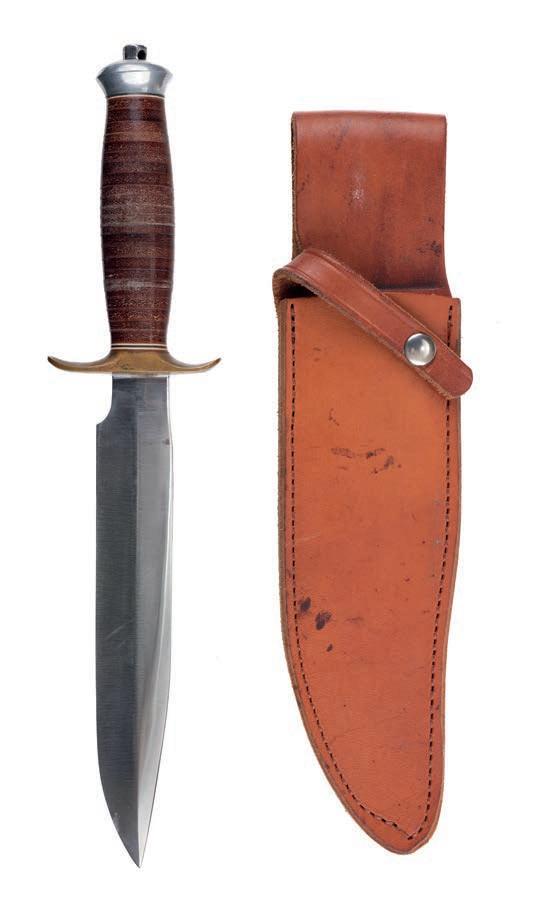


(1) £700 - £1,000
96* Randall Knife. Various knife collectors’ reference books, including Randall Knives A Reference Book by Sheldon & Edna Wickersham, hardback publication with dust jacket; Randall Made Knives The History of the Man and the Blades by Robert L. Gaddis, hardbound publication with dust jacket; Randall Knives Rare, Unique & Experimental by Robert E. Hunt, hardbound publication with dust jacket; Randall Fighting Knives in Wartime WWII, Korea & Vietnam by Robert E. Hunt, hardbound publication with dust jacket; Randall Military Models Fighters, Bowies and Full Tang Knives by Robert E. Hunt, hardbound publication with dust jacket; John Nelson Cooper Cooper Knives by William A. Martin and Paul Charles Basch, hardbound publication (plus book two), and other knife books including Moran and Knifemakers of Old San Francisco
(12) £100 - £150
97* Ruana Knife. A 60th Anniversary Bowie Knife by Ruana. A Limited Edition of 100 of these knives were made in 1998, this being numbered 56. Presented in fine display case, the knife comes with the original leather scabbard and Certificate of Authenticity. A rare example from the Ruana Knife Works.


(1)
£300 - £500
98 Shamshir. A 19th century Indian shamshir, the 72 cm curved steel blade engraved all the way along with wild animals including tigers, antelope, elephants and birds, steel hilt with cruciform crossguard and curved grip with scroll knucklebow, the blade showing signs of combat, overall length 85.5 cm


(1)
£200 - £300
99* Sword Display Case. A 20th century oak display case formerly housing a Georgian blued and gilded sword, the hinged glass door with two locks (lacking keys but with catches to the sides), 25.5 cm high x 119.5 cm wide x 16 cm deep
(1)
£70 - £100
Lot 98
100* Sword. 1897 pattern officer’s sword, the 81 cm straight dumbbell blade etched with E.II.R. cypher, plated guard with E.II.R. cypher, wirebound fishskin grip and stepped pommel, overall length 98 cm, in its plated scabbard
(1) £100 - £150
101* Sword. 19th century American officer’s sword, the 75 cm straight steel blade with blued and gilded decoration, brass guard with eagle langets, carved bone grip, knuckleguard and eagle head pommel, overall length 88 cm, in its black leather scabbard with brass mounts

(1) £200 - £300
102* Sword. A George III cavalry officer’s sword, circa 1796, the 82 cm curved steel blade with silver stirrup hilt and chequered ivory grip, overall length 94 cm, in its black leather scabbard with silver mounts, engraved Prosser late Gullum, Sword Cutler and belt maker to the King Charring Cross London, the hallmarks bearing the monarch George III and maker IP (John Prosser, registered 1796) Ivory submission reference, 17147K4L. (1) £700 - £1,000



103* Sword. A George III period flank officer’s sword, the 68 cm curved steel blade with brass stirrup hilt and replacement wooden grip, overall length 78.5 cm, in its brass scabbard, worn


(1) £200 - £300
104* Sword. A George III period hanger, the 71 cm curved steel blade engraved with flowers, brass strirrup hilt and chequered bone grip, overall length 83 cm, in its black leather scabbard with brass


mounts
(1) £300 - £500
105* Sword. A Prussian Model 1899 Infantry Officer’s sword, the 84 cm straight nickel plated blade with double fuller, folding brass guard cast with Prussian eagle and composite grip bound in brass and with cypher of Emperor Wilhelm II, overall length 98 cm, in its black metal scabbard, a good clean example
(1) £150 - £200
106* Sword. A Scottish basket hilt broadsword circa 1800, the 80 cm steel blade with single fuller, gilt metal pierced basket, wire-bound fishskin and domed pommel, overall length 96 cm long, with the remains of the scabbard, perished but retaining gilt metal mounts, the blade showing signs of heavy combat
(1) £500 - £800
107* Sword. A Continental ‘Toledo’ ceremonial sword, early to mid 20th century, the 85 cm straight steel blade etched with a knight Templar and scrolls, the opposite side with military trophies, with gilt brass cup guard engraved Toledo, horse head and dragon quillon, wirebound grip, and female head pommel, overall length 114.5 cm, in its leather scabbard with foliate engraved brass mounts


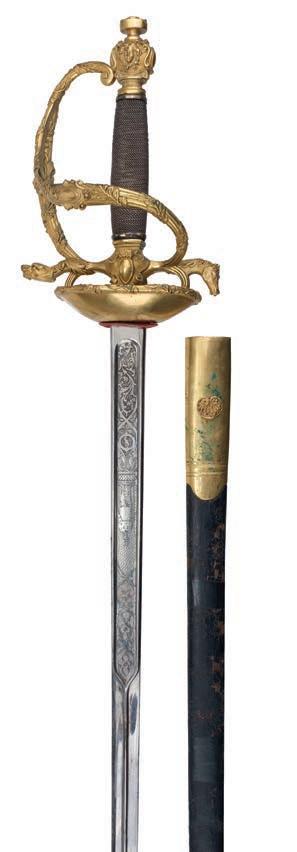
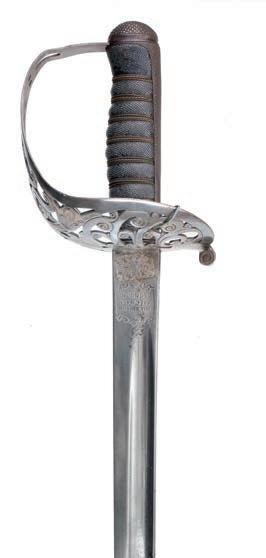
(1) £100 - £150
108* Sword. A Victorian 1821 Pattern Cavalry Officer’s sword, the 89.5 cm slightly curved blade, plain with Wilkinson Pall Mall London maker’s mark, steel honeysuckle guard, wirebound fishskin grip, chequered back and domed pommel, overall length 104.5 cm, lacking scabbard
(1) £100 - £150
Each lot is subject to a Buyer’s Premium of 20% (Lots marked * 24% inclusive of VAT @ 20%)
109* Sword. A Victorian 1822 pattern 4th East York Artillery Volunteers Officer’s sword by Hobson & Sons, 94 St Martins Lane, London, the 82 cm slightly curved steel blade etched with regimental insignia and foliate scrolls, steel three-bar guard, wirebound fishskin grip, domed pommel, overall length 97 cm, in its steel scabbard
(1) £150 - £200
110* Sword. A WWII German Artillery Officer’s sword by Alexander Coppel, the 75.5 cm slightly curved blade with langet cast with crossed swords, the other plain, beast head quillon black celluloid grip bound in brass wire, acanthus backstrap and stirrup hilt, lions head pommel with ruby eyes, overall length 88.5 cm, in its black metal scabbard, a good clean example
(1) £200 - £300
Lot 108 Lot 109111* Sword. A WWII German standard army officer’s sword by E. & F. Horster, the 78 cm slightly curved blade with brass hilt, the langet engraved with eagle and swastika, the other plain, black celluloid grip bound in brass wire, the backstrap and stirrup hilt engraved with acorns and oak leaves, overall length 90 cm, in its black metal scabbard, a nice clean example
(1)
£200 - £300
112* Sword. An Edwardian Scottish broadsword, the 90 cm blade with proof mark and G mark, the straight steel crossguard with two handed cord bound grip and flared steel pommel, overall length 116 cm, lacking scabbard

(1)
£150 - £200
113* Sword. An Imperial Prussian Garde Artillery Officer’s sword by Weyersburg, Kirschbaum & Company, the 83.5 cm slightly curved blade with plain steel langet applied with brass Garde’s badge with the motto Suum Cuiques (to each his own), the other plain, black celluloid grip bound in brass wire, rounded backstrap and stirrup hilt, overall length 95.5 cm, in its black metal scabbard, a good clean example

(1)
£200 - £300
114* Sword. Early 19th century naval cutlass, the 74.5 cm straight steel blade with two brass guard and black metal grip, overall length 86.5 cm, in its black metal scabbard with brass mounts

(1) £200 - £300
 Lot 112
Lot 113
Lot 112
Lot 113
115* Sword. Early 19th century naval sword, the 76.5 cm curved steel blade with two brass brass guard and grip, overall length 87.5 cm, in its black leather scabbard with brass mounts
(1) £200 - £300
116* Sword. George III period hanger in the 1796 style, the 68.5 cm curved steel blade with brass stirrup hilt and wooden grip, overall length 80 cm, in its Prosser leather scabbard with brass mounts (general wear to the scabbard)

(1) £200 - £300
117* Swords. An 1803 pattern officer’s sword, the 76 cm curved steel blade with remains of gilt metal hilt, wirebound fishskin grip and lions head pommel, overall length 91 cm, together with a composite Scottish short sword, overall length 84 cm
(2) £150 - £200
118* Swords. An 1821 pattern India issue officer’s sword, the 81.5 cm slightly curved steel blade stamped Gilligan, three-bar guard, remains of wirebound fishskin grip, stepped domed pommel, overall length 95.5 cm, in its brown leather scabbard with brass mount, together with an 1885 pattern Indian Cavalry sword, the 88 cm curved steel blade stamped Mole Birm, steel bowl guard pierced with Maltese cross, chequered composite grip, overall length 103 cm, in its brown leather scabbard with steel mount

(2) £200 - £300

119* Swords. An 1821 pattern Royal Artillery officer’s sword by H. Brown, 11 Union Street, Birmingham, the 85.5 cm slightly curved blade etched with G.V.R. cypher and Royal Artillery insignia, three bar guard, wirebound fishskin grip, stepped domed pommel, overall length 102 cm, in its steel scabbard, together with an Edward VII period officer’s sword by Hamburger Rogers & Co, Kings Street, Covent Garden, numbered 5179, the 83 cm slightly curved steel blade etched with E.R.VII cypher and scrolls, plated three bar guard, wirebound, fishskin grip and domed pommel, overall length 98 cm, in its plated scabbard
(2) £200 - £300
120* Swords. An 1827 pattern Rifle Regiment sword, the 82 cm slightly curved steel blade etched with strung bugle and crossed lances, steel guard pierced with strung bugle, wirebound fishskin grip, stepped domed pommel, overall length 97 cm, in a black leather scabbard with steel mounts, together with a WWI period officer’s sword carried by the Royal Army Medical Corps, the 82.5 cm straight steel blade numbered 6772, brass guard pierced with G.V.R. cypher, wirebound fishskin grip, chequered backstrap and domed pommel, overall length 99 cm, in its brown leather scabbard (pitted and poor condition)



(2) £200 - £300
121* Swords. An 1845 pattern levee sword by J.B. Johnstone & Co, Sackville Street, London, the 82.5 cm sightly curved steel blade etched with VR cypher, brass hilt with folding guard and pierced with VR cypher, wirebound fishskin grip, stepped domed pommel, overall length 96.5 cm, its brass scabbard, together with another similar by Pillin, overall length 95 cm
(2) £200 - £300
122* Swords. An 1853 universal pattern cavalry sword by Enfield, the 89.5 cm slightly curved steel blade stamped Enfield, steel three bar guard, lacking grips, overall length 103 cm, in its steel scabbard, together with an 1885 pattern cavalry troopers sword, the 88 cm curved steel blade stamped 2/86 with Enfield and war department stamps, steel bowl pierced with maltese cross, composite grips, overall length 100 cm, in its steel scabbard plus an 1889 pattern cavalry sword by Wilkinson, with a non regulation adapted hilt, composite grips, overall length 101.5 cm, in its steel scabbard



(3) £300 - £500
123* Swords. An 1897 pattern officer’s sword, the 83 cm steel blade etched with G.V.R. cypher and scrolls, the opposite side with pennant, steel honeysuckle bowl guard, wirebound fishskin grip, overall length 99 cm, it its brown leather scabbard, a Victorian Naval officer’s sword, the 79 cm slightly curved blade (tip reduced), brass gothic hilt with folding guard, wirebound fishskin grip and lions head pommel, overall length 93 cm, in its leather scabbard with brass mounts (leather damaged), plus a 1912 cavalry sword plus an 18th century small sword (both damaged)
(4) £200 - £300
124* Swords. An 1908 pattern cavalry officer’s sword of the 5th Dragoon Guards, the 89 cm straight steel blade stamped Wilkinson with inspection stamps, the steel bowl stamped 5DG, composite chequered grip, domed pommel, overall length 110 cm, lacking scabbard, together with a 1912 pattern cavalry officer’s sword by Manton & Co, Calcutta, the 88 cm straight steel blade etched with GRI cypher, foliate engraved steel bowl, wirebound fishskin grip and stepped pommel, overall length 108 cm, in its brown leather scabbard
(2) £200 - £300
125* Swords. 19th century Continental small sword, the 83 cm triangular hollow blade with initials I.S. & Co, brass shell guard etched with initials, foliate cast knucklebow and wirebound grip, overall length 95.5 cm, together with an 18th century Continental small sword, the 73 cm steel blade with pierced double shell guard and grip, overall length 90.5 cm, plus a Continental court sword, with white metal mounts and black leather scabbard
(3) £200 - £300
126* Swords. 19th century French naval officer’s sword, the 77 cm slightly curved blade with elaborate gilt metal guard pierced with anchor and clover leaves, horn grip, overall length 91 cm, in its black leather scabbard with brass mounts applied with an anchor, together with a French police officer’s sword, the 81.5 cm straight steel blade with double fuller, brass double shell guard (lacking button), brass knucklebow and cast foliate grip, overall length 97 cm, in its black leather scabbard with brass mounts
(2) £200 - £300
127* Swords. A George V period naval officer’s sword, the 79 cm straight steel blade etched with royal coat of arms and fouled anchor, the opposite side with G.V.R. cypher, folding brass guard and gothic hilt, wirebound fishskin grip and lions head pommel, overall length 94 cm, in its black leather scabbard with brass mounts, together with a Victorian naval “child’s” sword, the 66.5 cm straight steel blade with brass langets cast with crown and anchor, stirrup hilt, wirebound fishskin grip and lions head pommel, overall length 78 cm, lacking scabbard
(2)
£150 - £200
128* Swords. An early 17th century transitional period rapier, the 90 cm straight steel blade faintly marked, with serpent crossguard, wooden grip and shaped pommel, overall length 107.5 cm, together with an 18th century small sword, overall length 88 cm, both in poor condition



(2)
£200 - £300
129* Swords. An early 19th century court sword by P ... Solingen, the 81 cm straight steel blade etched with military trophies, brass double shell guard cast with an entwined serpent, mother of pearl grip and cast brass knuckle bow and pommel, overall length 95.5 cm remains of scabbard engraved ‘Bland & Foster St James’, together with an 18th century infantry sword, overall length 86.5 cm (2)
£150 - £200
Lot 127130* Swords. Boer War period Royal Artillery officer’s sword, the 83.5 cm with Edward VII cypher, with plated three-bar guard, wirebound fishskin grip, chequered backstrap and stepped domed pommel, overall length 100 cm, in its brown leather scabbard, together with another similar, the 88.5 cm steel blade etched with owners initials J.C.B., overall length 104 cm in a brown leather scabbard
(2)
£200 - £300
131* Swords. Dutch / East Indies kleewang practice sword, the 62.5 curved steel blade with rounded tip, steel bowl guard, wooden grip, overall length 79 cm, together with a copy of a U.S. 1917 cutlass, finished in black, overall length 76 cm with brown leather scabbard
(2) £100 - £150
132* Swords. A Victorian 1845 pattern infantry officer’s sword, the 81.5 cm slightly curved blade with worn makers mark but probably Ponder & Sons Duke St ..., crown and scroll engraving, pierced folding guard, wirebound fishskin grip and stepped pommel, overall length 95 cm, in its brass scabbard, together with another by Ponder & Son, Duke St, St Jame’s London, overall length 95.5 cm, in its brass scabbard (poor condition)


(2) £100 - £150
133* Swords. Victorian 1821 pattern light cavalry officer’s sword, the 88 cm slightly curved blade etched with VR cypher, steel three bar guard, wirebound fishskin grip, stepped domed pommel, overall length 102 cm, lacking scabbard, together with a WWI period officer’s sword, the 82.5 cm straight steel blade etched with G.V.R. cypher, three bar guard, wirebound leather grip, chequered backstrap and domed pommel, overall length 98 cm, in its brown leather scabbard
(2) £200 - £300
134* Swords. Victorian 1845 pattern officer’s sword by Kenning, Little Britain, London, the 80 cm slightly curved steel blade etched with VR cypher, brass guard with pierced VR cypher, wirebound fishskin grip and stepped pommel, overall length 95.5 cm, in its black painted scabbard, together with an 1822 pattern sword by J.B. Johnson, London, the 82.5 cm slightly curved steel blade with traces of etching, brass guard with folding guard, remains of wirebound fishskin grip, overall length 97 cm, in its brass scabbard
(2) £200 - £300
135* Swords. WWI 1897 period pattern officer’s sword, the 83 cm plated steel blade with multiple stamps, includind EFD and broad arrow, with honeysuckle guard pierced with G.V.R. cypher, remains of fishskin grip and stepped domed pommel, overall length 102 cm, in its brown leather scabbard, together with another WWI period 1897 pattern sword issued to the Royal Engineers, the 83 cm blade by Army & Navy Cooperative Society, 105 Victoria St, London, overall length 98.5 cm, in its brown leather scabbard stamped ‘Ca 1917’
(2) £150 - £200
136* Swords. WWI Artillery Officer’s sword by J. Daniels & Co, Artillery Place Woolwich, the 88.5 cm steel blade numbered 10325 with plated three-bar guard, wirebound fishskin grip, chequered backstrap and stepped domed pommel, overall length 105 cm, in its brown leather scabbard, together with another similar issued to the Royal Army Medical Corps, the 86.5 cm plated steel blade by Walker & Hall, in it’s brown leather scabbard
(2) £200 - £300
137* Swords. WWI Artillery Officer’s sword by W.W. White, Frances St, Woolwich, the 79 cm steel blade etched 3rd Volunteer Artillery, with flaming grenade to the opposite side, with plated three-bar guard, wirebound fishskin grip, chequered backstrap and stepped domed pommel, overall length 95 cm, in its brown leather scabbard, together with another similar but with George VI cypher, overall length 104 cm in it’s brown leather scabbard (2) £200 - £300

138* Swords. WWI period 1897 pattern officer’s sword by Henry Wilkinson, Pall Mall, London, numbered 47437, the 84 cm plated steel blade with honesuckle guard pierced with G.V.R. cypher, fishskin grip and stepped domed pommel, overall length 100 cm, in its brown leather scabbard, together with two other 1897 pattern swords including a levee pattern example by Cater & Co Ltd, 62 Pall Mall, S.W., both with brown leather scabbard (3) £200 - £300
139* Third Reich. A WWII Kriegsmarine dirk by Carl Eickhorn, Solingen, the 25cm double edge steel blade etched with anchor and scrolls, the opposite side similary engraved, makers mark near towards the tang, gilt-metal cross-guard, celluloid wirebound grip and eagle pommel, overall length 38cm, in its brass scabbard (1) £300 - £500

140* Deactivated Gun. A British Sterling Sub Machine Gun, 9 mm calibre, serial number KR26164, with deactivation certificate dated 3 December 2019

(1) £400 - £600
143* Deactivated Gun. An Australian Lithgow Light Machine Gun, .303 calibre, serial number A726, with deactivation certificate dated 3 December 2019 (1) £600 - £800


141* Deactivated Gun. A Canadian Inglis Light Machine Gun, .303 calibre, serial number 4T1988, with deactivation certificate dated 3 December 2019

(1) £600 - £800
144* Deactivated Gun. An Israeli Uzi Sub Machine Gun, 9 mm calibre, serial number 83189, with deactivation certificate dated 3 December 2019 (1) £300 - £500

142* Deactivated Gun. A Chinese AK 47 Sub Machine Gun, 7.62 mm calibre, serial number 17039626, with deactivation certificate dated 3 December 2019

(1) £400 - £600
145* Musket. A George III period ‘slavers’ flintlock musket, the 113 cm two-stage barrel with proof marks, the side lock engraved with an elephant and howdah, stamped ‘Warranted’, fully stocked, with steel trigger guard and butt-plate, overall length 155 cm long, with ramrod (1) £700 - £1,000

146* Pistol. A 19th century American .30 percussion boxlock pistol, the 5.5 cm blued two stage barrel with burnished steel rounded casing and hammer offset with rounded wooden grips, action in good working order, overall length 14 cm

(1) £150 - £200
148* Pistol. A George III flintlock cannon barrel travelling pistol by Waters of London circa 1780, the 6 cm turnoff barrel with steel casing engraved ‘Waters’ and with military trophies, with walnut grip inlaid with inlaid wirework decoration, silver cartouche engraved with a family crest and silver grotesque butt cap with Birmingham hallmarks, action in good working order, overall length 20 cm

(1) £500 - £800
147* Pistol. A 19th-century small percussion pocket pistol, the 4.5 cm turnoff barrel with foliate engraved casing, concealed trigger guard and walnut chequered grip with oval escutcheon and German silver lion’s head butt cap, action in good working order, overall length 13.5cm

(1) £150 - £200
149* Pistol. A George III flintlock pistol by Brander & Potts, London circa 1810, the 23 cm octagonal barrel engraved ‘London’ this somewhat cruder than the gunsmiths engraving, with two proof marks, the sidelock engraved ‘Brander & Potts’, fully walnut stocked with pineapple engraved trigger guard and horn tipped ramrod, action in good working order, overall length 36 cm Martin Brander and Thomas Potts are recorded at 70 Minories and Goodman’s Yard between 1802 and 1827.
(1) £400 - £600
150* Pistol. A George III Irish flintlock pistol by Rigby & Son, Dublin, the 12.5 cm circular barrel with a groove running along the top and engraved ‘Dublin’ the barrel with good damascus twist figuring, the sideplate engraved ‘Rigby & Son’ and engraved with foliate decoration, push safety catch, three-quarter walnut stocked with rounded chequered grip, engraved pineapple trigger guard and swivel ramrod, action in good working order, overall length 24 cm John Rigby established a partnership with his son in 1816.


(1) £300 - £500

151* Pistol. A Victorian .56 Coastguard percussion belt pistol, the 15 cm circular barrel with various proof marks, the sidelock engraved with Tower mark and dated 1855, with a crowned VR mark, fully walnut stocked, with brass furniture, steel swivel ramrod, belthook and lanyard ring, action in good working order, overall length 30.5 cm
(1)
£300 - £500
154* Pistol. A 19th century American .30 RF Remington Elliot self cocking four-shot derringer pistol, the 8.5 cm barrel stamped on one side ‘Manufactured by Remington & Sons Ilion N.Y.’, the other ‘Elliot’s Patents. May 29. 1860-Oct.1.1863, plain composite grips, action in good working order, overall length 14 cm

(1) £400 - £600
155* Pistol. An early 19th century cannon barrel flintlock pistol by R. Daykin, Nottingham, the 6.5 cm turnoff barrel, with side lock engraved one side ‘R Daykin’, the other ‘Nottingham’ with foliate engraving, walnut slab grip inlaid with wirework, action in good working order, overall length 20.5 cm

(1) £200 - £300
152* Pistol. A Victorian 16-bore percussion sea service belt pistol, the 15 cm circular barrel with various proof marks, the sidelock engraved with Tower and crowned VR mark, fully walnut stocked with brass trigger guard and swivel ramrod and lanyard ring, the action in good working order, however the gun butt is broken and in need of repair (clean break), overall length 30.5 cm long
(1)
£300 - £500
153* Pistol. A Victorian six-shot self cocking bar hammer percussion pepperbox pistol by W & W Wells Oxford & Liverpool, 7 cm barrel with proof marks, steel casing with foliate engraving and gunsmiths within foliate border, rounded chequered walnut grip, overall length 21 cm

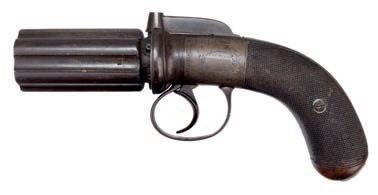
(1)
£200 - £300
156* Pistol. An early 19th century percussion belt pistol by C Hebbert & Co, London, the 19 cm octagonal sighted barrel engraved ‘London’, dolphin engraved hammer and sidelock engraved ‘C Hebbert & Co’, foliate engraving, fully walnut stocked with chequered grip, vacant escutcheon, steel butt cap with hinged cap compartment, engraved trigger guard and swivel ramrod and belthook, action in good working order, some old loss of stock near the grip, overall length 36.5 cm

(1) £300 - £500

158* Powder Flask. A 19th century copper powder flask, bag shape form embossed with a revolver, the brass top with sprung nozzle, 12 cm long, together with an identical powder flask
See Riling (Ray), The Powder Flask Book, page 300 for similar examples.
(2) £200 - £300
159* Powder Flask. A collection of Victorian copper and brass powder flasks, including a Braziers Improved flask embossed with leaves and scrolls, four steel rings and brass graduated primer, 21 cm long, a Sykes Patent bag shape flask, one side flat for use in pocket, 20.5 cm long, an oval flask with reeded decoration, two brass rings and graduated primer, 17 cm long, plus three other powder flasks by J.W. Hawkesey (one with a large split to the seam)

(6) £200 - £300
157* Pistol. A Victorian double barrel percussion pistol by Clayton of Lymington, the 9.5 cm barrel engraved ‘Clayton Lymington’ along the top, dolphin engraved hammers, foliate engraved casing, rounded and chequered walnut grip with vacant silver escutcheon, action in good working order, overall length 23.5 cm

(1) £300 - £500
160* Powder Flask. A horn powder flask, engraved ‘F Maddock Castel Yarde Dublin 1685’, screw top and oak base with brass nails, 20 cm long


The engraving does not appear to be in the 17th century style, sold as seen and not subject to return.
(1) £200 - £300
161* Powder Flask. A Victorian copper and brass novelty powder flask, of dolphin entwined form the brass top with sprung nozzle, minor split to the seam, 13 cm long


Most of these flasks were made by Bartram, this example is unnamed.
(1) £100 - £150
162* Powder Flask. A Victorian copper powder flask by James Dixon & Sons circa 1854, Sheffield, of gun stock form with kite registration mark and numbered 94923, the brass top with graduated charger and stamped James Dixon & Sons, Sheffield, 22 cm long, outside spring broken inoperable but no splits to the casing
See Riling (Ray), The Powder Flask Book, page 413 for further examples.
(1) £100 - £150
Lot 158 Lot 159 Lot 161 Lot 162163* Powder Flask. A Victorian Dixon & Sons copper and brass powder flask, of bag shape form embossed with a vignette of a huntsman and hound with dead stag on horseback, white metal graduated primer and stamped Dixon & Sons Patent, 19.5 cm, together with three other powder flasks decorated with game, including an early example by G & J.W. Hawksley circa 1840, embossed with dead game, 21 cm (one flask with splits to the seam and missing steel clip)
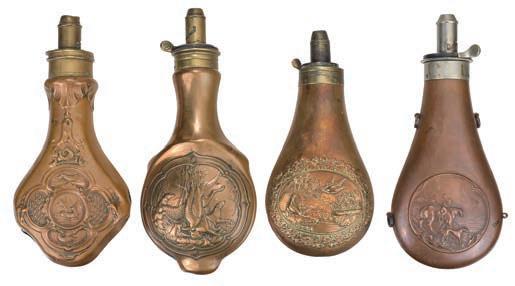
(4) £100 - £150
164* Powder Flask. A Victorian Sykes Patent ‘Lanthorn’ horn powder flask, of bag shape form, with white metal graduated primer, and steel sprung nozzle, stamped Sykes, 21 cm, together with another lanthorn powder flask, brass graduated size primer, 20 cm

(2) £200 - £300 Lot 166
165* Powder Flask. A Victorian cow horn powder horn, a good curved example with white metal top stamped Patent, the base with a bone final, 26 cm long, together with three other powder horns including one with steel mounts, 32 cm long

(4) £200 - £300
166* Revolver. A 19th century Belgian six-shot 7 mm self cocking pepperbox revolver, the 5 cm barrel with foliate engraving, folsing trigger, screw-in ejector in butt, walnut grips, overall length 13 cm

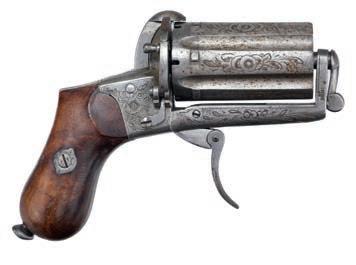
(1) £200 - £300
167* Revolver. A 19th-century Belgian six-shot revolver, the 6.5 cm circular barrel with cylinder stamped with Liege proof marks, folding trigger and ivory grips, overall length 19 cm CITES submission reference available upon request.
(1) £100 - £150
170* Revolver. A 19th century American Colt .36 Police SA revolver, matching serial numbers 13001, 13.5 cm barrel engraved ‘Address Col Saml Colt New York U.S. America’, the cylinder stamped ‘Pat Sept 10th 1853’, plain wooden grips, action in good working order, overall length, 28.5 cm

(1) £700 - £1,000

171* Sporting Gun. A Victorian percussion double barrel shotgun by John Charles Reilly, London (numbered 7902) circa 1854, the 75 cm barrels with Damascus twist figuring, inscribed ‘J.C. Reilly, New Oxford Street, London’, the sidelock, trigger guard and hammers engraved with foliate scrolls, walnut stock inset with silver escutcheon, with ramrod, in good working order, overall length 118 cm

(1) £150 - £200
168* Revolver. A Belgium 6-shot ‘Bulldog’ revolver circa 1890, nickel-plated numbered 3537 with 40 mm barrel, folding trigger and cylinder with Liege proof marks, chequered walnut grip, action working, overall length 15.5 cm


(1) £200 - £300
169* Revolver. An American Colt .30 New Line five-shot revolver, number 10665, the 5 cm barrel engraved ‘Colt’s PT.F.A. Mfg Co, Hartford. C.T. U.S.A.’, etched on barrel ‘Colt New 30’, blued steel, wooden grip, action in good working order, overall length 15 cm
(1) £300 - £500
Lot 170
(1) £200 - £300
172* The Shotgun Cartridge. An impressive display of shotgun cartridge cases circa 1930-85, presented in a glazed frame, frame size 72.5 x 70 cm173 Davison’s Nile Medal 1798, gilt bronze, reverse contemporarily engraved ‘Donald Blair’, 47 mm diameter


The medal was issued in four types, gold (Nelson and his captains), silver (junior officers), gilt-bronze (petty officers) and bronze (ratings). It was struck at Matthew Boulton’s factory in Soho Birmingham and commemorates Nelson’s victory at the mouth of the Nile on 1 August 1798. His prize agent Alexander Davison celebrated the victory by having these medals struck, his name appears around the edge of the medal.
(1)
174* A Gwalior Star pair to Lieutenant C. Carter, 58th Native Infantry and 7th Cavalry Pioneers
Punniar Star 1843 (Ensign C. Carter 58th Regt Native Infantry), original hook suspension removed and replaced with a straight bar Punjab 1848-49, 2 clasps, Chilianwala, Goojerat (Lieut. C. Carter, 58th N.I. 7th Cy Pioneers), minor edge bruise to second but generally good very fine, displayed in a period fitted leather case

(2)
Each lot is subject to a Buyer’s Premium of 20% (Lots marked * 24% inclusive of VAT @ 20%)
Crimea 1854-56, 1 clasp, Sebastopol (2559 Enoch Sparrow 48th Foot), contemporarily engraved and regiment worn, Turkish Crimea, Sardinian issue ‘No 2559 Enoch Sparrow 48th Regt’, contemporarily engraved, Victorian Army Long Service (2559 CrSergt Enoch Sparrow, 48th Regt), 1st and 2nd good fine, 3rd very fine, presented in a display case with Sergeant’s stripes and related cloth badges
Enoch Sparrow is recorded as being a Chelsea Pensioner in 1871. (1) £300 - £400
176 Indian Mutiny 1857-58, 4 clasps, Delhi, Relief of Lucknow, Lucknow, Central India (Store Lascar Luximon Rowjee.), Indian Army impressed naming, nearly extremely fine An unusual medal having 4 clasps (unconfirmed). (1) £1,000 - £1,500


177* A ‘Shangani Patrol’ British South Africa Company Medal to Corporal Harry Kinloch, killed in action alongside Major Wilson in the dramatic ‘Wilson’s last stand’, 4 December 1893


British South Africa Company Medal 1890-97, reverse Matabeleland 1893, no clasp (Corpl Hy G. Kinloch. Salisbury Horse), with memorial stripe to the ribbon, renamed in engraved san serif capitals
Corporal Harry Graham Kinloch was born in Norwood, Surrey in 1863, he was educated at Harrow and Trinity College, Cambridge, he served with “B” Troop Salisbury Horse in Mashonaland circa 1891. He was one of 34 soldiers killed in action against the Matabele on the Shangani River on 4 December 1893. The Shangani patrol, comprised 34 soldier in the service of the British South Africa Company. They were ambushed and annihilated by more than 3000 Matabele warriors during the First Matabele War in 1893. Led by Major Allan Wilson, the patrol was attacked on the Shangani River in Matabeleland, Rhodesia. The dramatic action is often referred to as ‘Wilson’s Last Stand’. (1) £500 - £800
 175* A group of three Crimea medals to Colour Sergeant Enoch Sparrow, 48th (Northamptonshire) Foot
175* A group of three Crimea medals to Colour Sergeant Enoch Sparrow, 48th (Northamptonshire) Foot
178* Queen’s South Africa 1899-1901, 7 clasps, Relief of Kimberley, Paardeberg, Driefontein, Johannesburg, Diamond Hill, Belfast, South Africa 1901 (2623 Pte W. Carter, 2nd D. of. C. Lt Infy), good very fine Clasps confirmed.
(1) £100 - £150
180* Five: Driver C.T. Harris, Royal Army Service Corps
1939-1945 Star, France and Germany Star, War Medal, Territorial Efficiency Medal, G.VI.R., with ‘Territorial’ scroll suspension (T75793. Dvr, C.T. Harris. R.A.S.C.), extremely fine, unmounted and presented on a card display with ribbon bar, the display also with a British War Medal (76968 Dvr. C.F. Hardwick R.A.), extremely fine and attractively toned and other items
C.F. Hardwick was wounded on the Western Front.
(1) £80 - £120
181* Five: Private R.F. Wagstaffe, Leicestershire Regiment
1939-1945 Star, Burma Star, Defence and War Medal, Territorial Efficiency Medal, G.VI.R., ‘Territorial’ scroll suspension (4859607 Pte. R.F. Wagstaffe. Leicesters.), very fine, swing mounted as worn
Four: 1939-1945 Star, Africa Star with North Africa 1942-43 clasp, Defence and War Medal, extremely fine, in named card box of issue
Four: 1939-1945 Star, Africa Star with 8th Army clasp, Italy Star, War Medal, good very fine swing mounted as worn
Four: Africa Star, Italy Star, Defence and War Medal, with miniature dress awards, good very fine
Three: Africa Star with 8th Army clasp, Defence and War Medal, extremely fine in named card box of issue with transmission slip (16) £100 - £150
179* Queen’s South Africa 1899-1902, 2 clasps, Transvaal, South Africa 1902 (7211 Tpr: A.E. McConkey. N.Z.M.R. 9th Cont:), extremely fine
Albert Edgar McConkey served during the Boer War with the 9th Contingent, New Zealand Mounted Rifles. The unit sailed on 12th March 1902, two days after Lord Methuen’s disaster had been announced. On 4 June, four days after peace was concluded, the 9th contingent had the misfortune to lose Lieutenant Robert M’Keigh, killed, and Lieutenant Henry Rayne, wounded, near Vereeniging. Firing had been started under some misconception. The unit sailed for home in July 1902. 1076 medals were issued to this unit.
(1) £150 - £200
182* An impressive group to Captain Walter Beale Cornock, Gloucestershire Yeomanry who famously quoted “I would rather die a man’s death, than have to feel that I had failed to go through with it or taken a cowardly advantage of a chance to get out of it. Not that I expect to be killed, I have every hope of coming through, providence has been very good to me thus far, thankfully I don’t mind much either way. I think we are unnecessarily afraid of death - I’m only worried because of the pain it would cause to all you at home”
1914-15 Star (1906 Pte W.B. Cornock. Glouc Yeo), British War and Victory Medals (Capt. W.B. Cornock.), India General Service 190835, G.V.R., 1 clasp, Afghanistan N.W.F. 1919, unnamed, good very fine and mounted on a ribbon bar for wear, with dress miniature awards, a silver prize medal for the “Congreve Challenge Cup” won by the recipient on 17 August 1917, a Gloucestershire Regiment “sweetheart” brooch, regimental cap badge, trench art brass sword mount engraved with the recipients record of service from 1914 to 1922
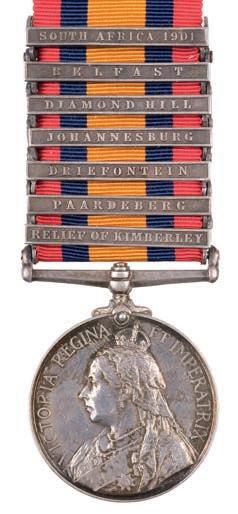


Original documents including record of service, field medical card, newspaper cutting noting Cornock’s promotion to Lieutenant, a humorous manuscript menu card for the Lewis Gun School Break Up Dinner, Le Touquet dated 15 December 1916, offering several courses including ‘Fish, Whiting A La Somme, “Hun”ion Sauce”, the reverse signed by attendees including Cornock, a letter from his mother dated 21 July 1915, several letters written by the recipient to his father, 1917 and 1918, a typed account of the recipients experience in Spring 1916 whilst serving with the 12th Bn Gloucestershire Regiment in Villars au Bois, near Mount Eloi “it was intensely cold, the air filled with snowflakes as the men went over the top, sheltered to some extent by a creeping barrage”, several photographs of the recipient including a portrait of the recipient in WWI service dress, three signed letters from Vera Brittain (1893-1970) WWI nurse and author of the 1933 bestseller “Testament of Youth” which recounted her experiences during WWI. The letter thanks Cornock for his letter regarding the Testament of Youth, also letters written from Sir Philip Gibbs (18771962) author and WWI reporter and Sir Harold Boyce MP, newspaper cutting reporting Cornock coming to the aid of an employee who had been injured in a road traffic accident, Cornock saved his life by giving blood, another folder containing numerous WWI period letter to and from his parents, three manuscript journals kept by Cornock commencing 1913 and recording his complete WWI service with many extracts harrowing and emotive, writing about his time in Gallipoli, Sulva Bay he recollects “I had been told that men always messed their breeches the first time under fire but this proved only to be a rumour, at any rate this unfortunate calamity did not occur in my case”,
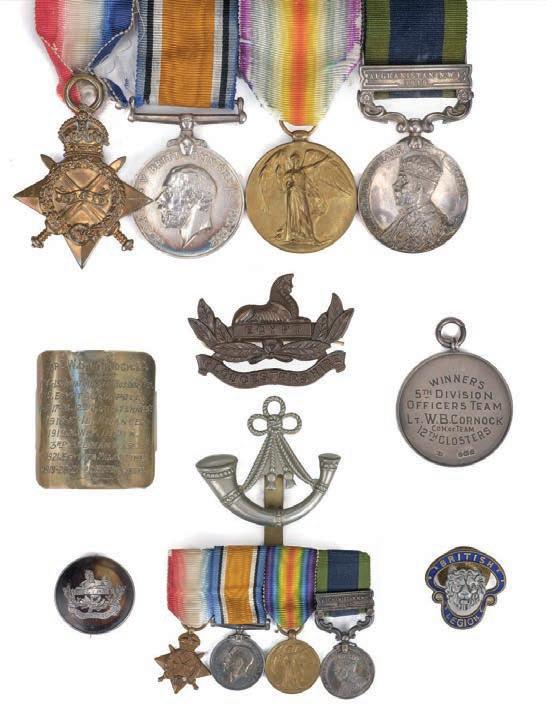
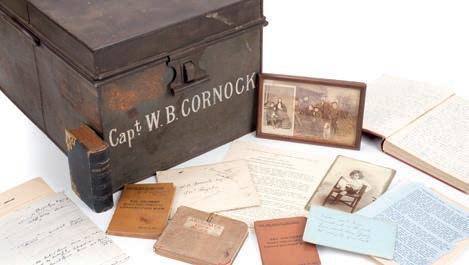
On October 8th 1915 he writes “We relieved the Rough Riders in the front line by night, I was put on guard at once. The Turks were about 100 yards away. I found it very exciting, interesting but they were well dug in, once seldom got a chance of a target. There were many dead bodies between the two lines, they smelt- the flies were very trying, masses of them fierce biting things whilst centipedes and scorpions in the trenches were minor evils”.
Moving to the Western Front he writes of Vimy “Next day the 5th we got hell, heavily shelled all day. The enemy seemed to have the trenches taped. Their aeroplanes come up and down the lines, our planes are conspicuous by their absence, we had not achieved air supremacy in those days. The support from the Canadian Artillery behind us was lamentable, they seemed to be firing all the dud stuff. Walking up the trench I found two men buried, one man’s head lying in the trench, severed clean from the body. With the help of sergeant Whittacre I got one of the buried men out alive, the other was dead, we had many casualties and were very demoralized” many pages supported by snaps shot size photographs
A huge family archive including 8 manuscript memoirs by his father A.W. Beale dated 1891 but recollecting various historic occasions for example a visit with his father to St James Park. His father would often take him to see the changing of the guard and for long walks, Beale takes up the story “I remember an incident which though it made little impression on me then I have always been proud of since - The Duke of Wellington was riding down St James Street, saluted by everyone high and low and mechanically returning their salutes when he seemed suddenly to see my father and instead of merely saluting him in the same fashion he rode up to where we were standing and stooped down shaking hands and stayed some time taking with my father and was this not talked of among the soldiers it flew all over London and whenever Father and I went to any of the Barracks after this which we so often did he seemed to be received with double respect. Father showed me a wound in his right breast and side where a bullet had gone through him at the Battle of Waterloo and told me that he never knew he was wounded the excitement of battle being so great till the Duke of Wellington cried out Lieutenant Beale you are wounded.” He went on to recount an incident that in his mind was the finest exemplification of true courage that he could imagine - “that a soldier in the ranks whispered to another while the Duke was passing in front of them and just about to enter into an engagement with the enemy - Comrade the Duke looks pale and frightened at which the Dule turned round and retorted - yes my man and the Duke feels so frightened so much that many of you men would not dare to be here if they felt as he does”. Cornock’s grandfather, Captain Thomas Griffin Beale the writer A W Beale himself recounts travels to the Crimea and seeing Florence Nightingale at Scutari. The whole collection contained in Captain W.B. Cornock’s military chest
Captain Walter Beale Cornock was born Churchdown, Gloucestershire in 1892, he was educated at Wycliffe College, Stonehouse, Gloucestershire, he joined the Royal Gloucestershire Hussars as a Private in 1906, he served in Gallipoli as a Trooper from April 1915 before returning to England as a result of dysentery in December 1915. Once recuperated he was attached to the Cadet Corps Officers at Magdalen College, Oxford in June 1916 and then served on the Western Front with 12th Bn, Gloucestershire Regiment from November 1916, he was promoted to Lieutenant in May 1917 and Captain in August, in September 1918 he embarked for India and served with the 31st Punjabis before being stationed on the North West Frontier at the time of the third Afghan War with the 1/30th Punjabis, Cornock and remained in service until 1922 retiring with the rank Captain.
(an archive) £1,200 - £1,500
183* An India General Service Medal to Flying Officer Leslie Richard Newcombe, Royal Air Force later Prison Governor for Wormwood Scrubs at the time the infamous spy George Blake escaped India General Service 1908-35, G.V.R., 1 clasp, North West Frontier 1930-31 (F/O. L. Newcombe. R.A.F.), good very fine, with copied photographs of the recipient and research
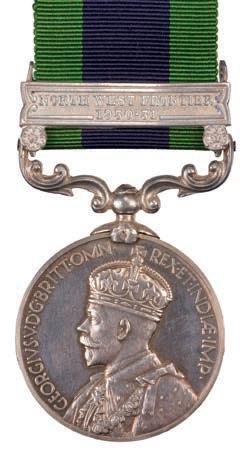
Flying Officer Leslie Richard Newcombe (1902-82) was born in Southampton, he attended Southampton Boys College and High School between 1914 and 1918 after which he undertook an apprenticeship with Eastleigh Locomotive Works. He joined the RAF in September 1926 with 11 Squadron and qualified as a Flying Officer with the Squadron stationed at Risalpur, Pakistan in April 1928. He transferred to the RAF Reserve in 1931. Newcombe joined the Prison Service in 1936 and was Housemaster (Acting Governor) at H.M. Borstal Service, Nottingham, after a period of Governorship at Bedford, Exeter and Durham he joined Wormwood Scrubs in September 1964. Newcombe was the Governor during the famous escape of George Blake on 22 October 1966.

George Blake (1922-2020) was a spy with Britain’s Secret Intelligence Service (MI6) and worked as a double agent for the Soviet Union. He became a communist and decided to work for the MGB while a prisoner during the Korean War. He was discovered in 1961 and sentenced to 42 years in prison. He escaped from Wormwood Scrubs prison in 1966 and fled to the Soviet Union.
Shortly after the escape Newcombe retired from the prison service, he resided in Ringwood, Hampshire.
(1) £400 - £500
184* Iraq. A group of three medals, comprising, Iraqi Flood Rescue Medal 1954 (Nut Al-Inqith), Iraqi General Service Medal 1926-58 (Nut Al-Awal), Iraqi Police General Service Medal 1959 (Nut lil Shurta Al-Khimat Al-Aama), extremely fine
Awarded to those who assisted in rescue operations in the context of the massive flooding of the Tigris and Euphrates Rivers in 1954. It was as a direct result of these floods that the major flood-control and irrigation works at Samara (on the Tigris) and at Ramadi (on the Euphrates) were opened in 1956

(3) £150 - £200
185* Medal Cases. A collection of medal cases, including DSC (2), British Empire Medal (3), C.B. Mily, D.S.Cross (2), D.S.O., O.B.E. and other cases
(15) £200 - £300

186* A “Dunkirk Evacuation” DSC Group to Captain W.O. Young, DSC, Merchant Navy Distinguished Service Cross, G.VI.R. by Garrard & Co, reverse officially dated ‘1940’ in Garrard box of issue
British War and Mercantile Marine Medal (William O. Young)
1939-1945 Star
Atlantic Star
Italy Star
War Medal, very fine and better, sold with a folder of extensive research
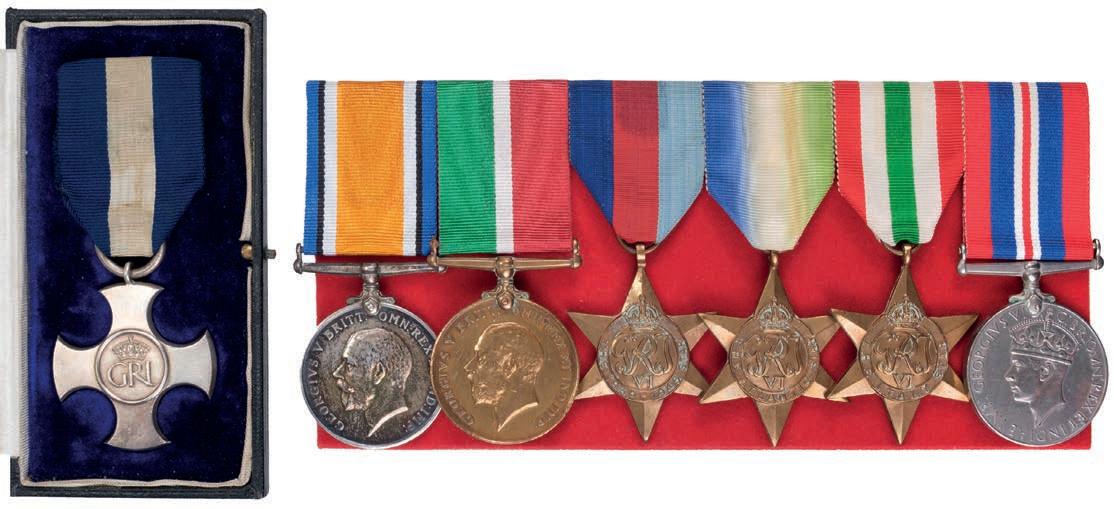
William Oswald Young (1895-1967) was born in Sunderland Co. Durham, he went to sea and joined the Prince Line Ltd as an apprentice onboard S.S. Orange Prince and was onboard the ship when it was sunk in the Mediterranean by the German submarine U-34. The ship had been on a voyage from Avonmounth to Mudros with a general cargo, 3 crew were lost.


Young was a crew member on various ships of the Prince Line and sometime prior to the outbreak of WWII he joined the Constantine Shipping Co as Master. During 1940 he was the Master of the S.S. Levenwood, a 803 ton coaster armed with a 12 pounder, a Lewis and Bren gun and was transporting stores for the army.
On 31 May 1940 he was ordered across to Dunkirk to help with the evacuation. Two miles east of the piers at noon, the Levenwood was attacked by German aircraft, the first shell from her 12 pdr, manned by a Merchant Navy gunner hit one of the attacking aircraft which crashed into the dunes. The speed of the evacuation from the sands was very slow and a naval officer asked Captain Young to put his ship onto the beach in a desperate attempt to speed things up. Blowing the Levenwood's forepeak tank, Young beached the ship in 8 foot of water and the system of ropes and pulleys was arranged between ship and shore. The ship remained in position until Young got the Levenwood safely off the beach and returned to England. The ship had been frequently attacked by German aircraft. The London Gazette of 16 August 1940 announced the award of DSC to Captain Young and a DSM to his fireman R. Moody, who had spent most of his time in the water helping and coaxing soldiers through the sea and breaking surf to the boats. Young remained with the Constantine Shipping Co for the remainder of his career until his retirement in 1957.
(7) £1,500 - £2,000
187* An impressive “North Russia” DSC group to Chief Officer W.R. Holt, OBE, DSC, Royal Navy, for fortitude, seamanship & endurance in taking Merchantmen & Royal Fleet Auxiliaries to North Russia through heavy seas & in the face of many attacks by enemy aircraft & submarines
The Most Excellent Order of the British Empire O.B.E. (Military) Officer’s 2nd type breast Badge
Distinguished Service Cross, Garrard & Co, London 1942, reverse officially dated ‘1943’

1939-1945 Star
Atlantic Star
Burma Star with Pacific clasp
War Medal
Korea 1950-53, Britt: Omn type (W.R. Holt O.B.E., D.S.C.), United Nations for Korea, extremely fine and presented on a red velvet board, sold with a folder of research which includes copied photographs of ships, original documents including British Seaman’s Identity Card, letter of congratulations from the Admiralty for the OBE dated 26 June 1946, invitation to Buckingham Palace dated 18 April 1944 plus
William Ronald Holt was born in Rochdale in 1902, he joined the Royal Fleet Reserve Auxiliary in 1929 and rose to Chief Officer. Holt served in several oil tankers during WWII including Francol from December 1939 to February 1940, Gray Ranger from 16 September 1941 to 5 October 1942. The Gray Ranger took part in the following convoys to Russia, PQ15, PQ17, PQ18 and QP14. The London Gazette of 16 February 1943 announced awards “For fortitude, seamanship & endurance in taking Merchantmen & Royal Fleet Auxiliaries to North Russia through heavy seas & in the face of many attacks by enemy aircraft & submarines”. Amongst the DSCs awarded was Holts.

There appears to be no recommendation for Holts DSC, however the Master of the Gray Ranger, Captain Gausden was awarded a DSO and the likelihood is the recommendation reflects Holts DSM.
“This ship performed the most magnificent work, oiling without a break for 9 days, every daylight hour, despite continual air & submarine attacks. Every ton of oil was utilised, & the Destroyers received speedy & cheerful service continuously during the whole operation. To my great regret “Grey Ranger” was torpedoed after her immediate work had been completed”.
Holt later joined Wave King when she sailed to join the war against Japan. As part of Task Force 112 (The Fleet Train), of the British Pacific Fleet, Wave King was involved in nearly all the major operations of the BPF and on 31 August 1945 dropped anchor in Tokyo Bay.
Holt received his OBE whilst serving in this ship, published in the London Gazette 11 June 1946 “For distinguished services during the war in the Far East”. Post-war service saw Holt in the Korean War where he served as Master of the RFA in Brown Ranger and his final voyage was completed on 14 November 1957.
(8) £1,000 - £1,500
189* WWII "Capture of Termoli" DSM group to Petty Officer E.G. Ham, MID, DSM, Royal Navy, in the face of 9 dive bombing attacks and shelling by enemy shore batteries he manned a gun and by his calmness set a fine example
Distinguished Service Medal, G.VI.R. (Temp. P.O. E.G. Ham. D/JX. 130688)
1939-1945 Star
Atlantic Star with France & Germany clasp
Africa Star
Italy Star
War Medal with MID oakleaf
Naval Long Service & G.C., G.VI.R. (JX.130688 E.G. Ham. P.O. H.M.S. Copra.), good very fine, sold with a folder of research
Provenance: Dominic Winter Auctioneers May 2016 (lot 1214), the stars are a later addition.
DSM: London Gazette 25.1.1944
'For gallant and distinguished services in the assault on, and capture of Termoli in the face of heavy opposition from the enemy'.
MID: London Gazette 11.3.1941
'For good services of the coast of British Somaliland'. Sub-Lieutenant The Marquis of Milford Haven, RN of HMS "Kandahar" has submitted that "Ernest Gilbert Ham, Leading Seaman D/JX 130688 should be awarded for his service during the Army evacuation from Berbera on the night of 17/18th August for prompt action and good seamanship when, as coxswain of the motor cutter, he rescued soldiers and the crew of another motor cutter which had been swamped on Berbera Harbour in a short steep sea with force 6 wind blowing", HMAS Hobart Association (Queensland Division) refer
188* Medals. General Service 1918-62, G.VI.R., 1 clasp, Palestine 1945-48 (EC.13105 Pte. K. Koogotsitse. A.P.C.); Territorial Efficiency Medal, G.VI.R, with ‘Territorial’ scroll suspension (S/6970193. Pte. D.W.J. Skinner. R.A.S.C.); 1914-15 Star (M2-05722 Pte. S.F. Garrett. A.S.C.); British War Medal (2. Lieut. R.M. Geldart.); Victory Medal (2) (32016 Pte. A. Hanstock. Y & L.R./ 166760 J.C. Cork. S.P.O. R.N.); India General Service 1936-39, 2 clasps (14914 Sepoy Nazar Singh, 1-11 Sikh R.) together with a white metal prize medal presented to Lieutenant W.G. Rennie, XII R L for Faithful Service as Polo Marker Chinaman dated 20 October 1887, RAF cufflinks, sweetheart badges and other items

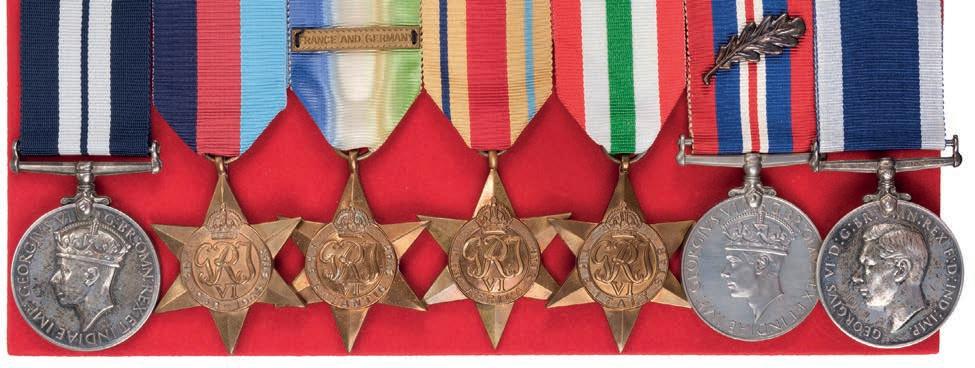
(a small box) £200 - £300
Ernest Gilbert Ham was born in Shepton Mallet, Somerset in 1912, he joined the Royal Navy in 1927 (Boy 2nd Class), and after completing training in HMS Marlborough he joined the brand new cruiser HMS Shropshire in September 1929 and served in various ships before joining HMS Kandahar at the outbreak of WWII. He remained with the ship until it was sunk on 20 December 1941 after hitting a mine attempting to aid HMS Neptune. The crew had to swim across to HMS Jaguar as the sea was so rough, there were 174 survivors, and 67 crew were lost. Ham was awarded a MID (London Gazette March 1941) "For good services in operations off the coast of Somaliland".
HMS Kandahar had been taking part in the evacuation of the Army from Berbera in August 1940.
After returning home on survivors leave Ham served ashore for 5 months before joining HMS Dinosaur and then being posted to the Mediterranean to take part in the landings in Sicily and Operations Baytown & Ferdy, the 8th Army landings in Calabria during September 1943.
Ham earned his DSM for his part in Operation Devon which was the Commando assault and capture of Termoli on the East coast of Italy in October 1943. The recommendation for this award reads "Petty Officer Ham as Flotilla Coxwain showed devotion and courage of the highest order in the face of 9 dive bombing attacks and shelling by enemy shore batteries. Again and again, he manned a gun and by his calmness set a fine example. Petty Officer Ham is on my Flotilla Staff and has on all occasions shown selflessness in an emergency and coolness in the face of the enemy. In Operation Devon his duties on my staff often entailed additional risks which only appeared to add to his stature and bring out his fine qualities."
(7) £1,000 - £1,500
190* RAF Medals. An O.B.E. group to Group Captain W.G. Parry, Provost Marshal, RAF
The Most Excellent Order of the British Empire, O.B.E. (Military)
Officer’s 2nd type breast badge, silver-gilt
1939-1945 Star
Italy Star
Defence and War Medals




General Service 1918-62, E.II.R., 1 clasp, Malaya (Gp. Cpt. W.G. Parry. R.A.F.)
1953 Coronation Medal, extremely fine and court mounted for wear, with copied service paper and research
William George Parry was born in 1910, he enlisted as an aircraft hand u/t service police in July 1940 and was mobilised two months later. After spending six months at 48 MU, he re-mustered as a service policeman. He spent 15 months at RAF Filey (now Butlin’s Camp) and after attending the Officer School at Cosford, was commissioned. For the next 12 months, he served with the RAF Police HQ and in January 1944 went to HQ Mediterranean Allied Air Forces as the Deputy Assistant Provost Marshal. He returned to the UK in October 1946 and for the next 8 years worked in numerous appointments in the Air Ministry, the final year as an acting group captain. In February 1955 he became the Chief Provost Marshal at HQ Far East Air Force at Changi. He was back in the Air Ministry in December 1956 as Deputy Provost Marshal (UK). In April 1959 he returned to HQ FEAF as Command Provost Marshal and OC 4 Police Wing. In January 1962 he became Officer Commanding RAF Debden (the police depot) and retired at his own request on 7 September 1963.
(7)
£500 - £600 Lot
191* A WWI ‘Naval Division’ group of three to Able Seaman Leopold Clark, Collingwood Battalion, Royal Navy Volunteer Reserve, interned in Holland and saw the war out in a POW camp 1914 Star and clasp (L.4/2530 L. Clark, A.B. R.N.V.R. Collingwood Bttn, R.N.D.)
British War and Victory Medals (L.4-2530 L. Clark. A.B. R.N.V.R.), very fine, presented in a period wooden frame, glazed, frame size 29 x 33 cm
Leopold Clark was a native of Clapton, London born in 1887, he joined the Royal Naval Volunteer Reserve on 29 September 1911 and served in HMS Natal (Able Seaman) from 1913, he was serving in HMS Pembroke I from August 1914 before being interned in Holland, he spent the remainder of the war in a POW camp and was released in 1919.
(3) £300 - £400
192* Three: Private F. Hampshire, Gloucestershire Yeomanry
1914-15 Star (2356 Pte. F. Hampshire. Glouc. Yeo.), British War and Victory Medals (2356 Pte F. Hampshire. Glouc. Yeo.), extremely fine, with two RGH cap badges, contained in an old jewellery box, with a letter addressed to the recipient whilst serving with the Egyptian Expeditionary Force in 1918, dealing his mothers death, RGH photographs, sweetheart embroidered postcards plus a group of three WWII medals comprising 1939-1945 Star, France & Germany Star, War Medal, extremely fine and mounted as worn and other items Frank Hampshire served in the Egyptian Theatre from 12 September 1915.
(1) £150 - £200
193* Three: Private G Wall, 19th Hussars
1914 Star (6183 Pte G. Wall. 19/Hrs.), British War and Victory Medals (6183 Pte. G. Wall. 19-Hrs.), good very fine and attractively toned See lot 70 (the recipient’s son).
(3) £100 - £150
194* Ubsdell Family. Lieutenant James Eads Ubsdell, Somerset Light Infantry who died of fever on 13 October 1896 at Keila Drooch India General Service 1895-1902, VR, 1 clasp, Relief of Chitral 1895 (Lt. J.E. Ubsdell, Som.L.Infy), extremely fine, contained in an ebony box which was requested by his mother after his death as a memorial, the lid with a silver plaque with London 1902 hallmark engraved ‘In Affectionate Remembrance of my dearly loved son James Eads Ubsdell who died at Drosh, Chitral 13th October 1896 Aged 27 years’, silver corners and key plate, the hinged lid enclosing a fitted lift out tray with the personal effects of the recipient including his campaign medal, silver 13th Foot cap badge, belt buckle, silver sovereign case and yellow metal pocket knife each engraved with the initals ‘J.E.U.’, tunic buttons, Southampton Yacht club enamel badge and other items, the lower section with a large collection of original documents, telegrams, letters including letters from Ubsdell to his family etc including a printed and manuscript letter titled ‘circular no 238 Divisional Transport office Late Chitral Relief Force Rawal-Pindi, 19th November 1895’ in which the divisional transport officer thanks the transport officers on the conclusion of the operations of the Chitral Relief Force, military educational documents including one for qualifying as a Russian interpretor dated 23 April 1890, a passport signed by the the Marquess of Salisbury, Earl of Salisbury dated 1888 with several Russian stamps, vellum death certificate dated 24 August 1897, a manuscript list of effects sent to his mother including many of the items in this box, a copy letter to his mother from Lt Col A.C. Borton giving condolence, an original telegram inscribed ‘regret that he died suddenly fever, thirteenth October Drosh, Colonel Somerset’, black and white photographs of Ubsdell’s grave stone, plus a large watercolour portrait of Ubsdell painted by T.M. Heaton in 1912, as a tribute commissioned by his mother, Ubsdell seen in full scarlet uniform of the Somerset Light Infantry, period gilt frame, glazed, frame size 78 x 83 cm, a handcoloured photograph of Ubsdell in Eton uniform, presented in a gilt metal frame with Eton Register, a humerous drawing of Ubsdell by Marcel Pil 1893, in a period carved wood frame, frame size 22 x 17 cm and other items, a good original family archive
Captain James Eads Ubsdell, Somerset Light Infantry (1868-1896), was born in Southampton and educated at Eton. He served with the regiment in India and was a transport officer during the Relief of Chitral in 1895. Ubsdell died of fever at Drosh, India on 13 October 1896. His headstone at Drosh Cantonment is inscribed ‘In memory of Captain James Eads Ubsdell, The Prince Alberts Somersetshire Light Infantry, who died at Killa Drosh whilst employed as Transport Officer 13th October 1896, aged 28 years. Deeply mourned by his parents and brother officers’. See lot 195 for Lieutenant Colonel Thurlow Richardson Ubsdell (brother).
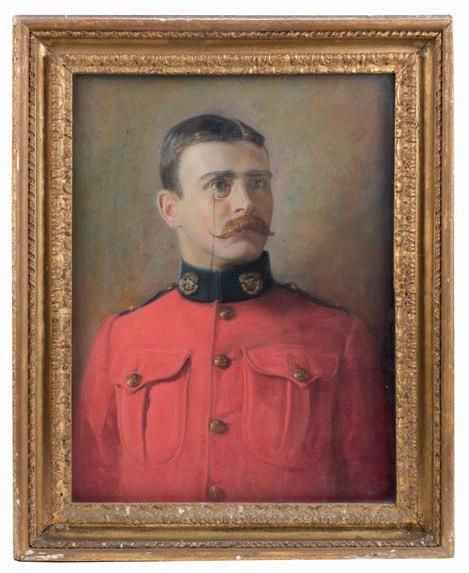
(1) £700 - £1,000



195* Ubsdell Family: Lieutenant Colonel Thurlow Richardson Ubsdell, DSO, Royal Horse Artillery
Distinguished Service Order, G.R.V., silver gilt and enamel
Queen’s South Africa 1899-1902, 4 clasps, Cape Colony, Orange Free State, Transvaal, South Africa 1901 (Lieut T.R. Ubsdell, R.F.A.), 1914 Star and Bar (Capt:T.R. Ubsdell, R.F.A.)
British War and Victory Medals (Major T.R. Ubsdell) with MID oakleaves
1935 Jubilee Medal
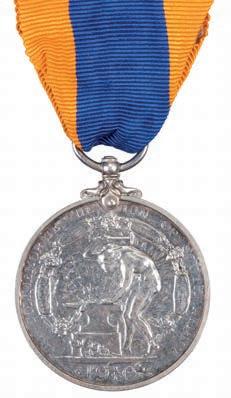
France. Légion d’honneur, good very fine or better, lacquered with dress miniature awards and cases of issue
Silver desk stand presented to Ubsdell from the officers R.A. mess Rawal Pindi April 29th 1909 (and so inscribed), with two silver top ink bottles with the initials T.R.U., the stand 27 cm long, approximately 747g together with a box containing hundreds of letters from Lt Col Thurlow Richardson Ubsdell from the Western Front circa 1914 onwards, a large scrap album compiled by Ubsdell which covers his personal life and career in the army and at home, many photographs, including Ubsdell wearing his QSA medal, another of the 13th Battery receiving their medals at Nowgong, India, original documents such as commission certificate dated 21 May 1900 (2nd Lieutenant), mentioned in despatches certificates etc, Secret blue report No4 titled ‘Report on the Armed Forces of Germany and the work the Effective SubCommission of Control’, the cover inscribed ‘T.R. Ubsdell’, two folders full of documents titled ‘Political Parties in Germany’, and ‘Revolution of March 12/13th 1920’ with a typed report for the Berlin Revolution on 13 March 1920, together with another group of medals to his son Major Edward Thurlow Hope Ubsdell, Somerset Light Infantry, killed on active service in a motoring accident in Germany, 10 November 1945 1939-1945 Star, Burma Star, Defence and War Medals, extremely fine and lacquered, both groups presented in a modern display frame, glazed, frame size, 49 x 35 cm
D.S.O. London Gazette 1 January 1918
M.I.D. London Gazette
14 January 1915
30 November 1915
7 November 1917
13 November 1919
Lieutenant Colonel Thurlow Richardson Ubsdell (1872-1955) was born in New York, America, he was the son of John Ubsdell who had emigrated to America in the late 1850s and was President of the Great Lakes Engineering Company, River Rouge (considered an outstanding naval architect and marine engineer), the family moved back to England in the 1870s and resided in Southampton, Ubsdell was educated at Rugby School and Jesus College, Cambridge before being commissioned in the Royal Artillery in May 1900, he served in the Boer War from 1901 with the 13th Battalion and was present at the Delhi Durbar on 1 January 1903, an original programme of the Durbar plus order of service is included with the lot, Ubsdell relinquished his commission in 1912 with the rank as Captain, he re-engaged for service at the outbreak of WWI and served on the Western Front with the 6th Division Royal Artillery from September 1914 until the end of the war, he was mentioned in despatches four times plus awarded the DSO.
In 1918 Ubsdell was appointed Summary Court Officer in Cologne, during this time, he tried over 5000 Germans and presided over a special court to try Spartacists charged with inciting Mutiny in the British Army and with a plot to murder General Plumer and other British Officers.
Between 1918-1920 he joined the “British Effectives’ Sub-Commission of the Control Commission or the Disarmament of Germany in Berlin as AAG and subsequently was President of the Berlin District Commission of Control for the Execution of the Military clauses of the Peace Treaty (Treaty of Versailles) and the Disbandment of the German Army, there are several pages of black and white photographs relating to General Foch accepting the German request for armistice, with relevant newspaper cuttings. Ubsdell served during WWII with the Home Guard from 3 June 1940 to 1 October 1942 (a certificate from George VI is included along with original ARP paperwork and photographs).
On 10 November 1945 his son Edward was killed in a jeep accident whilst serving in Germany, the album included in this lot has several black and white photographs of Edward and his family, a newspaper cutting reporting on the death, roll of honour plus a photograph of his grave. A wonderful and comprehensive family archive. See lot 194.
(1)
£1,500 - £2,000
196* Union of South Africa Medal 1910, unnamed as issued, extremely fine
A total of 551 medals were struck by the Royal Mint, and all issued unnamed although privately named medals do exist.
(1) £400 - £500
197* Walton (Izaak, 1593-1683). AE Memorial Medal, 1824. Obv: Half-length bust of Walton. By I. Avern. Rev: An angler leans mournfully against Walton’s tomb inscribed with memoriam. 35 mm, 23g, good very fine

(1) £150 - £200

198* WWII DFC group to ‘Mosquito Night Fighter’ Flight Lieutenant Johnny Haddon Downes, 604 Squadron who destroyed three enemy aircraft and later became the producer of the BBC show “Crackerjack” Distinguished Flying Cross, G.VI.R., reverse officially dated ‘1944’ with ‘Royal Mint’ case of issue
1939-1945 Star
Air Crew Europe Star
War Medal, extremely fine and swing mounted for wearing, enclosure from Buckingham Palace, and loose France and Germany Star plus two log books (which include aircraft photographs pasted in), telegrams, photographs including a group photograph of 604 Squadron with Mosquito behind and other original documents

DFC: London Gazette 3 October 1944
Acting Squadron Leader Denis Chetwynd Furse (62320), R.A.F.V.R., 604 Sqn
Flight Lieutenant John Haddon Downes (110132), R.A.F.V.R., 604 Sqn.
‘As pilot and observer respectively these officers have completed many sorties, some of them in most adverse weather. Their keenness and determination throughout has been of a high order. They have destroyed three enemy aircraft. John Haddon Downes (1920-2004) was born in Great Easton, Leicestershire. He was educated at The King’s School, Grantham. After training as a surveyor he joined the Royal Air Force Volunteer Reserve at the start of WWII. He was commissioned in October 1941 and became a Flight Lieutenant Navigator in Mosquito Night Fighters.

The log books included in the lot covers the period of 20 December 1940 to 6 April 1945 with a total of 592hrs20mins day flying and 421hrs25mins at night, log book two has the full operational record from 7 September 1941 to 23 December 1944.
Post-war service saw Downes take up a career in theatre as a stage manager for Ivor Novello’s King’s Rhapsody. In 1953 he joined the BBC as floor manager and was promoted to producer, and developed the live children’s television show Crackerjack, which he produced for 10 years.
(1) £2,000 - £3,000
199* A scarce and probably unique Inter-War 'Aden' DFM group to Corporal Henry 'Harry' Joseph Barber, Royal Air Force late Sick Berth Attendant, Royal Navy


Distinguished Flying Medal, G.V.R. (352222. Cpl. H.J. Barber. R.A.F.)
British War and Victory Medals (M.7857. H. Barber. S.B.A. R.N.)

Defence Medal
Cadet Forces Medal, G.VI.R. (Act.Flt.Lt. H.J. Barber. R.A.F.V.R.(T)), second and third little worn on the naming therefore, very fine and the remaining medals, good very fine and better, swing mounted for wearing, with Imperial Service Medal, E.II.R. (Henry Joseph Barber), extremely fine in Royal Mint case of issue, plus the recipients log book for the period of 15 March 1927 to 11 January 1929, approximately 10 black and white photographs including Royal Navy portrait, RAF tropical wear, the recipient standing next to aircraft with reconnaissance camera and high altitude flying apparel, aerial reconnaissance photograph etc, several original documents including National Identity Card, plus 15 larger black white photograph for Cadet Training, a great lot and first time on the market
DFM: London Gazette 15 March 1929
'In recognition of gallant and distinguished service rendered in connection with the operations in the Protectorate of Aden during the period June - August 1928' Henry Joseph Barber was born in Normanton, Yorkshire 1896, he joined the Royal Navy on 21 July 1914, he served in various ships as a Sick Berth Attendant including HMS Victory, Blake and Diligence where his character was described as "very good". Post-war service saw Barber join the Royal Air Force, where he trained as an observer-photographer and then as a gunner/bomber with 8 Squadron, being sent to the Aden Protectorate from 15 March 1927.
8 Squadron were sent to Aden in response to unrest and based at RAF Khormaksar where it continued in the air policing role. The squadron replaced its elderly DH9As with the new Fairey IIIF light bombers from January 1928. It flew against the Zaidi in February 1928 and against the Subaihi tribe, who were refusing to pay taxes and revolting, from January to March 1929. Operations against the Subaihi involved destroying crops with incendiary bombs and bombing villages after giving warning so they could be evacuated. The pressure eventually forced the Subaihi to sue for peace. the log book included with the lot includes training flights and operational sorties, with a total of 118 hours 25 minutes in Aden logged in DH9A aircraft and Fairey 111F aircraft between 15 March 1927 to 11 January 1929. During his long RAF service which ended in WWII as Commanding Officer of 168 (City of Leeds) Air Training Corps Squadron. The cover of the log book has been altered from Pilot to Air Gunner and the cover inscribed '8 Sqdn Khormakser Aden', a comprehensive account recording bombing and operational strafing raids.account recording bombing and operational strafing raids.

(6)
£3,000 - £4,000
200* Barnes (Barry). Short 184s by the River Tigris 1918, watercolour on soft card, signed lower left, 33 x 51 cm, together with five further watercolours by the same artist, comprising, Short 184 Floatplane over HMS Ark Royal 1918, 29 x 47.5 cm, Bristol Fighter, 1 Sqn, Australian Flying Corps Egypt 1918, 29.5 x 40 cm, DH90 1924 No 60 Sqn RAF Northwest Frontier 1920s, 45 x 34 cm, Short Sunderland over the South China Sea, 30.5 x 51 cm plus a doublesided watercolour, one side showing a Short Singapore over the Nile 1920s and the other an RAF fighter over a fleet, 34.5 x 52 cm, all unframed and therefore, easily postable
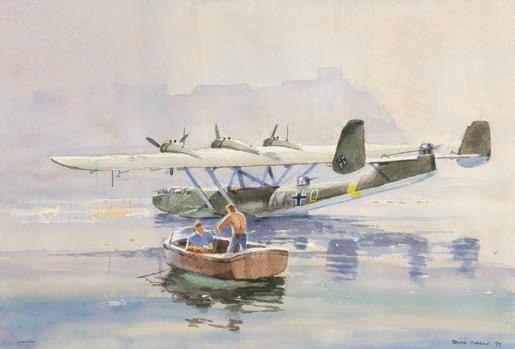

(6)
£200 - £300
202* Clarke (David). Dornier in the Med, watercolour on paper, signed and dated (19)99, 31.5 x 46 cm mount aperture, framed and glazed, frame size 49.5 x 64.5 cm, artist studio label to verso, together with Barnes (Barry), Victor Tanker K2, watercolour on paper, signed lower left, 20 x 46.5 cm, framed and glazed, frame size 35 x 61.5 cm, The Guild of Aviation Artists label to verso, inscribed ‘Gulf War Exhibition’
(2)
£100 - £150
201* Battle of Britian. Supermarine Spitfire MH434, side profile multi signed colour lithograph, signed in ink by Alan Deere, Jeffery Quill, Douglas Bader, Geoffrey Page, Bob Stanford Tuck, Brian Kingcome, Johnnie Johnson, John Cunningham and four other distinguished pilots, presented in a glazed frame with RAF cloth wings and miniature 1939-1945 Star with Battle of Britain clasp, frame size 57 x 87 cm


(1)
£200 - £300
203*
size 51 x 67 cm, framed and glazed, frame size 88 x 100 cm, together with a collection of aviation prints including Robert Taylor, “First of many” signed by Douglas Bader and “Ramrod 792” signed by Johnnie Johnson, both framed and glazed, frame size 55.5 x 69 cm, Geoffrey R. Herickx, The Goose 1990, multi signed Red Arrows print with 9 pilots signatures plus the artist, frame size 58 x 71.5 cm plus five others, all framed and glazed
(9)
£300 - £500
204* Cowland (Anthony R.G.). Middle Wallop, Mosquito II 43, watercolour on paper, showing Mosquito flying over a summer harvest, signed and dated 19(83) lower right, 36 x 29 cm, framed and glazed, frame size 60 x 51 cm, together with another by the same artist, watercolour on paper, showing Spitfire over a country lane with pilot parachuting down, signed and dated 19(87) lower left, 45 x 34 cm, framed and glazed plus Plowman (Wilf), Hurricane IIDs, watercolour on paper, showing a pilots of 184 Squadron scramble, signed and dated 1989 lower left, 24 x 34 cm, framed and glazed

(3)
£200 - £300
205* Eggs (John). Swordfish, 284 Sqn, HMS Eagle, oil on canvas, signed and dated 20(01) lower left, 35.5 x 46 cm, framed, together with another by the same artist, Heading for Home Supermarine Walrus, signed and dated 20(00) lower right, 35.5 x 46 cm, framed, each with The Guild of Aviation Artists Annual 2000/01 label to verso (2) £200 - £300

206* Libert (Raphael). Peter Townsend, watercolour on paper, a tribute to Group Captain Peter Townsend, CVO, DSO, DFC, signed and dated 1991, framed and glazed, frame size 65.5 x 83 cm, with framed and glazed biographical information

(1) £100 - £150
207*
Des Cigognes circa 1910, colour lithograph on paper printed by Devambez, showing six French airmen each with printed signature, signed by the artist in pencil lower right, 30 x 90 cm mount aperture, framed and glazed, frame size 44.5 x 104 cm

It is understood that only 13 prints were produced, one for each of the signatory pilots, six for the Air Force and one for the artist.
Cigognes Escadrille (Combat Group No 12) was a famous French aeronautical unit of the French army whose squadron had the emblem of a stork. The squadron hosted many of the greatest WWI French fighter pilots including Roland Garros and George Guynemer.
(1) £200 - £300
209* Pears (Dion, 1928-1985). Battle of Britain, oil on canvas, showing a Spitfire of 92 Squadron in a dogfight, 62 x 92 cm, gilt frame, frame size 74 x 104.5 cm

(1) £400 - £600
210* Rigby (Alan). “Lest We Forget”, colour print, limited edition 55/295, showing the last historic aircraft flight formed at Biggin Hill in 1957, to commemorate the Battle of Britain, signed in pencil by Squadron Leader Clive Rowley MBE, Squadron Leader Stu Reid, Squadron Leader Al Pinner and the artist, image size 33 x 73 cm, framed and glazed, frame size 70 x 107 cm, together with Coulson (Gerald), “Chariots of Fire”, colour print, numbered 49/225, showing Spitfires of 610 Squadron engaging Messerschmitts over the south coast, August 1940, signed in pencil by Air Vice Marshal J.E. “Johnnie” Johnson and the artist, image size 45 x 68 cm, framed and glazed, frame size 68.5 x 86 cm
(2) £70 - £100
208* Pannett (Denis). Flying Kangaroo Qantas Constellation, watercolour on paper, signed lower left, 34 x 54 cm, framed and glazed, with Guild of Aviation 1997 exhibition label to verso, frame size 58 x 76 cm
(1) £200 - £300



212* Shepherd (David 1931-2017). Comet I in for servicing, London Airport 1953, oil on canvas, signed lower right, 51 x 76 cm, framed, frame size 61 x 86 cm, titled to verso with James Bourlet & Sons framers label
Provenance: From the artist studio of David Shepherd and subsequently Dreweatts, Newbury, 16 March 2022 (lot 89).
Featuring the de Havilland DH.106 Comet; the world’s first commercial jet airliner developed in the United Kingdom, positioned within a BOAC British Overseas Airways Corporation maintenance hangar at London Heath Row Airport. Interestingly, it is understood that the Comet depicted ‘G-ALYU’ was removed from service shortly after this painting was completed for use in the Comet crash investigation water tank pressure tests. A panel from G-ALYU is now on display at the Royal Air Force Museum in Cosford, England.
(1) £6,000 - £8,000
213* Swallow (Douglas). Imperial Echoes Handley Page HP42, oil on board, signed lower left, 27 x 51 cm, framed, The Guild of Aviation Exhibition 2000 label to verso

An evocative Imperial Airways painting.

(1) £200 - £300
214* Taylor (Robert). “Spitfire”, colour lithographic print, signed by Douglas Bader and Johnnie Johnson, image size 33.5 x 47 cm, framed and glazed, frame size 58 x 68 cm, together with two other Robert Taylor prints, “Lancaster” signed by Leonard Cheshire and “Hurricane” signed by Bob Stanford Tuck, both framed and glazed
(3) £70 - £100
Lot 213
Each lot is subject to a Buyer’s Premium of 20%
215* Taylor (Robert). A presentation edition of ‘Open Assault’, colour lithograph issued by the Military Gallery 2008, showing Junkers Ju87 Sturzkampfbomber (Stuka) during the Battle of Britain, signed by Group Captain Byron Duckenfield AFC, Squadron Leader Tony Pickering and Leutnant Willi Noller (Knight’s Cross recipient) plus some signatures added later comprising Wing Commander Tom Neil (DFC & Bar), Squadron Leader Geoffrey Wellum (DFC) and Major Erich Rudorffer (Knight’s Cross with Oak Leaves and Swords), image size 45 x 67 cm, framed and glazed, frame size 81.5 x 99 cm
Hurricanes of 501 Squadron tangle with Ju87 Stuka dive-bombers and Me109s during an attack on vessels and port facilities in Dover harbour on 29 August 1940.
(1) £300 - £500
217* The Brabazon Project. The Bristol Aeroplane Company Limited, Filton England, colour brochure printed by James Cond Ltd, Birmingham and London, 1950s, 27.5 x 37.5 cm See lot 216.
(1) £70 - £100
218* Trudgian (Nicolas). The Storm Clouds Gather, colour print, limited edition print numbered 3/400, showing Helmut Wick, the Luftwaffe’s top scoring ace of the Battle of Britain, signed in pencil by Oberleutnant Gunther Seeger, and Oberleutnant Siegfried Bethke, image size 30 x 53 cm, framed and glazed, frame size 59 x 81 cm, together with Wootton (Frank), “The first for The Few”, colour print, numbered 749/850 (with certificate), signed in pencil by Alan N. Clifton, Jeffrey Quill, Arthur A. Rubbra, Sir Stanley Hooker and the artist, image size 44 x 60 cm, framed and glazed, frame size 78 x 92 cm, plus another colour print by the same artist, Adlertag, 15 August 1940, numbered 1169/1500, signed by Bunny Currant, Bob Doe, George Unwin, Frank Carey, John Cunningham, Denis David and the artist, image size 58 x 86 cm, framed and glazed, frame size 84 x 106 cm


(3) £300 - £500
216* The Brabazon Project. An original illustration for the promotional brochure ‘The Wonder Book of Aircraft’ circa 1952, watercolour and gouache on wood, side profile cutaway with interior detail, 47 x 96 cm, a few paint flecks from careless decorating, period oak frame, frame size 53 x 102 cm

The illustration features on pages 72 and 73 of the ‘The Wonder Book of Aircraft’ by Harry Golding, published in 1952. See lot 217.
The Bristol Type 167 Brabazon was designed by the Bristol Aeroplane Company to fly transatlantic routes between the UK and America. The name originated from the Brabazon Committee and its chairman, Lord Brabazon of Tara, who had debveloped the specification for the aircraft design. The Brabazon’s first flight was in 1949 and ceased in 1953.
(1) £300 - £500

219* Valo (John C., circa 1963). Boeing B-17F Flying Fortress, 2007, 96th Bomb Group, signed by veterans of the “Black Thursday” Mission, Schweinfurt, Germany, October 14, 1943, signed by 17 veterans that flew the infamous mission to Schweinfurt, Germany on October 14th, 1943 when the Eighth Air Force lost 60 heavy bombers on that day, signed by 17 veterans of the mission including Major General Lewis E. Lyle (Commanding Officer of 303rd BG and 379th, BG – flew over 70 missions during WWII) and Brigadier General James Kemp McLaughlin (Mission Lead Pilot – 10/14/1943), a unique original profile painting in airbrush acrylic on wove paper, laid on card, signed in pencil, sheet 38 x 63.4 cm, signed by the artist and dated 2007


John C. Valo is an American Illustrator, based in St. Cloud, Minnesota, specialised in aviation art. https://www.youtube.com/watch?v=WlS2zG2957Q&t=605s (a copy of this short film accompanies the object).
(1)
£150 - £200
221* Valo (John C., circa 1963). Republic P-47D-10 Thunderbolt, 2007, Colonel Donald Bryan, 328th Fighter Squadron / 352nd Fighter Group, Colonel Bryan achieved 13 aerial victories during WWII and also was an “Ace in a Day” by downing five enemy aircraft on one mission, a unique original profile painting in airbrush acrylic on wove paper, laid on card, signed in pencil, sheet 38 x 63.4 cm, signed by Colonel Bryan “Donald Bryan, 352nd Ftr. Gp., 328th Ftr. Sq., Pilot of “Little One”, Bodney, England”, signed by the artist and dated 2007
John C. Valo is an American Illustrator, based in St. Cloud, Minnesota, specialised in aviation art.
https://www.youtube.com/watch?v=Cgt36xU2Lw4&t=4s (a copy of this short film accompanies object.)
(1) £150 - £200
220* Valo (John C., circa 1963). North American P-51-10 Mustang, 2004, 336th Fighter Squadron, Fourth Fighter Group, pilot: Lt. Colonel James Goodson (March 21, 1921 to May 1, 2014), joined the RCAF in 1939 eventually joining the famous Fourth Fighter Group at Debden, England. Goodson was credited with 15 aerial victories and became a POW on June 20, 1944, and was interned at Stalag Luft III, a unique, original profile painting in airbrush acrylic on wove paper, laid on card, signed in pencil, sheet 38 x 63.4 cm, signed by James A. Goodson “James Goodson, 336, 4th Fighter Group, POW June 20th, 1944, Stalag Luft III”, signed by the artist and dated 2004 John C. Valo is an American Illustrator, based in St. Cloud, Minnesota, specialised in aviation art.

https://www.youtube.com/watch?v=8KTeZu1b1Vo (a copy of this short film accompanies the object).
(1) £150 - £200
222* Valo (John C., circa 1963). Hawker Hurricane Mk. I, Wing Commander Kenneth William MacKenzie DFC, AFC (June 1916 –June 2009), Royal Air Force ace fighter pilot in WWII, Wing Commander Kenneth MacKenzie flew Hawker Hurricanes in the Battle of Britain in 501 Squadron, survived as POW from 1941 to 1945, a unique original profile painting in airbrush acrylic on wove paper, laid on card, signed in pencil, “W/C/Cdr. Ken MacKenzie, DFC, AFC – 501 Sqdn. BoB (Battle of Britain)”, also signed in pencil by the artist and dated 2007 to lower right, sheet 38 x 63.4 cm John C. Valo is an American Illustrator, based in St. Cloud, Minnesota, specialised in aviation art.

For more details, see: https://www.youtube.com/watch?v=U8L6yqHvqFc (a copy of this short film accompanies object.)
(1) £150 - £200
223* Valo (John C., circa 1963). Messerschmitt Bf-109E-4, 2003, Battle of Britain, 7 Staffel / Jadgeschwader JG 54, pilot: HansEkkehard Bob, Bob achieved 60 aerial victories during WWII and flew this aircraft during the Battle of Britain. He flew over 700 missions and was awarded the Knight’s Cross, a unique original profile painting in airbrush acrylic on wove paper, laid on card, signed in pencil, sheet 38 x 63.4 cm, signed by Hans Ekkehard Bob “Hans Ekkehard – StaffelKaptain 7/JG 54 – Grunherzens”, signed by the artist and dated 2003

John C. Valo is an American Illustrator, based in St. Cloud, Minnesota, specialised in aviation art.
https://www.youtube.com/watch?v=E_FCVcA9KxQ&t=212s (a copy of this short film accompanies the object.)
(1)
£150 - £200
(1)
224* Valo (John C., circa 1963). Messerschmitt Bf-109F-4, 2007, Jagdgeschwader JG 5 “Eismeer”, pilot: Walter Schuck (30 July 1920 – 27 March 2015), Walter Schuck achieved 206 aerial victories during WWII and flew the Messerschmitt Me-262 at the end of the war in Jagdgeschwader 7, a unique original profile painting in airbrush acrylic on wove paper, laid on card, signed in pencil, sheet 38 x 63.4 cm, signed by Walter Schuck “Walter Schuck JG-5 / 7”, signed by the artist and dated 2007


John C. Valo is an American Illustrator, based in St. Cloud, Minnesota, specialised in aviation art.

https://www.youtube.com/watch?v=KYwYHdw21vE&t=12s (a copy of this short film accompanies object).
(1) £150 - £200
225* Williams (Lynn). Dogfight, oil on board, showing RAF and Luftwaffe aircraft engaged in a dramatic dogfight, signed lower right, 46 x 62cm, unframed £200 - £300227* Wootton (Frank). Achtung Spitfire, colour print, limited edition number 62/850, signed in pencil by Bob Stanford Tuck and Adolf Galland, image size 39 x 45 cm, framed and glazed, frame size 64 x 71 cm, together with another by the same artist, Bader Baleout, colour print, numbered 62/850, signed by Douglas Bader and the artist, 37 x 46 cm, framed and glazed, frame size 63 x 71.5 cm

(2) £300 - £500
229* Air Recognition. A Cold War silhouette chart (Air Diagram 7081) of the Russian Mikoyan-Gurevich MiG-21
‘Fishbed’ Soviet jet fighter, published by the UK’s Ministry of Supply for The Admiralty, War Office and Air Ministry departments, 1 June 1959, framed and glazed, together with another of the French Mirage 3 (Air Diagram 7083), 1 June 1959, framed and glazed, frame sizes 53 x 40 cm

(2) £100 - £150
228* World War II. RAF Hawker Hurricanes attacking a goods train near snow-covered port, circa 1990’s, gouache illustration, unsigned, on Hollingsworth paper on Daler Line & Wash mount, sheet size 47.5 x 34 cm (18 1/2 x 13 1/2 ins), framed and glazed

(1) £100 - £150
Each lot is subject to a Buyer’s Premium of 20% (Lots marked * 24% inclusive of VAT @ 20%)
230* Air Recognition. A silhouette chart (Air Diagram 6357) of the French fighter bomber SO.4050 Vautour, published by the UK’s Ministry of Supply for The Admiralty, War Office and Air Ministry departments, December 1955, framed and glazed, together with another of the French Anti Submarine aircraft Breguet 1050 Alizé (Air Diagram 7917), 1 August 1961, framed and glazed, frame sizes 53 x 40 cm
(2) £100 - £150
231* Aviation & Train Slides. A large collection of 35 mm colour military and civil aviation slides (approximately 2000 +) circa 197482, mostly captioned, many of airborne aircraft for example 637 Gladiator Old Warren 29 September 1974, French Navy Entendarde IVP No115 16 Flotille, Greenham Common 6 July 1974, Provost Old Warren 27 October 1974, Vickers Varsity Duxford 29 June 1976 etc, contained in two plastic chests of 25 and 15 drawers, two small card boxes and a plastic index box, together with a folder of a collection of 50 plus black and white conract sheets of aircraft, 9 x 14 cm probably taken from the slides, presented in a soft ring file and each captioned for example Gloster Javelin XA697, Vickers Varsity WJ921 etc plus approximately 200 35 mm train slides circa 197683, including an index list in one of the folders (a carton)

£200 - £300
232 Aviation Books. A collection of aviation books from the personal library of Johnnie Johnson, including Turner (John Frayn) The Bader Wing, inscribed to Johnson by the author; Foreman (John) Fighter Command War Diaries, inscribed by the author to Johnson and other related publications, plus a wall shield for The Royal British Legion with a plaque engraved 'Presented to Air Vice Marshal J.E. Johnstone [sic] plus another for the Soldiers, Sailors, Airmen and Families Association
235* Aviation Maps and Manuals. WWII period aviation collection belonging to Richard Charles William Ellison, RAF, including aviation maps, Midlands and Wales RAF Edition War (2), North Scotland RAF Edition War, Sheet 1 G. Britain The Border 1934, Sheet 2 Scotland S. West 1934, Sheet 3 Scotland The Firth and Tay 1934, Sheet 4 Scotland Glasgow, Oban & Southern Isles 1934, Sheet 5 England Midlands (N) 1937, Sheet 5 England Midlands (N) 1937, Sheet 8 England Midlands (S) 1937, 1 x Sheet 11 England South) 1937, manual instructions for DH 60 Gypsy Moth, DH 89 Dragon, DH 85 Leopard Moth, DH 83 Fox Moth, DH Gypsy Major, DH Gypsy Six, DH Gypsy 11, Dunlop Low-Pressure Aeroplane Tyres and Wheels, Flight Operation Computer 1st August 1943, a Consolidated Vultee Flight Bag contents comprising Map marked with mission routes, Flight Manual No. 1354 B24D dated Sept 15 1942, Flight Manual No. 3528
B24D + J dated January 1944, Service and Training Manual Hydraulics B24D (inscribed R.C.W Ellison No. 5960 August 1942), Service & Instruction Manual Armament B24D No. 5917 dated October 1, 1942, Service & Instruction Manual Airplane General B24D No. 1552 dated October 1, 1942, Computer Dead Reckoning Mk. 4A 6B/2645 in canvas case, Azimuth Sight Instrument in Leather case and other items relating to his service
Richard Charles William Ellison was born in 1908, he served with the RAF and was transferred to the reserve list in 1933 and he was a flight instructor at Hamble, Hampshire in 1935 and also it is noted on his service record that he was also a flight instructor in Ayr.

£100 - £150
Provenance: Circadian (UK) Ltd Specialists in Aeromemorabilia having been subsequently sold in a Yorkshire auction house in 2004. (3 cartons)
(1) £100 - £150
236* Aviation Negative Collection. A large unsorted collection of both black and white and colour negatives circa 1940-1990 (several thousand), of both military and civilian aircraft, the majority are 35 mm but there are also larger format black and white negatives plus some large format colour slides taken by the RAF in the 1970s Viewing is strongly recommended.
(1 carton and 1 plastic box) £200 - £300
£50 - £80
233* Aviation Books. Newton (Barry), Monument to Courage, The Story Behind the Airmans Cross, The Choir Press 2012, hardback publication signed by the author, together with a box of aviation books including RAF An Illustrated History from 1918 by Roy Conyers Nesbit, To Burma Skies and Beyond by Group Captain Reg (Lucky) Gordon, DFC, AFC and other modern publications (25)
234* Aviation Ephemera. Two Squadron colour prints depicting the two last Panavia Tornado GR.4 units IX (B) and 31 Squadrons as at RAF Marham March 2019, both framed and glazed, together with a collection of BAE, HMS Heron and RAF Lyneham 10 x 8 inches colour photos, including a few smaller ones and some black/white (82) plus Kuwait Air Force Lightning 53-421; Airbus A300B, manufacturers poster, RNZAF Harvard and Mustang air-to-air and civilian NZ Tiger Moth; Mount Cook Airlines map of New Zealand; signed print of USAF F-5E aggressor; two RN Sea Harrier FRS.1’s and Hunter T.8M of 899 NAS; colour cut-away drawing of Saab Viggen; Tornado (MRCA) D-959, BAE Hawks over Sydney City three different photos, Vintage Shell fuel poster; RAF F-4 Phantom poster; Royal Navy Falkland Islands Task Force poster including time-line dates with ships and squadron badges, large print from a painting by Michael Rondot of EE Canberra PR.9 of 39 (PR) Sqdn on take-off. Limited edition no. 130 of 200. Certificate included and other items (a carton) £70 - £100
237* Aviation Photograph Archive. A personal archive of black and white photographs taken in the UK in the 1950/60s, covering various events, open days, and personal visits, over 330 photographs of various sizes depicting mainly military aircraft along with some civil examples, together with a collection of newspaper/magazine cuttings and various other aviation related items from the period, including a signed photograph of the test pilot Neville Duke
(3 albums + 1 box) £80 - £120
238* Aviation Photographs. A large collection of 6 x 4-inch photographs, comprising Concorde (781); Heathrow Airliners (1084); Heathrow Airliner (1151); Heathrow Airliners (1171); Boeing 747s (980), contained in five shoe boxes (5 boxes) £200 - £300

239* Aviation Photographs. A collection of 6 x 4-inch photographs, comprising Lockheed F-104 Starfighter’s (654); Vancouver Floatplanes (214); Eurofighter/Typhoon (112); HSA Buccaneers (219); McDonnell-Douglas F-4 Phantom (250); EE/BAC Canberra (152); De Havilland Vampires/Venoms (92); Gloster & AWA Meteors (144); BAe Hawks of the RAF and Royal Navy (289); Hawker Hunter (457); Duxford Air Show (358); Musee de l’air et de l’espace at Le Bourget, Paris (154); FAA Museum Yeovilton, Cobham Hall (75); RN Sea Harriers and RAF Harriers (643); Exclusive QinetiQ Llanbedr (6 x 9inch) (261); SEPECAT Jaguars (933); Military helicopters (1453), contained in seven shoe boxes (7 boxes)

241* Aviation Photographs. A collection of 6 x 4-inch photographs, comprising on board HMS Illustrious on patrol in the Adriatic Sea (230); Panavia Tornados (568); EE/BAC Lightning (49); DH.110 Sea Vixens (35); Miscellaneous Military (960); Greenland (220); Swedish Air Force base at Lulea (292); Swedish Air Force Museum at Malmen including the outside display and storage area (223); RAF Lakenheath F-15C and F-15E’s (142); RAF Museum at Hendon (182); AAC Middle Wallop air display (857); Brussels Air Museum (168); Miscellaneous Military (1154), contained in five shoe boxes
(5 boxes)
£200 - £300
240* Aviation Photographs. A large collection of 6 x 4-inch photographs, comprising a day onboard aircraft carrier USS Enterprise (CVN-65) (426); Miscellaneous Airliners (853); USA trip, April 1997 (1067); Fairford RIAT 2002 (533); Assorted biz-jets (405); Civilian Helicopters (366); Off-Shore Helicopters (235); Military Helicopters at RNAS Portland (202); DH.82 Tiger Moths (83); Miscellaneous Airlines (1512) and further boxes containing USA trips, contained in eight shoeboxes


(8 boxes) £200 - £300
£200 - £300
242* Aviation Photography. A private archive of civil and military aviation photography, mostly 1990s, the majority colour photographs arranged in 12 rexine photograph albums, images mostly 10 x 15 cm prints from 35 mm negatives, the majority with typed captions including dates on mounts beneath, largely grounded aircraft, the albums themed and arranged alphabetically including British airlines, British registered foreign light aircraft, European airlines, world airlines, military photographs and postcards, together with a shoebox-full of related negative strips, plus some medium-format negatives and transparencies, a small collection of loose photographs and postcards, etc.
(4 archive boxes)
£200 - £300
243* Aviation Slides. An unsorted miscellaneous collection of approximately 2200 35mm colour slides, mainly military, although there are a reasonable number of civil items, including airliners, light aircraft, and Warbirds, taken over the past 50 years, mostly in the UK, Europe, and the USA
(1 box)
£100 - £200
Lot 240£800 - £1,200


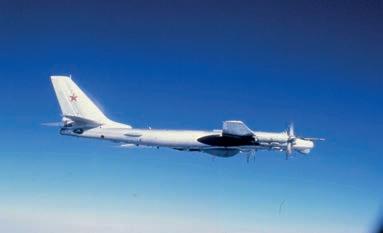


245* Battle of Britain Film Collection. A collection of items relating to the 1968 Battle of Britain film, which was one of the first films to undertake widespread merchandising of film-related items, including five copies of the rare ‘Briefing’ the in-house production magazine issues 2 to 6 (six issues were produced), two contemporary hard back books on the making of the film, the cinema issued booklet, the full set of 32 postcards as produced by Arthur Nixon, forty-two of the ABC bubble gum cards (the full set is 66) a flyer for Battle of Britain Prints posters, fifteen modern 6x4 prints mostly depicting Buchons at Manston, plus a copy of the scarce book on the film by the late Robert Rudhall published in 2000 ‘Battle of BritainThe Movie’ (a carton) £200 - £300




246* Battle of Britain. The German Cross in Gold bestowal document awarded to Luftwaffe Ace Hans 'Assi' Hahn, credited for 108 aerial victories, the certificate printed and named Hauptman Hans Hahn, dated 16 July 1942, with a printed signature of the Reich Minister of Aviation and Commander in Chief of the Air Force Hermann Göering, plus ink signature of The General of the Flyers lower right, 33 x 24 cm, mount aperture, modern frame, glazed, frame size 49 x 39 cm

Provenance: From the estate of Hans Hahn.
Hans 'Assi' Hahn (1914-1982), was born in Gotha, Thuringia, Germany. He joined the army in 1934 and transferred to the Luftwaffe in 1935 joining Jagdgeschwader 2 'Richthofen' in October 1939.
Hahn flew during the Battle of France and Battle of Britain before being transferred to the Russian Front as Gruppenkommandeur of II/JG 54 on 1 November 1942. He achieved 68 victories at the time of his transfer, he achieved a further 40 victories in Russia before force landing behind enemy lines on 21 February 1943. He was captured by the Russians and spent seven years in a POW camp before being released in 1949.

Hahn is credited for a total of 108 victories and was decorated with the Knight's Cross on 24 September 1940. An award which he received during the Battle of Britain after his 20th victory. He received the oak leaves to the Knight's Cross on 14 August 1941 after 42 victories and on 16 July 1942 he was awarded the German Cross in Gold.
The certificate was given to the vendor by his widow in 2003.
£700 - £1,000
Each lot is subject to a Buyer’s Premium of 20% (Lots marked * 24% inclusive of VAT @ 20%)
247* Battle of France. Air Ministry Certificate of Competency and Licence to Fly Private Flying Machines, blue cloth certificate issued to Hector Yeats Lawrence in 1937, Lawrence was killed in action during the Battle of France on 18 May 1940, small passport size black and white portrait photograph plus identity card issued to his wife

Hector Yeats Lawrence served during WWII with 15 Squadron, RAF, he was killed in action on 18 May 1940 (Battle of France) whilst flying Blenheim IV L8853 LS-V. The aircraft failed to return from a raid on Le Cateau and was reportedly shot down by Me109s of 3/JG 2, it crashed near Preux-au-Bois, North East of Arras, Northern France. Two crew killed and one taken POW.
(1) £50 - £80
248* Biz-Jet Slides. A collection of approximately 3500 35mm original colour slides of executive ‘Biz’ jets, the majority on Kodachrome film taken over the past 50 years, although mainly taken in the USA and Europe there is also a good amount of more ‘exotic’ material from areas such as Africa, Australia, the Far East and Latin America




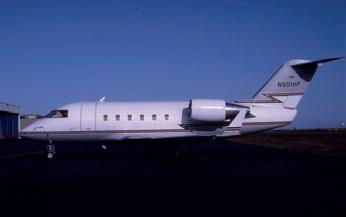



(approx. 3500)
£300 - £500
249 Aviation Autographs. An archive of autographs and letters to the pioneer aviator Sir Alan Cobham (1894-1973) related to the development of air to air refuelling, circa 1927-1970, the majority typewritten or handwritten on letterhead paper, signed, from over 40 major figures in the world of pre-war and post-war aviation including: RAF pilots, aircraft company founders and designers, etc., Jeffery Quill (1913-1996), Lord Beaverbrook (1879-1964), Geoffrey DeHavilland (1882-1965), John Cunningham (1917-2002), Captain Ray Hinchliffe (1893-1928), Johnny Johnson (1915-2001), Sir Frederick Handley Page (1885-1962), Lord Trenchard (1873-1956), Sir Malcolm Campbell (18851948), Rowland Beamont (1920-2001), Lord Brabazon (1884-1964), Jimmy Doolittle (1896 - 1993), Frank Whittle (1907-1996), Lord Dowding (1882-1970), Peter Twiss (1921-2011), Squadron Leader David Shannon (1922-1993), Squadron Leader Tony Iveson (1919-2013), and others, together with related non-vintage press photographs, brochures, newscuttings and photocopies, plus two related publications containing signatures of numerous British test pilots and RAF pilots: Don Middleton, Test Pilots, The Story of British Test Flying 1903-1984 (Guild Publishing, 1985), signed by twenty four pilots including Ken Waller, David Morgan, Headly Hazelden, Godfrey Outy, Cliff Rodgers, Brian Milton, Desmond Penfrose, Alex Henshaw, Peter Twiss, Brian Trubshaw, Paul Millet, and others, and Martin Middlebrook and Chris Everitt, The Bomber Command War Diaries, an Operational Reference Book 1930-1945 (Viking, 1987), signed, containing fifty autograph signatures by mostly war time members of 617 Squadron, air and ground crews, obtained at the 1957 Dam Buster Memorial event at the Petworth Hotel Wood Hall Spa, including Mick Martin, D J Shannon, L G Knight, J C McCarthy, K W Brown, W C Townsend, Wolley Tait, L. Cheshire, T V Iveson, Bill Reid, and others, both volumes original cloth in dust wrappers, large 8vo, the correspondence all contained in one cloth box file (an archive) £1,000 - £1,500

250* Colour Negatives. A collection of approximately 4,500 unsorted colour negatives mainly consisting of civil airliners from the 1960s to the 2000s, mostly 35mm and taken from original colour slides and come from the archive of the Aviation Hobby Shop which used them to produce colour prints, each negative is contained in its own sleeve and shows details of the registration, type and operator, the collection includes many rare and interesting subjects, the majority of which would be suitable for scanning to produce digital images (3 boxes) £600 - £800




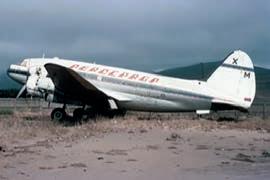








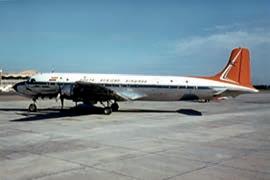

251* Hunt (Leslie). Twenty-One Squadrons, The History of the Royal Auxiliary Air Force 1925-1957, multi-signed publication with the title page containing 20 signatures including Peter Brothers 602 Squadron, Denis Smallwood 605 Squadron, Willoughby de Broke 605 Squadron and other distinguished pilots, there is an additional leaf now detached signed with approximately 45 signatures including John Cunningham 604 Squadron, Roland Beamont 609 Squadron and others (1) £100 - £150

252 Imperial Airways. Log books and photographs belonging to Captain Henry Lawrence Matthews Glover (1907-1974), RAF and later Imperial Airways pilot, comprising ten log books for RAF and Civil flying career, all numbered (RAF No.2 missing), the RAF log books numbered 1 and 3 are for the period of 2 October 1930 to 31 January 1933, and the third RAF log book number 7 is for the period of 22 November 1940 to 3 April 1941, there are seven civil period flying log books commencing 12 July 1937 and the final log book entry is 20 September 1965, together with Air Service Training (Met) notebook 1 & 2, three RAF Notebooks including Sight Log Book, plus a black and white portrait photograph of Glover in Imperial Airways uniform, framed plus Imperial Airways cloth brevet with gold bullion embroidery, an 'Overseas Airways Corporation enamel badge numbered 930 and three WWII medal ribbon bars, plus related photographs, including Officers, Royal Air Force Station, Upper Heyford, 1933, photo postcards, documents including Provisional Certificate of Proficiency in Radiotelephony, 1936, Air Ministry Ground Engineer's Licence, December 1937, a BOAC Agreement for Service as an Aircraft Officer, dated 1 December 1944, Manual of Air Traffic Procedures for Pilots, 2nd edition, 1957 printed articles, a "Douglas" Combined Protractor & Parrallel Rule (in original case),The Observer's Planisphere of Air Navigation Stars, by Francis Chichester and other related items




Captain Henry Lawrence Matthews Glover (1907-1974) was born in Mornington, Otago, New Zealand and joined the Royal Air Force on 12 September 1930 and rose to the rank of Flight Lieutenant until he was demobilised on 30 March 1937. He then converted to civil flying from 12 July 1937 with initial training before he was recalled for service during WWII for flying duties on active service and posted to 228 Squadron in Malta on 12 November 1940. His previous service with the RAF was 1873 Hrs 50 mins, Imperial Airways 71hrs27mins, Air Service Training (FLYING BOATS) 42hrs45mins, Imperial Airways "C" Class Empire Boats 2602hrs05mins with a total of 4530hrs07mins flying time.
He flew Air Service Training (Imperial "C" Class Empire boats) and B.O.A.C. flying Empire boats on the Horseshoe Route, South Africa to the Far East during the Second World War, also flying Sunderland bombers for a short time during the siege of Malta. He served with No.24 (Communications) Squadron during the pre-war years and was one of only 4 RAF officers authorised to carry members of the Royal Family and cabinet ministers. He was awarded the Queen's Service Medal for valuable service in the air.
(an archive)
£2,000 - £3,000

253* Italian Aviation. A collection of Italian aviation ephemera etc., comprising a Marchetti S79 brochure, selection of monochrome photograph images and documentation, Mario Massai folio of letters from Balbo to Massai, Shell Aviation Service route map 1933 from Milan-Tunis-Cairo including plans of the aerodromes en route, flying log book 1933-35, log book of 'Aviazione Legionaria' with many entries recording the bombing of Tarragona, Cuistores, Teruel, Castellon, St. Luycena, Zarragozo, Caspe, San Sebastiano, Monte Caballo, Barcellona etc., various Italian aviation mixed photographs and documents, including a folder containing monochrome photographs etc. relating particularly the Aero Club D'Italia conference 27/11/1960 and folder of miscellaneous Ala Littoria photographs and mounted cuttings of pilot biographies, plus log book for I-MISO dated 1961, Nard brochure & related images, RO 57/58 photocopy drawings etc., and Nunzio Proto original log book and flight logs for the period of 1923-51
(a carton) £150 - £200
254* Italian Aviation. A collection of Italian aviation photographs, circa 1930s & 40s, comprising a folder containing 166 civil and military monochrome photographs, a folder containing 86 aeroplane construction and testing monochrome photographs, a folder containing 59 other commercial Italian aviation photographs, a folder containing 89 Italian Military Aviation monochrome photographs, a folder containing 70 photographs of Flying Boats and other aircraft, and a folder containing an Ala Littoria photograph archive of 124 monochrome photographs (a carton)
£150 - £200
255* Italian Aviation. A collection of Italian aviation photographs, comprising a folder containing a Ala Littoria photograph archive of 53 monochrome photographs (with negatives), plus a similar folder containing 84 Ala Littoria monochrome photographs of people, cities, landscapes and related documents, plus a selection of monochrome photographs of Major General Aldo Pellegrini (18881940, Italian Air Force general during World War II), a folder of images, cuttings and ephemera relating to the aviator Carlo Del Prete (1897-1928), and selection of photographs of Benito Mussolini and officers viewing a flypast and formation (a small carton)


£150 - £200
 Lot 254
Lot 254
256* Log Book. A WWII Luftwaffe Pilot’s Flying Logbook for Oberleutnant Klug, commencing 8/7/1938, completed full-entry logging 1,980 flights recorded over a three-year period, with a final entry dated 14/3/1941, various aircraft types listed including Klemm, Fw-58, Bf-109, Ju-52, Dornier Do-23 and others, variously signed with Luftwaffe check-stamps together with a Flying Log Book for Uffz. Feldmann, opened 16-10-1941, flying the Heinkel He.72, various aircraft flown based at Mackfitz, intensive flying training with students, other aircraft flown include Caudron, Klemm, Arado, Bucker, and Junkers types, log book closed on 3011-1942 after 950 flights recorded, an interesting record of intensive flying training and An unusual Glider Pilot’s log book for Dieter Roth of Flieger-Landesgruppe VII Sud-West, and Segelflugschule Grunau/Rsgb., also Flieger-Ortsgruppe Sonneberg der FliegerLandesgruppe 13 des Deutschen Luftsport-Verbandes e.V., plus a part log book for a student at Fliegerschule (See) at Warnemunde recording 53 training flights during 1936 (4) £200 - £300

257* Log Books. RAF log books kept by Air-Vice Marshal Brian Pashley Young, CB, CBE, OBE, log book 1 missing, therefore, log book 2 commencing June 1941 and inscribed ‘estimated flying times Sept 1936 to the destruction of log-book in France May 1940. Detained in hospital May 1940 to July 1941. Posted to S Cerney for conversion course: January 1942’, final entry 29 January 1954, log book 3 commencing 5 February 1954, final entry 30 July 1957, log book 4, commencing 9 August 1957, final entry 29 October 1960, log book 5, commencing 21 February 1964, final entry 20 October 1967

Air-Vice Marshal Brian Pashley Young, CB, CBE, OBE (1918-1992) joined the RAF as Flight Cadet in 1936, he was appointed to a permanent commission on 30 July 1938 and Pilot with 32 Squadron the same day, in 1939 he was Assistant Adjutant for the squadron and on 4 October 1939 pilot with 615 Squadron, RAF Croydon.

Young was shot down on 16 May 1940 and was badly burned but fully recovered after 2 years in hospital. Young had been flying Hurricane P2577 when it burst into flames and crashed near Essene, he had baled out with burns to his upper body and face. As he floated down, British soldiers fired at him and he was wounded by three machine-gun bullets. Then, as he landed he was hit by shrapnel from a hand grenade thrown in his direction. It was only when the soldiers reached the barely-conscious pilot that they realised he was not German. Young was taken to hospital in Dieppe, from where he was evacuated by hospital train to St Nazaire. However, as the ambulance arrived at the harbour it was hit by gunfire which killed the occupants apart from Young, who eventually reached the UK aboard a hospital ship. His aircraft is still hidden under the ground of the plot at Essene.
(4) £400 - £600
258* Log Books. RAF log books kept by Air-Vice Marshal John Stacey, CBE, DSO, DFC, log book 1 commencing, 26 July 1938, final entry 30 November 1941, log book 2, first entry 2 December 1941, final entry 23 May 1962, log book 3, first entry 25 June 1963, final entry 15 July 1966, the log book records the date Stacey won the DFC, 20 December 1942 ‘Offensive Recco of Sabano Harbour, 4 Hits on the Harbour Buildings (Sumatra)’, plus the date of DSO for minelaying in Singapore, log books I & II spines worn and wear commensurate with age

Air Vice-Marshal John Stacey, CBE, DSO, DFC (1921-2004) was born in Cardiff, he was educated at Whitgift Middle School, Croydon before joining the Merchant Navy as an apprentice. In 1938 he joined the RAF and initially specialised in flying boats, shortly before the outbreak of WWII he was attached to No 240 Squadron based in Shetland and flying the bi-plane Saro London flying boat. He flew on anti-submarine and convoy patrols in northern waters and later became an instructor. In 1942 he joined No 202 Squadron at Gibraltar, flying Catalinas on patrols in the Mediterranean and Eastern Atlantic and then the squadron reformed at Koggala, Ceylon flying anti-shipping and anti-invasion patrols. On 26 August 1942 Stacey took off to search for survivors and dropped supplies to them. He located 3 lifeboats with 60 survivors and dropped them supplies. Then he circled overhead for 10 hours until relieved by another aircraft. He was awarded the DFC for his service when on 20 December 1942, when he and 2 other Catalinas were sent to carry out a reconnaissance and bombing operation against airfields and harbours in northern Sumatra, he reached Sabang at midnight, and despite anti-aircraft fire, he successfully dropped his four bombs before returning to Ceylon. He was described as being “a fearless captain whose determination to achieve success set a most inspiring example”.

On 23 March 1945 he led 8 Liberator bombers on a 3640-mile mission during which they laid mines in Singapore, after 21 hours the Liberators touched down in Ceylon, and Stacey was awarded an immediate DSO for a “high degree of courage and resolution”. Post-war service saw him promoted to Chief of Staff in the Royal Malayan Air Force in 1960 and he continued his service with the RAF until 1975 when he retired from service as Air Officer Administration, Support Command.
(3) £400 - £600
259* London Transport. Fly The Tube, Take the Piccadilly Line to Heathrow Airport. It’s the only way to fly, circa 1978, a rare original lithographic advertising poster printed by C.J. Petyt Ltd, numbered 679/2385M/2500 lower right, 101 x 63.5 cm

(1) £200 - £300
260* London Transport. The Heathrow Connection, Takes 45 minutes from Central London Links directly with Terminals 1, 2 and 3, a rare original lithographic advertising poster printed by C.J. Petyt Ltd 1983, numbered 1083/06132/3.M.(1630) lower right, 101 x 63.5 cm, restored by paperbackconservation.com (with conservation report)
(1) £200 - £300

261 Orde (Cuthbert Julian, 1888-1968). British artist and First World War pilot. Pilots of Fighter Command. Sixty-Four Portraits by Captain Cuthbert Orde, 1st edition, George G. Harrap, 1942, 32pp. (including 19 pages of pilot biographies), 64 full-page double-sided portraits after Orde’s drawings, including 9 signed by the sitters, plus one further clipped signature of Brian Kingcome pasted beneath p ortrait, with an additional 27 pilots’ signatures in various pens to front endpapers and autographs of 6 Polish pilots to rear free endpaper, some overall spotting to endpapers, original two-tone cloth in dust jacket, old clear tape strengthening to all margins of verso, binding and dust jacket a little rubbed and soiled, large 8vo, together with two folders of related material, comprising photocopies of many of Orde’s fighter pilot and other portraits, 54 RAF cut signatures (many with typed names below), including Elspeth C. Green, MM, WAAF; Air Vice Marshal James Edgar ‘Jonnie’ Johnson, CB, CBE, DSO & Two Bars, DFC & Bar, DL; Denys Edgar Gillam (the fastest confirmed victory of WWII - the time from take-off to landing being about eight minutes); and another page with 8 German night fighter signatures (Richard Marz, Dieter Brinkmann, Konrad Roesner, Heinz Misch, Willie Kleebauer, Walter Winterhoff, Gunter Schmidt, Rudolf Kotter, Emil Nonnenmacher), and two further RAF signatures, contained in two modern plastic folders, 4to Captain Orde is best known for his war art, especially his portraits of Allied Battle of Britain pilots. The 9 portraits signed directly by the sitters into the book are: Sqd. Ldr. A.G. ‘Sailor’ Malan DSO, DFC, ‘Biggin Hill May 1943’ - the RAF’s leading ace during the Battle of Britain (pl. 1); Flt. Lt. John ‘Cat’s Eyes’ Cunningham - the first man to shoot down an enemy plane with the aid of radar and the RAF’s most successful night fighter pilot (pl. 9); Sgt. J.H. ‘Ginger’ Lacey DFMthe second-highest scoring RAF fighter pilot of the Battle of Britain (pl. 12); Sqd. Ldr. Douglas Bader DSO, DFC (pl. 14); Flt. Lt. W.D. David DFC, DFC (pl. 25); Wing Cdr. R.R.S. Tuck DSO, DFC (2 Bars) (pl. 38); Flt Lt. A.C. Deere DFC ‘Biggin Hill May 1943’ (pl. 42); Sqd. Ldr. J.A. Kent DFC, SFW, KW (pl. 43); Wing Cdr. J. Rankin DSO, DFC, ‘Biggin Hill 27/8/43’ (pl. 55).




Provenance: The book was purchased by the previous owner with only three signatures on the portraits in May 1943 and the other signatures were mostly added while he worked as a guide at the RAF Museum Hendon; the Polish signatures at the back of the volume were obtained around 1996 when he helped to restore the 1/3 scale Spitfire war memorial model outside the The Orchard public house in Ruislip.
(3) £1,000 - £1,500

262* Schneider Trophy. Notes on High Speed Flight, 1931 collected by Wing Commander A.H. Orlebar, A.F.C, p.s.a., Air Ministry publication (Strictly Confidential) dated 15 April 1932, additionally stamped ‘The Resident Technical Officer’, 15 sections plus appendix, numerous technical diagrams and blueprint drawings including record of test flights, Calshot 1931, Supermarine S.VI.A and S.VI.B aircraft, a couple of annotated technical drawings and numeric table, bound by metal, some staining to the paper and frayed edges, 34 x 20.5 cm
Air Vice Marshal Augustus Henry Orlebar, CBE, AFC & Bar (1897-1943), was a pilot in both WWI & WWII serving with the RFC and RAF. He is particularly remembered for his high speed flying, commanding the High Speed Flight RAF, competing in the Schneider Trophy of 1927-1931, and holding the world air speed record. In 1929 Orlebar set an air speed record of 357.7 mph in Supermarine S.6 N247. The final Schneider Trophy contest was held in 1931 with a 3rd place win for Britain. Orlebar’s report described Flight Lieutenant George Stainforth’s achievement of a new speed record at over 400 mph.
(1) £200 - £300
264* World War II. Six albums of WWII pilots signatures, mainly on first day covers, signatures from pilots and navigators including: Wing Commander Peter Ayerst, Group Captain John Cunningham, Group Captain Tom Gleave, Group Captain F. R. Carey, Squadron Leader James Harry (Ginger) Lacey, Group Captain F. B. Sheen, Squadron Leader B. H. Drobinkski, Air Commodore S. C. Widdows, Richard Haine, Peter Townsend, Benjamin Bent, Alexander Nelson Robin Langley Appleford, Josef Jan Hanus, William Dennis David, ‘George’ Darley, Richard Leoline Jones, Lettice Curtis, Bunny Currant, Air Vice Marshall James Edgar ‘Johnnie’ Johnson, Aubrey Howell, Harry Hooper, Steve Stevens, Peter Twiss, Sir John Curtiss, Wing Cdr. Derek Martin, Günther Rall, Sqn Lrd Bob Dunkley, Saburo Sakai, Nobuo Fujita, Flight Sgt. Stan Bradford, Squadron Leader Pat Carden, Squadron Leader Terence Bulloch, P.R. Donaldson, Flight Lt. Eric Hookings, Ray Ellis etc., together with a few newspaper clippings and photographs

(6 albums) £500 - £700
263* Supermarine Spitfire. A Spitfire Aircraft collection of photographs and ephemera relating to the construction of Spitfires and Lancaster bombers at Castle Bromwich Aeroplane Factory circa 1938-45, including 300 + photographs, most later in date, but at least 20 of them from the 1939-45 period, including signed pilot photos (including Alex Henshaw, Chief Test Pilot), Churchill visit, also Prince Regent of Iraq and King Haakon of Noway, plus later publications and Spitfire Society commemorative event souvenirs, many signed by Henshaw and other surviving pilots, copy National Archive documents and other related items

Provenance: From the estate of Philip Insley, Chairman of the Spitfire Society Eastern Region (and former aircraft factory employee?), with copy of one of his books, featuring many of the photos in the collection, and signed by various pilots.
(carton)
£200 - £300
265* WWI RAF Training Posters. “Getting Off - Avoiding Collision”, rare large format lithographic training poster dated 20 July 1918, produced for the Air Technical Services for ‘Official Use Only’, showing two aircraft in flight with the caption ‘Do not turn suddenly without looking round. You may foul another machine taking off after you.’, 66 x 99 cm, together with another, titled “Bad Landing”, dated 26 April 1918, showing aircraft taking off and captioned ‘in positions 2 to 3 the inexperienced pilot may momentarily “lose his head”. Under these circumstances he will do well to get away again and have another try.’, 66 x 99 cm, both have been professionally restored by paperbackconservation.com (with conservation reports)
(2) £1,500 - £2,000
266* WWII Aviation Photographs. An interesting personal collection of approximately 120 black and white photographs of various sizes depicting WWII British-built aircraft, mainly fighters, subjects include the Hawker Fury, Hurricane, Tempest, Tornado and Typhoon, the Blackburn Firebrand, Fairey Barracuda and Spearfish, the Martin-Baker MB2/3/5, the Miles M.20 and the Supermarine Spiteful, several prototype shots as well as operational aircraft.
A complete list of the photographs is included with the album.
(1 album) £80 - £120
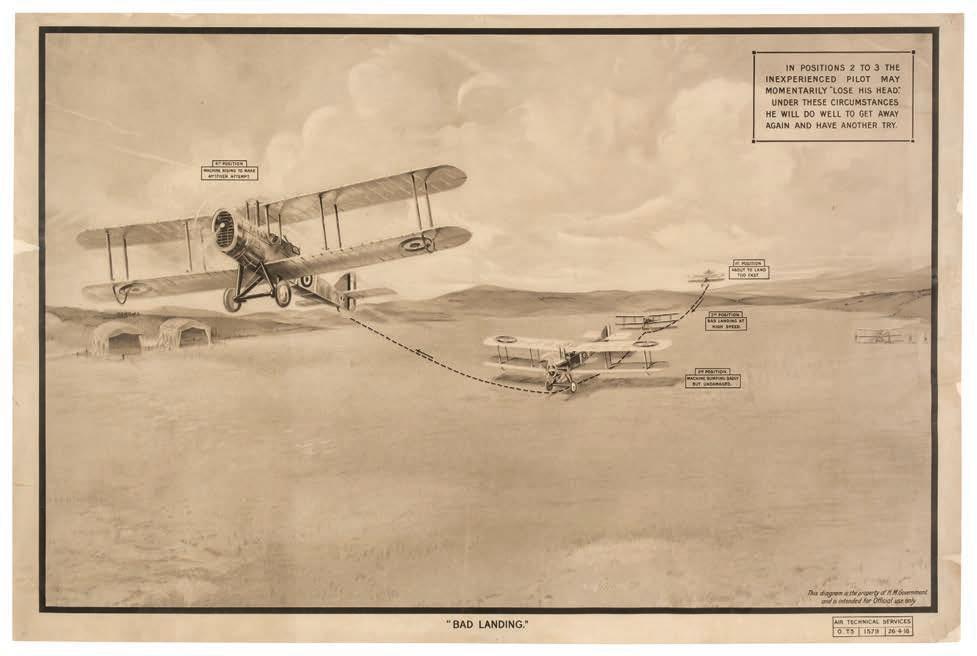

Officer
Max Sizer (1920-2006) was born in Chelmsford and educated at the King Edward VI Grammar School.
He joined the RAF in 1938 and after completing his training joined 17 Squadron at Kenley and early on in 1939 moved to 213 Squadron at Wittering.
The squadron went across to France on 17 May 1940 to support other squadrons during the Battle of France. On the 19th Sizer shared in the destruction of two Hs126s and damaged another, the following day he shared a Do17. On this patrol Sizer was attacked by five Me109s and was shot down. He landed two miles from La Panne and swam across a canal before being taken to a casualty clearing station with facial wounds. He returned to England and later rejoined the squadron on 21 May.
Sizer was flying over Dunkirk on 28 May and destroyed a Me109 and on 31st he shot down a Me109 and damaged another. He himself was shot down and made a crash landing in Hurricane P2434 south of Dunkirk.
On 11 August 1940 Sizer destroyed a Ju88, the following day a Me110 and on the 15th two Ju87s and on 5 October he damaged a Ju88.
He was awarded the DFC (London Gazette, 8 November 1940) and posted to 58 OTU at Grangemouth as an instructor. After a series of other posts with 56/57 OTU he joined 152 Squadron at Eglinton in April 1942 and went to North Africa with the squadron in November.
Sizer damaged a Mc202 on 25 November and a Ju88 on 28 December.
He was given command of 93 Squadron at Souk-el-Khemis in February 1943 and damaged a Ju88 on 10 July, damaged a Me109 on the 12th and destroyed a Mc202, probably another and damaged four more on 13th.
Sizer was awarded the Bar to the DFC (London Gazette, 28 September 1943). He went to 71 OTU Ismailia as an instructor before returning to England based at the Empire Central Flying School.

He was released from the RAF in 1946 as Wing Commander but rejoined two years later. He became a flying instructor and took command of 54 Squadron in 1953. He flew Meteor jet fighters before converting to the supersonic Hunter.
Sizer retired from service in 1985 after a long and prestigious career. His portrait was made by Cuthbert Order in October 1940.
The items offered here are from the estate of Wing Commander Sizer having formerly been sold in a general household auction in Surrey.
267* Battle of Britain. RAF uniforms belonging to Wing Commander Wilfred 'Wilf' Sizer, DFC & Bar, comprising post WWII blue cloth tunic with E.II.R. staybrite buttons and cloth brevet, medal ribbon bar representing DFC & Bar, 1939-45 Star with rosette for Battle of Britain clasp, Atlantic Star with rosette, Africa Star with rosette, Italy Star, Defence and War Medal, General Service Medal, with Wing Commander rank stripes to cuffs, approximately 84 cm long, 42 cm chest, inner arm 42 cm, with trousers, tropical uniform with Johnson, Hong Kong tailors label, RAF officer hat with G.VI.R. cloth insignia, the lining stamped Bates hatter, London (worn), a later E.II.R officers hat, inscribed 'Sizer', loose medal ribbon bars, green cloth flying suit / denim overalls, with tailors label for F.W. Harmer & Co Ltd, dated 1950 and other items, the lot is accompanied with an old clothing receipt from Ismalia inscribed to Sizer and dated 17 June 1944 (a carton) £200 - £300
268* Battle of Britain. A collection of items from the estate of Wing Commander Wilfred ‘Wilf’ Sizer, DFC & Bar, including a Spitifire / Hurricane tail wheel, the rubber tyre marked 400-3 1/2 Electrically Conducting, numbered 28522, approximately 28 cm diameter, a leather back pad from an aircraft seat, an aluminium knee pad, stamped 49 53094 ASS, the green canvas strap faintly inscribed with a service number, a green cloth gun holster and belt by M.W. & S Ltd, dated 1942 and inscribed ‘Sizer’ a tin of Ointment AntiGas, No 1 cream and other items, poor condition across the board (a carton) £200 - £300

WING COMMANDER W.M. SIZER, DFC & BAR, BATTLE OF FRANCE, BRITAIN AND NORTH AFRICA ‘ACE’Lot 268
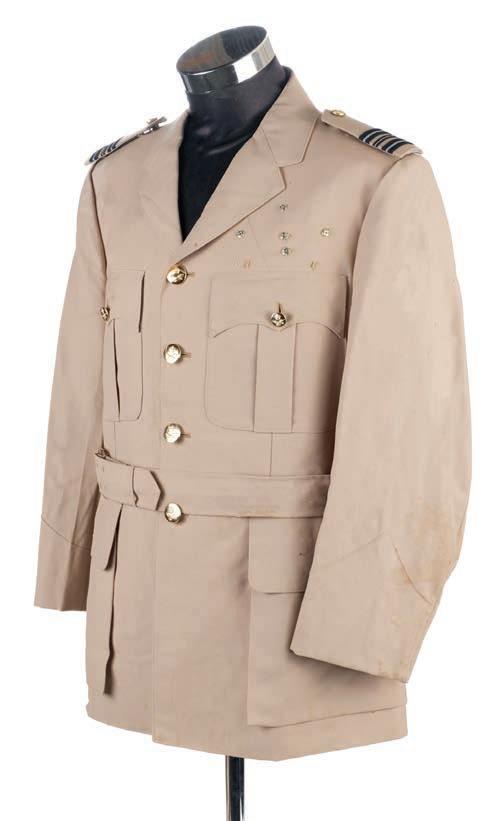



269* Battle of Britain. A collection of RAF ephemera belonging to Wing Commander Wilfred ‘Wilf’ Sizer, DFC & Bar, including pilots notes for Spitfire I Aeroplane (June 1941), Vampire FB.5 (May 1949), Oxford I & II (May 1944), two Prentice I (June 1948), two Harvard 2B (March 1949), Auster 6 & T.7 (August 1948), two Meteor 8 & 9 (July 1950), Mosquito (March 1944), Hunter F.4 (May 1955), Meteor 4 (July 1948), plus RAF Pocket Books dated 1932 inscribed to T.E. Morris and 1937 inscribed to F/O H.A.L. Weeks, Pilots Notes General inscribed to F/Lt W.M. Sizer, Pilot’s Handbook for the Middle East Command (June 1945), Rolls Royce Limited Pilot’s Notes for Merlin Mk 45, 46 & 47 Engines others for Merlin II, III & IV Engines, Kestrel XXX Engines, Merlin X Engines, Hunter Power Controls Notes for Pilots by Hawker Aircraft Limited Restricted and Hunter Pilot’s Procedure Trainer (July and October 1943) plus various personal papers and related items including pencil caricature of Sizer and portraits, framed and glazed (2 cartons) £200 - £300

270* Battle of Britain. A collection of RAF target maps belonging to Wing Commander Wilfred ‘Wilf’ Sizer, DFC & Bar, comprising including Dakar Africa 1:1,000,000 1941, Lisbon Gibraltar 1:000,000 1943, Mediterranean, Southern England and Wales, Cap Bojador Africa 1941, Casablanca, Madrid, The Azores together with a trunk containing approximately 150 WWII period maps of Northern Europe and the Middle East, plus three Air Route Books for Southern France to Cairo 1945, Kartoum to Karachi 1945, Cairo to Karachi via Habb 1945 and a section of a map of the midlands contained in a frame inscribed D-Dog No 1576. B.A.T. Flt and an Emergency Map Pack on the UK and parts of Europe, contained in a yellow canvas bag inscribed with the date 1948

(2 cartons) £200 - £300
271* Battle of Britain. A large and varied collection of photographs from the estate of Wing Commander Wilfred ‘Wilf’ Sizer, DFC & Bar, mostly aerial reconnaissance, including a series of three large format 9 x 10 inches, laid on card, titled British Light Bomber, enlarged x 2 original size, Camera Type F/24, taken over El Maou and Dabu-Fuka Road, Egypt showing salvoes of bombs from allied aircraft circa 1942, many loose including Allied Glider Landings South of Syracuse 10th July 1943, 12 x 10 inches, Taormina 9 July 1943, Allied Landings N.E. of Avola, 10th July 43, Attack on Ploesti, Romania, Day and Night Photography, SFAX Tunisia circa 1942, folder titled Interpretation of Night Photographs, containing 44 aerial photographs, all captioned including the Docks and Emden, Hamburg Cologne all 1941, a large folio with views over Kalmaki Airfield, Greece 1943, more of Tunisia 1943, Nose Camera Illustrations by 252 Squadron, including desert runway and Luftwaffe aircraft, other photographs including aerial reconnaissance titled 98 Bomber Group USAAF over Messina, Italy and Bari by 344 Squadron April 1943, plus a wooden box with the lid inscribed R.N. Sizer containing hundreds of loose WWII RAF photographs and some personal family images
(2 cartons) £200 - £300

272* Air Recognition. WWII black bakelite model of a Spitfire, base stamped ‘Spitfire’, chipped, 15.5 cm wingspan, together with a cast metal model of an F.86 Sabre, 14 cm wingspan, a wooden model of a Short Sunderland, 28.5 cm wingspan, wooden model of a MIG 9, 19.5 cm wingspan, glider and other models

(7) £100 - £150
273* Aircraft Instruments. WWII Air Ministry Lamp Signalling Aldis, contained in original wooden box printed with Air Ministry markings Box Spare Front Ref No 5A/1674 Lamp Signalling Aldis 4, 16.5 cm high x 16.5 cm wide x 6 cm deep, together with Jet Provost. T. Mk.3,51, 4 Cable Tensionmeter Aileron Controls, in original wooden box with stencilled markings RECTS CRAN 472/1, plus Air Ministry Air Speed Indicator and other items
(6) £70 - £100
275* Aircraft Models. A collection of WWII aluminium aircraft models, including a Mk 1 Spitfire X 4237 of 19 Sqn by D.P. Carter, 15.5 cm wingspan, mounted on a stand for display, another by Carter of a Lancaster ND811T of 635 Squadron dated 4 August 1944, 15 cm wingspan together with various models of fighter aircraft including Spitfire and Hurricane

(7) £150 - £200
276* Aircraft Models. A wooden model of WWI period biplane, finished in green with aircraft registration number K1077, RAF roundels to the wings and fuselage, 48 cm wingspan x 39 cm long, together with a Lufthansa wooden model, 70 cm wingspan x 52 cm long and other large scale aircraft models including a modern representation of a Curtiss JN-4 “Jenny”, 79 cm wingspan x 52 cm (5) £100 - £150
(1)
£200 - £300
277* Aircraft Models. Avro `Vulcan` B.Mk.1. aluminium desktop model circa 1950s, plain form with 23 cm wingspan mounted on stand with wooden base for display, 37 cm long, together with a similar Vulcan model, 23 cm wingspan


(2) £200 - £300
278* Aviation Badges. A mixed collection of badges including a De Havilland silver gilt badge with blue enamel, reverse numbered ‘38’, a 1930s Cobham ‘Flying Circus’ brass badge with red enamel wings by H.W. Miller Ltd, a Soviet enamel ‘Hampden’ badge, with screw back, ARP Warden enamel lapel badge for Thomas William Lench Limited (poor condition), Air Defence Corps white metal and enamel badge with brass pin, together with a Fairey Aircraft Company ashtray with enamel decoration, a Bakelite morse code key and other items
(1) £70 - £100
274* Aircraft Model. Gloster Meteor desktop model circa 1950s, aluminium with painted RAF roundels to the wngs and fuselage, 26 cm wingspan, mounted on a wooden base for presentation, 16 cm high279* Aviation Books & Ephemera. Silhouettes of Aeroplanes, Harrison & Sons 1915, Silhouettes d’Avions 1916, Small Anti-Aircraft Training booklet together with a large collection of aviation books, photographs and miscellanea

(6 cartons)
£200 - £300
280* Aviation Models. WWII aluminium Vickers Wellington desktop model, with 24.5 cm wingspan together with various aluminium model aircraft, mostly WWII period including a bomber mounted on a piston, 24.5 cm wingspan x 19.5 cm high
(9)
£200 - £300
282* Aviation Toys. Frog Model, Interceptor Fighter, in original card box, together with Appleby’s Toys S.E.5A. Single Seater Model Biplane, in original box (2) £100 - £150

281* Aviation Toys. A collection of 12 Skybirds miniature airmen, each 3 cm high, on original card packaging, together with seven composite WWI period airman models 6 cm high, Dinky Toys model of an Armstrong Whitworth “Ensign” Air Liner with original box, Appleby’s S.E.5.A. Single Seater Model Biplane in original card box and other items

(3 cartons)
283* Car Mascot. A 1940s Miles M.65 Gemini car mascot, chrome finish and stamped John Somers Ltd, 17 cm wingspan, mounted on a wooden base for presentation, some pitting, 9.5 cm high

The Miles M.65 Gemini was a British twin-engined four seat touring aircraft designed and built by Miles Aircraft at Woodley Aerodrome between 1945-47. (1) £100 - £150
£100 - £200
284* Curtiss Aircraft Log Book. An American Engine Log Book for Waco 10 of the Curtiss Airplane & Motor Company for the period of 1928-1931, commencing 16 August 1928, Waco “10”, number N.C. 6818, the 7 August 1929 records ‘We have a accident with airplane on motor parkway was not much damage after repair ok, by inspection dept of commerces. Airplane was taking up by Benj Alamousey oct 19 1929; 12 October 1930 ‘re-licensed for commercial use 10-9-30’, final entry 28 June 1931

The Curtiss Aeroplane & Motor Company was in operation from 1909-1929, they had a range of aircraft including the Waco 10, which in 1928 entered production, the Curtiss OX-5 then became the GXE. The Waco 10 was designed for light passenger transport.
(1) £100 - £150
285* Desk Lamp. A WWII bomber table lamp circa 1940s, chrome finish with articulated three-blade propellers, 23 cm wingspan, the frosted glass shade on a curved angle poise stand, 31.5 cm high

(1) £100 - £150
286* Flying Flea. Scott Flying Flea aircraft engine circa 1935, with data plate stamped TYPE M.C.2.-B4, No 5D450914, presented on a stand for display, 75 cm high x 56 cm wide, together with two blade propeller, finished in black with aluminium sheathes, the boss stamped ‘CAU 280, SAL 135 C7 9NC’, the opposite side stamped ‘TYPE 433 N11800’, 214 cm long, cockpit instrument panel, aluminium and perspex construction with speedometer, plus other items including two related books including The Flying Flea by Henri Mignet Frenchman Henri Mignet was an aircraft fanatic, born in 1893, who built his first monoplane as early as 1912. Between 1931 and 1933 Mignet designed a light aircraft, HM-8, and this lightweight machine was designed so that the amateur aviator could build his own aircraft from plans supplied. Mignet came to England in August 1935 with his ‘Le Pou de Ciel’, Flying Flea, to promote this new flying machine. At the Scott factory in Yorkshire William Cull was contemporaneously developing a two-cylinder, air-cooled, two-stroke engine which, upon completion, was marketed as an inverted, twin-cylinder engine with separate cylinder barrels sharing a common crankcase. Bore and stroke were 73mm x 78mm and cubic capacity was 652cc. This engine developed a maximum 28hp at 4,000rpm, but at a more leisurely 1,350rpm would propel the Flying Flea at 50mph. Testing was carried out at nearby Yeadon Airfield (now Leeds/Bradford Airport). The Flying Flea had a wing span of just 22ft. Sadly the aviation authorities were called in to investigate safety following a number of fatalities and all licences were revoked – Mignet’s ‘Pou de Ciel’ had seemed a good idea at the time but was illconceived. Mignet went on to develop further light aircraft for amateur builders, notably the HM-14, and continued at his design board until the 1960s.

See lot 287.
(1) £1,000 - £1,500

287* Flying Flea. A model aircraft of the 1930s Scott Flying Flea G-ADMH, lightweight construction, finished in two-tone light blue with aircraft registration number to the wings, with engine and twoblade propeller, 110 cm wingspan x 64 cm long, plus a smaller cruder wooden example of this aircraft, 25 cm wingspan and a copy of The Flying Flea by Henri Mignet
Stephen Appleby piloted the first flight of his Flying Flea (G-ADMH) on 14 July 1935 at Heston aerodrome. It was the first Mignet Pou-du-Ciel (Flying Flea) to fly in the UK. See lot 286.

(3)
£300 - £500
288* Luftwaffe Flying Goggles. A rare pair of WWII Luftwaffe ultrasin flying goggles by Nitsche & Gunther, black tinted lenses, grey leather face padding, elasticated strap, contained in original brown leather pouch stamped ‘Ultrasin 55%’ with original instructions

(1)
£200 - £300
289* Flying Helmet. American Type A-9 flying helmet, green cloth with brown leather earpieces and lambswool lining and chinstrap, together with a pair of German flying goggles, glass lenses and lightweight metal frames with rubber face pads and green elastic strap, a pith helemet with brass RAF badge and other items
(6)
Each lot is subject to a Buyer’s Premium of 20% (Lots marked * 24% inclusive of VAT @ 20%)
£100 - £150
290* Flying Helmet. An interwar leather civil flying helmet, soft brown leather, chamois lining and chinstrap, with pair of aluminium lightweight frame flying goggles, a pair of white soft leather flying gloves stamped ‘Sweat Resistant 22C/0005738 (1) £100 - £150

291* Flying Helmet. Mk1A bone dome flying helmet circa 1967, size 3, finished in silver with stores reference No.22 C/2120, inscribed ‘12 Sqn Soames’, with microphone and jack and modern replacement visor (sealed in a bag) (1) £80 - £120


£150 - £200
292 Flying Helmet. WWII American A11 flying helmet, brown leather with soft chamois lining, tailors label for The Selby Shoe Co, Property of A.F. U.S. Army, an additional label stencil printed 5BS, and inscribed with the owners name Wm Davis, integral earphones and Type A.10A green rubber oxygen mask with original box for the oxygen mask (1)
293 Luftwaffe. A WWII German Me109 painted pine cargo crate, grey painted finish stencilled in black ‘Rechter-Rüstsatz R1 Bf 109 F4 Gewicht: ca 135 Kg’, with concealed carrying handles, 60 cm high x 142 cm wide x 63 cm deep (1)

£300 - £500
294* Model Aircraft. A collection of 193050s 1:72 scale wooden model aircraft, mostly WWI and Interwar British biplanes including Bristol Fighter 16.5 cm wingspan, De Havilland F 5709, 18 cm wingspan with Christies lot ticket, 17 August 1995 (lot 301), Bristol F2B Fighter 16 cm wingspan, plus WWII examples including Morane Saulner 15 cm wingspan (17)
£200 - £300
295* Model Aircraft. A collection of 1930-60s 1:72 scale wooden model aircraft, comprising, WWI German, British and WWII Japanese, including Fokker DVII, 13 cm wingspan, Gloster Gauntlet K5302 15.5 cm wingspan, Schneider Trophy S.6.B, 13 cm wingspan and others (22) £200 - £300
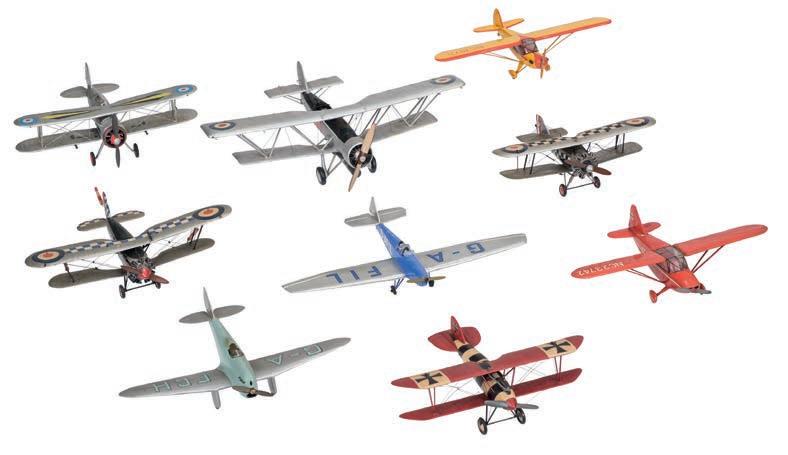
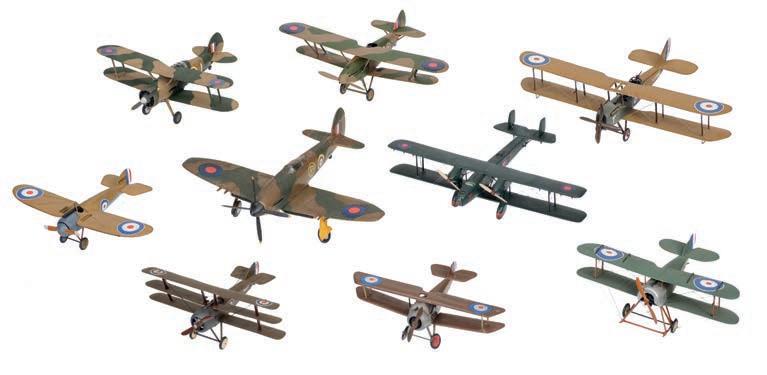
296* Model Aircraft. A collection of 1930-60s wooden model aircraft mostly 1:72 scale, including WWII Lysander 21 cm wingspan, Canadian Gruman Avenger AS-3 23cm wingspan and others

(19)
£100 - £150
297* Model Aircraft. A collection of WWII period brass models, including Avro Lancaster 28 cm wingspan, Blenheim Mk 1, 25 cm wingspan and mounted on an old shell case, Spitfire and Hurricane and other types

(13)
£200 - £300
298* Model Aircraft. A mixed collection of model aircraft, including a wooden Vulcan bomber 28 cm wingspan presented on a stand and other models
(a carton)
£100 - £150
299 Model Aircraft. A pre WWII metal model of a Luftwaffe gullwing sailplane, with 40 cm wingspan, the rudder painted in red with swastika, mounted on a curved stand with stepped base, inscribed ‘28.I.37 A.B.’

(1)
£100 - £150
300* Model Aircraft. A rare 1930/40s metal model of an Argentinian Ae.M.E.-1/2, finished with light blue and white roundels and rudder, gun turret and articulated three-blade propeller, 32.5 cm wingspan, mounted on a cut section of a wooden aircraft propeller

The FMA AeMB.2 Bombi was a bomber aircraft developed in Argentina in the mid 1930s. It was a low-wing cantilever monoplane of conventional configuration. It was fitted with fixed tailwheel undercarriage, the main units of which were covered by long, “trouser”-style fairings. The initial AeMB.1 configuration was fitted with a dorsal machine gun turret, later removed from the AeMB.2 to improve stability. Fifteen production examples saw service with the Argentine Air Force between 1936 and 1945. Only two were lost to air accidents.
(1) £300 - £500
Each lot is subject to a Buyer’s Premium of 20% (Lots marked * 24% inclusive of VAT @ 20%)
Lot 299£100 - £150
301* Model Aircraft. An educational diorama depicting an Avro Triplane 1911, presented in a hinged wood and glazed display case with a landscape painted background plus typed information, the propeller detached and currenty loose in case, case size 40 cm high 40 cm wide x 21 cm deep (1)
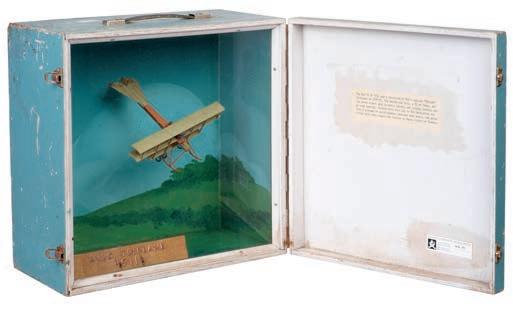
£100 - £150
302* Petrol Cans. A WWII Air Ministry miniature petrol can, stamped H647607/43/022(B) A.M. 40D/363, green painted finish with brass cap, 19 cm high, together with five larger Shell petrol cans plus an Esso can, all with brass cap, generally worn (7)

303* Pratt & Whitney. A modern model of a Pratt & Whitney Aircraft radial engine, with articulated chrome two blade propeller, mounted on a wooden base with Pratt & Whitney enamel plaque, 29 cm high, together with a miscellaneous collection of aviation items including two ashtrays showing a Lockheed over a map of Australia each dated 1946, 17 cm wide and other items (8)
£100 - £150
304* Royal Flying Corps. A collection of RFC and RAF memorabilia, comprising RFC cloth brevet, padded type, 12 cm wide, copper snuff box, of curved formed with RFC badge to the hinged cover, 7 cm long, WWI RFC sweetheart embroidered postcard, with J.J. Saint Omer Paris printed mark to verso, plus a small brooch in the form of a two-blade propeller 5 cm long, together with various WWII period RAF badges including a Pathfinder badge by J.R. Gaunt circa 1941, presented on card, RAF black plastic cap badge by Stanley & Sons, Walsall, Royal Canadian Air Force enamel badge inset into perspex, Air Ministry stopwatch circa 1940, the nickel case engraved A.M. 6B/117 2124/40, non running (13) £150 - £200

305* Schneider Trophy. A small chrome model of a Supermarine S.6B. circa 1930, 8 cm wingspan, mounted on an art deco chrome and brass base, 9 cm high (1) £100 - £150
306* Soviet Union.A collection of Soviet-period model aircraft, including a table lamp (not tested), an aluminium MiG with 18 cm wingspan presented on a stand, another MiG with 10 cm wingspan plus a presentation piece circa 1975 and other items (7) £100 - £150
 Lot 304
Lot 304
307* Spanish Civil War. German Condor Legion bracelet, made from eight Spanish silver 50 cent coins dated between 1892 and 1926, one coin polished and engraved ‘Espana 1937-1938 Legion Condor’, together with a silver Condor Legion ring of the Falange, the face of the ring depicting the arrow yoke of the organisation, stamped 600, a copy of Kampf um Spanien by Werner Beumelburg dated 1939, poor condition and lacking dust jacket and other items (7) £200 - £300

308* Wing Strut. WWI wing strut from a Bristol F.2A fighter, pine with transfer printed decal ‘The Britsh & Colonial ...’ with a handwritten label attached, 158 cm long, together with a WWI cockpit strut, pine with Aircraft Co Ltd London decal, 53.5 cm long plus two aluminium wing struts, 159 and 126 cm (4) £200 - £300


309* Air Raid Precaution. WWII ARP gas attack rattle, stamped R.C.D. 1944 with war department arrow and H10, 31 cm long, together with a pair of flying/motoring goggles, copper and brass bugle, five small model aeroplane two blade propellers, approximately 51 cm long (four stamped Punctilio Propellers), Compass Magnetic Marching Mark 1 by T.G. Co. Ltd, scratched ‘G.A. Markham’, plus two Burmese swords, a reproduction French sword and other items
(1) £100 - £200
310* Air Recognition. WWII black bakelite air recognition model of a Heinkel III Mk V, 32 cm wingspan, small chip to the tail fins

(1) £70 - £100
311* Air Recognition. WWII desk top model of a Handley Page Hampden, cast aluminium and finished in a workshop, 26.5 cm wingspan, mounted on a later mahogany base for display purposes

(1) £100 - £150
312* Aircraft Canopy. Panavia Tornado combat aircraft canopy circa 1990s, with Panavia data plate, perspex and grey metal finish frame, the data plate with part number obliterated, Nato number 1560-99-657-0909, Mfr CWK, overall length 290 cm The Panavia Tornado was operated by the Royal Air Force, Italian Air Force and Royal South Air Force during the Gulf War in 1991. The Tornado conducted many low-altitude penetrating strike missions. They were also used the Bosnian War, Kosovo War and Iraq War and Libya during 2011. A total of 990 aircraft were built.
(1) £300 - £500
 Lot 311
Lot 311
313* Aircraft Diorama. “Tiny Tim” U.S.A.F. A-1J Skyraider 602nd SOS. Nakhon Phanom R.T.A.F.B. Thailand 1969’, a fine diorama by Ian Ruscoe, showing Skyraider “Tiny Tim” preparing for takeoff, the model of composite construction, presented in a perspex display case, case size 28 cm high x 63 cm wide x 61 cm deep
(1)
£300 - £400
315* Aircraft Diorama. Dogfight Over North Korea, USAF F-86 Sabre versus North Korean Mig-15, a fine diorama by Ian Ruscoe, the models of composite construction, presented in a perspex display case, case size 27.5 cm high x 65 cm wide x 33 cm deep

(1)
£300 - £400
316* Aircraft Diorama. Dogfight, a fine diorama by Ian Ruscoe, showing He219 (Eagle Owl) night fighter 310188 being shot down by an RAF pilot, the model of composite construction, presented in a perspex display case, case size 26.5 cm high x 46 cm wide x 83 cm deep

(1)
£300 - £400
314* Aircraft Diorama. A-7E Corsair II US Navy Attack Squadron VA-86 “Sidewinders”, a fine model by Ian Ruscoe, showing a Corsair flying over the ocean, the model of composite construction, presented in a perspex display case, case size 23 cm high x 33 cm wide x 45 cm deep



(1)
£150 - £200
317* Aircraft Diorama. F-1040 Starfighter 435th TFS DA Nang Airbase South Vietnam 1965, a fine model by Ian Ruscoe showing USAF Lockheed Starfighter 60919 preparing for takeoff, the model of composite construction, presented in a perspex display case, case size 21 cm high x 31 cm wide x 68 cm deep
(1)
£150 - £200
318* Aircraft Diorama. F-105G Thunderchief, Vietnam, a fine model by Ian Ruscoe of a Thuderchief in flight, the model of composite construction, presented in a perspex display case, case size 24 cm high x 30 cm wide x 58 cm deep (1)



£150 - £200
321* Aircraft Diorama. F-4E Phanton “Betty Lou” Flown by Col. A.K. McDonald Commander 388th T.F.W. Korat Royal Thai Airbase 1969, a fine diorama by Ian Ruscoe, showing “Betty Lou” preparing for takeoff, the model of composite construction, presented in a perspex display case, case size 23 cm high x 45 cm wide x 66 cm deep
This F-4E nicknamed “Betty Lou” of the 469th Tactical Fighter Squadron from the 388th Tactical Fighter Wing was deployed to Korat Royal Thai Air Force Base in November 1968. Its “shark mouth” had originally been painted when it was used for crew training by the 40th TFS/33rd TFW stationed at Eglin Air Force Base and the design passed along with the aircraft.
(1) £300 - £400
319* Aircraft Diorama. F-14A Tomcat, a fine diorama, showing a Tomcat flown by Commander Jerry Riendeau on an aircraft carrier, the model by Ian Ruscoe of composite construction, presented in a perspex display case, case size 18 cm high x 34 cm wide x 47 cm deep (1)


£150 - £200
F-86F
“The Huff”, Korea 1953, a fine diorama by Ian Ruscoe, the model of composite construction, presented in a perspex display case, case size 22 cm high x 46 cm wide x 41 cm deep
(1) £150 - £200
320* Aircraft Diorama. F-14A Tomcat, VF-154 “Black Knights” Onboard USS Kittyhawk (CV 631) Operation Iraqi Freedom 21st March - 14th April 2003, a fine diorama by Ian Ruscoe, showing “Black Knights” preparing for takeoff, the model of composite construction, presented in a perspex display case, case size 28 cm high x 37.5cm wide x 66 cm deep (1)
£200 - £300
“Lucy” Operation Herrick, Kandahar, Afghanistan 2007, a fine diorama by Ian Ruscoe, showing this aircraft with crew, the model of composite construction, presented in a perspex display case, case size 23 cm high x 54 cm wide x 41 cm deep

TV
(1) £300 - £400
322* Aircraft Diorama. Sabre 323* Aircraft Diorama. Forces Harrier GR-7A324* Aircraft Diorama. Meteor F3 616 Sqn Melsbroek, Belgium, March 1945, a fine diorama by Ian Ruscoe, showing Meteor 239 preparing for takeoff, the model of composite construction, presented in a perspex display case, case size 15 cm high x 35 cm wide x 35 cm deep
Four Meteors were moved to Melsbrook in Belgium in January 1945 and in March 616 Squadron was moved to Gilze-Rijen and then Nijmegen. The Meteors flew armed reconnaissance and ground attack operations without encountering any Luftwaffe jet fighters. By the end of the war the Meteors had destroyed 46 German aircraft through ground attack.
(1)
£150 - £200
326* Aircraft Diorama. Operation Jericho (The Amiens Prison Raid) 18th February 1944, a fine diorama by Ian Ruscoe, showing de Havilland D.H.98 Mosquito HX922 preparing for departure, the model of composite construction, presented in a perspex display case, case size 21 cm high x 58.5 cm wide x 54 cm deep

On 18 February 1944 Mosquito HX922/F took off at 11am on a secret mission known as Operation Jericho. Allied aircraft bombed Amiens Prison in the German-occupied France at very low altitude to blow holes in the prison walls and use shock waves to spring open cell doors. The French resistence were waiting outside to rescue prisoners.
Of the 832 prisoners, 102 were killed during the bombing raid, 74 were wounded and 258 escaped. Two thirds of the escapees were captured. Two Mosquitos (one of which was HX922) plus a Typhoon were shot down and another Typhoon was lost at sea. HX922 had lingered too long over the target and as it turned for home, the aircraft was attacked by the Me190 of Feldwebel Wilhelm Mayer of 7/JG 26 who shot its tail off, both crew were killed.
(1) £300 - £400
(1)
£150 - £200
327*
II” 62nd FS/56th FG. Boxted. England, a fine diorama by Ian Ruscoe, showing “Miss Fire” preparing for takeoff, the model of composite construction, presented in a perspex display case, case size 19.5 cm high x 42 cm wide x 44 cm deep

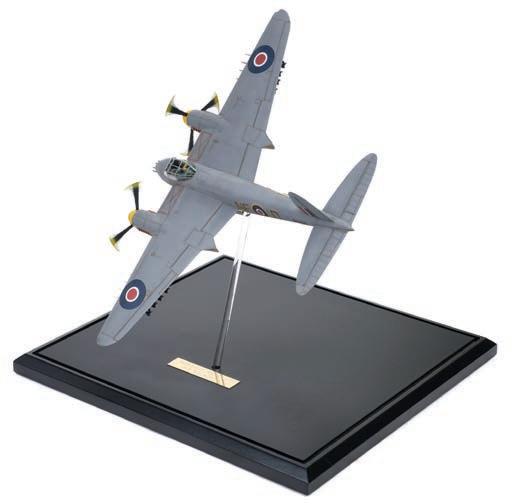

P-47D Thunderbolt “Miss Fire / Rosie Geth II” was flown by Frederick Chritensen Jr of 62 Squadron. The squadron was based in England from December 1942 and Chritensen’s first aerial victory came in November 1943 when he down an Me-110. On 7 July 1944 he and his squadron were returning for an escort mission when they spotted a dozen Ju52s returning to land. Christensen downed six of the aircraft which were much slower, his final score for WWII was 21.5 victories.
(1) £150 - £200
325* Aircraft Diorama. Mosquito FB. MkVI of 143 Squadron, a fine diorama by Ian Ruscoe, showing Mosquito RS625 in flight, the model of composite construction, presented in a perspex display case, case size 32.5 cm high x 30 cm wide x 32 cm deep Aircraft Diorama. P-47D Thunderbolt “Miss Fire / Rosie Geth330* Aircraft Diorama. Shaba F-117A Stealth Desert Storm, a fine diorama by Ian Ruscoe, showing Lockheed F-117 Nighthawk preparing for takeoff, the model of composite construction, presented in a perspex display case, case size 18 cm high x 48 cm wide x 38.5 cm deep
328*
Diorama. P-51D Mustang “Blondie” 334th Fighter Squadron 4th Fighter Group, a fine diorama by Ian Ruscoe showing this aircraft with ground crew, the model of composite construction, presented in a perspex display case, case size 22.5 cm high x 39 cm wide x 38 cm deep

(1)
£150 - £200
During Operation Desert Storm, the Saudis dubbed the aircraft “Shaba” which is the Arabic for ghost.
(1) £150 - £200
329*
Onboard HMS Ocean Off Coast of Korea 9th August 1952 Flight Leader Lt. Carmichael Shot Down A Mig-15, a fine diorama by Ian Ruscoe of this Hawker Sea Fury, the model of composite construction, presented in a perspex display case, case size 22.5 cm high x 36.5 cm wide x 37 cm deep


Commander Peter “Hoagy” Carmichael, OBE, DSC (1923-1997) served with the Royal Navy during WWII and continued service post war serving in Korea where he shot down a jet-engined Mig-15 while flying a piston-engined Hawker Sea Fury. The only recorded victory of a piston-engined aircraft over a jet fighter during the Korean War.
(1)
£150 - £200
331* Aircraft Diorama. Spitfire MkIXC Wing Commander J.E. “Johnie”[sic] Johnson Kenley Wing. RAF Kenley. July 1943, a fine diorama by Ian Ruscoe, showing Spitfire EN398 preparing for takeoff, the model of composite construction, presented in a perspex display case, case size 20 cm high x 34.5 cm wide x 34.5 cm deep
(1) £150 - £200
332* Aircraft Diorama. SR 71-A Blackbird Det. 1st SRW/9th, Kadena A.B. Okinawa, a fine model by Ian Ruscoe, the model of composite construction, presented in a perspex display case, case size 20 cm high x 57 cm wide x 45 cm deep

(1) £150 - £200
 Aircraft
Aircraft Diorama. Sea Fury FB-11 of 802 Squadron
Aircraft
Aircraft Diorama. Sea Fury FB-11 of 802 Squadron
333* Aircraft Diorama. Taxiing by F-16CJ, 79th FS. 20th FW. Buckley Air Base, Colorado, USA, 2001, a fine model by Ian Ruscoe, the model of composite construction, presented in a perspex display case, case size 26 cm high x 37 cm wide x 57 cm deep
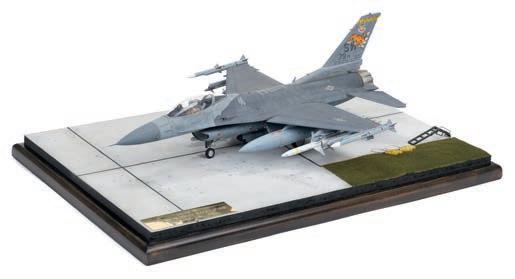
(1) £300 - £400
334* Aircraft Diorama. U.S. Navy A-1H Skyraider VA-176 “Thunderbolts” October 1966 Vietnam, a fine diorama by Ian Ruscoe, showing this aircraft diving, the model of composite construction, presented in a perspex display case, case size 33 cm high x 33 cm wide x 30 cm deep
(1) £100 - £150
335* Aircraft Diorama. VMFA-242 Hornet of Marine Fighter Attack Squadron 242, a fine model by Ian Ruscoe, of composite construction, presented in a perspex display case, case size 19 cm high x 33 cm wide x 44.5 cm deep


(1) £150 - £200
336* Aircraft Instruments. A collection of WWII aircraft instruments including, a WWII bomb selector release switch panel Lancaster 5D/656 RAF plane Air Ministry, WWII RAF aircraft ammeter 5U/1635 in original box, six Air Ministry 5CW/545, five Tumbler Switch Type B’s (three in original boxes), plus other aircraft parts and instruments

(a carton) £200 - £300
337* Aircraft Instruments. WWII rear tank fuel gauge circa 1943, with stores reference number 6/A 895 SR/43, 51 mm diameter, together with an altimeter Mk XIID circa 1944, with stores reference number 6A 30, additionally inscribed ‘7/45’, 55 mm diameter, RAF Type P.10 compass, No 1004 B, 14.5 cm dial, plus WWII black and white photographic air recognition cards (approximately 300) showing allied and enemy aircraft, 9 x 14 cm
(4) £100 - £150
Lot 334Lot 339
338* Airship. Hydrogen gas tester for an airship by Davis & Sons, (Derby) Ltd circa 1930, with oak and lacquered brass casing, paper dial (some discolouration, printed with arrow for Hydrogen release, the lower section with a similar gauge (directional needle detached), contained in an oak transportation box, 12 cm high x 25 cm wide x 29 cm deep

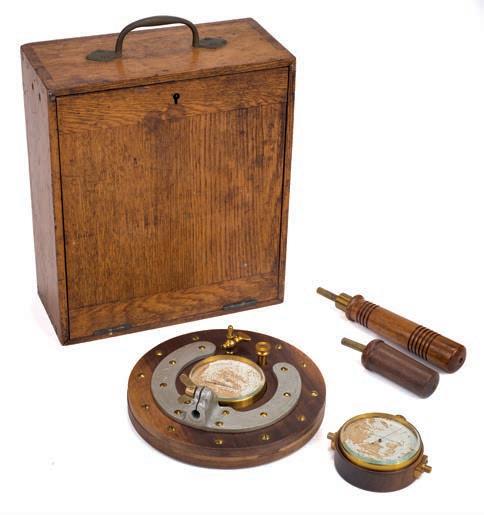
(1) £200 - £300
339* Bagatelle. A 1950s novelty aviation bagatelle games board by Kay toys, titled ‘Sons of the air Bagatelle’ colour printed with WWII British aircraft including Westland Lysander, Hawker Hurricane, Bristol Blenheim and other RAF aircraft, some wear commensurate with age and use, 72.5 x 38 cm

(1) £80 - £120
340* Bomber Command. A post-WWII aluminium figure of an airman, standing in full flying apparel, mounted on a carved wood base printed ‘Bomber Command’ with RAF wings above, 21 cm high (1) £70 - £100

341* Cockpit Clock. WWI Royal Flying Corps aircraft Swiss Made timepiece by Octava, the top wind openface pocketwatch with circular black dial stamped 8-Day Non-Luminous Mark V, B.B. No 4003, with arabic numerals, subsidiary seconds dial, the nickel case stamped A with arrow, with original cockpit holder and felt backing, mounted on a section of mahogany propeller blade
(1) £200 - £300
342* Cockpit Clock. WWII RAF cockpit 8-day clock dated 1943, the 55 mm circular black dial numered 6A/1072 and 12584/43, illuminated arabic numerals, the aluminium case with brass bezel and brass cap to the protect the winder, non running, together with a WWII RAF cockpit footage indicator type 45, as used on gun cameras, numered 14A/3312

The cockpit clock has a brass cap to protect the winder which is an unsual design that could well have been used by air sea rescue or a flying boat, worthy of further research.
(2) £100 - £150
343* Concorde. A collection of Concorde memorabilia including a 1970s ladies silk scarf by Soie, printed with Concorde in yellow on a cream ground with two tone blue border, 85 x 85 cm, in excellent unworn condition with original box, together with four framed certificates dated 1972/74/75 and 87 each signed by Chief Test Pilot Brian Trubshaw, all framed and glazed, a signed copy of Concorde
The Inside Story by Brian Trubshaw, British Aircraft Corporation
“First Flight of Concorde 202” 16mm col/mute cine reel, with original packaging and other items
(a carton)
£70 - £100
344* Derby Aviation. An impressive Derby Aviation wall clock circa 1940s, the wooden case with circular white dial, blue roman numerals steel hands, the cream painted case inscribed Fly Derby Aviation with logo, 56 cm diameter, the clock has been professionally restored, with period key and pendulum

Derby Aviation started passenger flights from Burnaston Aerodrome (otherwise known as Derby Airport) in 1953 using de Havilland Dragon Rapide aircraft. The first service was to the channel island of Jersey and saw Burnaston House at the airfield serving as passenger terminal. In 1959 Derby Aviation’s airline services transferred to the newly formed Derby Airways brand. Although private flying continued, commercial flights at Burnaston ceased in the mid-1960’s when East Midlands opened as a civilian airport. Derby Airways relocated to East Midlands with a simultaneous rebrand to British Midland Airways, the precursor to ‘BMI’ which was ultimately integrated into British Airways in 2012. The Burnaston Aerodrome site closed in 1990 and became a manufacturing plant for Toyota.
(1) £500 - £800
345* Desktop Model. A 1960s Fokker F-27 Friendship travel agents model aircraft in Aer Lingus F27 livery, heavy aluminium construction, probably manufactured by the Maarten Matthys Verkuyl, Netherlands, some areas of wear and restoration, presented on original stand, 57 cm wingspan

Aer Lingus was the launch customer for the Fokker F-27 Friendship, taking delivery of two new aircraft on the 19th of November 1958 and launching revenue flights the following month. Maarten Matthijs Verkuyl produced models under contract for Fokker (F27/F28) as well as KLM, Lufthansa and Lockheed throughout the 1950’s and 1960’s.
(1) £400 - £600
lot is subject to a Buyer’s Premium of 20% (Lots marked * 24% inclusive of VAT @ 20%)Lot 345 Lot 344
346* Desktop Model. A Gloster Meteor desktop model circa 1950s, chrome finish, 16 cm wingspan and presented on a curved stand with wooden base painted and titled ‘Doodlebusters’, 21 cm high
(1) £80 - £120
347* Elementary Flying Training School. A WWII cloth badge for No. 23 Elementary Flying Training School (EFTS), the large felt badge showing a RCAF Harvard, 23 EFTS and 130 Yorkton Sask, 16 x 15 cm
No 23 EFTS was based in Saskatchewan, Canada from 1942 to 1945 and trained commonwealth aircrew during WWII.
(1) £50 - £80
348* Escape & Evasion. A collection of WWII RAF and Army button compasses, plus a fly button compass and other types

(7) £150 - £200
349* Fighter Command Radio. WWII TR9D aircraft radio, a type used in Spitfire and Hurricane during the Battle of Britain, with Air Ministry data plate stamped, Transmitter Unit Type T.1119, Ref. No 10D/10471, Serial No. 23086, the central strap stamped 10A/9172, a second data plate applied to the front panel stamped X Mitter Receiver Type TR 9D, Ref No 10D/10470, Serial No. 23896, a large stenciled 12 in yellow the casing, corrosion and wear commensurate with age and use


The TR9D transmitter receiver was designed for use in a single-seater fighter aircraft and was intended to provide two-way communication to a range of 35 miles air/ground and 5 miles air-to-air. It was installed behind the pilot’s cockpit and the pilot wore headphones, microphone and a remote control unit which operated the send-receive switch and other contols.
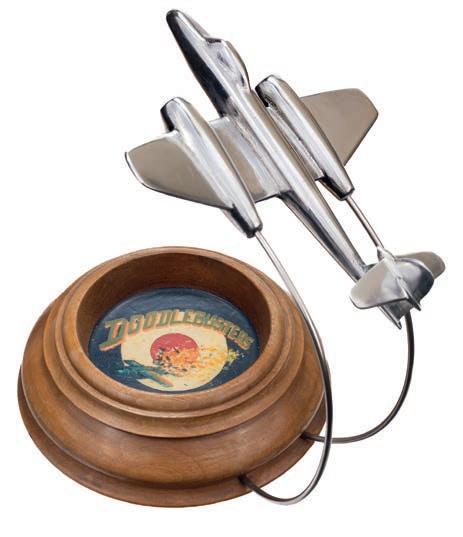
(1) £1,000 - £1,500
350* Flying Apparel. 1930s pilot’s flying equipment, comprising a WWI period brown leather coat (very poor condition), a cotton flying suit, two flying helmets each with Gosport tubes (one with brown fur lining) poor condition, two sets of flying goggles (a Meyrowitz and a later set), leather gauntlets (size 9.5) numbered 43 with military arrow and other items, contained in an old leather suitcase
(1) £150 - £200
(1) £100 - £150
large
fur lining, together
a WWII period RAF silver sweetheart brooch, with blue, green and red enamel, 55 mm wide, WWII period lock knife with blade and two tools including marlin spike, composite chequered grips, plus two Air League of the British Empire gilt and enamel badges
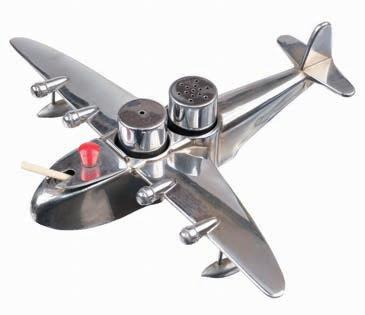
(5) £70 - £100
Each lot is subject to a Buyer’s Premium of 20% (Lots marked * 24% inclusive of VAT @ 20%)
searchlight and a smoking gun, elasticated cuffs and waistband, 11 cm diameter, general wear commensurate with age and service, some cracking and a hole on the left side, with traces of a USAAF decal to the left arm and with additional Acme Thunderer whistle 584th Night Fighter Squadron (NFS) was formed in 1944 and after training, it was deployed to Seventh Air Force and




to
Islands in the Central Pacific. Its mission was the air defence of Twentieth Air Force Boeing B-29 Superfortress airfields on Saipan and also on Iwo Jima. The unit also provided night interceptor attacks. It later served on Okinawa where was inactivated in December 1945.
(1) £1,000 - £1,500
351* Flying Boat. A 1930s novelty cruet set in the form of a Short Brothers Empire Flying Boat, chrome finish with salt and pepper shakers and mustard pot with glass liner and spoon, 20 cm wingspan (1) £70 - £100 352* Flying Helmet. A reproduction American Air Force flying helmet by Fantex, grey finish with integral visor and manufacturer label for Fantex Corporation USAF DWG 60-C-4459, padded earpieces and microphone, contained in a green cloth bag with Fancies Industries, Inc trade label 353* Flying Helmet. An interwar period brown leather flying / motoring helmet, brown leather with Newby Brothers Ltd B’ham studs, chamois and with 354* Flying Jacket. A WWII American A2 flying jacket of the 584th Night Fighter Squadron (NFS), brown leather with Talon Zip (working), a circular patch showing a cat with a ordered Mariana355* Isle of Man Air Race. A 1920s gentleman’s presentation malacca walking cane, the gold plated top engraved ‘To F. Sgt Sparkes. S.W. from Sgts Mess No 4 F.T.S. Egypt 1923, 87.5 cm long, with a folder of copied research

Sydney William Sparkes (1889-1937) was born in Rugby, he joined the Royal Naval Air Service on 6 November 1914 and served in the Dardanelles where he was slightly wounded. He later served at Dunkirk and the Somme before transferring the RAF in 1918. Post war service in Iraq and was awarded the Meritorious Service Medal on 28 October 1921 for service in Mesopotamia. He became a flying instructor at No 5 F.T.S. Sealand, near Chester and in 1928 became the first voluntary flying instructor of the newly formed Liverpool and District Flying Club. He was discharged from the RAF as a flight sergeant on 4 May 1931.
Sparkes took part in the King’s Cup Race in 1934, 1935 and 1936, racing Mr Porter’s aeroplanes. He was regularly seen giving exhibitions and in 1928 had created a record for travelling round the world on a motorcycle and side-car in 157 days.
Saturday 29 May 1937 was Britain’s fourth Empire Air Day and one of the blackest days in the early history of British aviation. Seventeen people were killed over that weekend including Sparkes who at the start of the Isle of Man air race was flying the Vega Gull monoplane and was the 14th aircraft to take off from Hanworth for the Isle of Man. Onlookers were horrified to see one of the wings clip a tree and crash into the roof of a nearby house. The charred bodies of Sparkes and Fry were recovered from the wreckage.
(1) £150 - £200
356* Luftwaffe. A WWII night navigational map for the United Kingdom and the opposite side for Northern Europe, yellow waxed cloth, 1: 2,000,000 scale and dated 1941, pinprick holes over Southampton, Kingston and Chesterfield as well as other locations, 55 x 70 cm

(1) £80 - £120
357* Luftwaffe. WWII Luftwaffe brown leather map case, stamped with squadron markings I/K.G.153 LBA 1937, the interior fitted with seven bullet holders and other compartments, together with two WWII Luftwaffe aluminium ammunition boxes, with Waffen markings and numbered WaA286, 17 cm high x 9 cm wide x 36 cm deep, both corroded
The map case is believed to have been owned by a Harry Jones who served in the Home Guard during WWII. This map case could well have been recovered from a downed aircraft. The ammunition boxes were found in Normandy.

(3) £150 - £200

358 Model Aircraft. A tinplate model of the Red Baron’s Fokker Triplane, finished in red with Iron Cross insignia to the fuselage, 60 cm wingspan, together with another tinplate model of a WWI RFC biplane, finished in green with roundels and numbered ‘3’, 57 cm wingspan, plus a collection of modern small scale model aircraft and stands
(Qty)
360* Propeller Boxes. A collection of WWI and later wooden propeller boxes, including a section of a propeller dated 15 April 1916, 17.5 cm long plus a wooden box with cover painted with RAF wings, 8 cm high x 18 cm wide x 13 cm deep

(9)
£100 - £150
359* Oxygen Bottle. WWII RAF oxygen bottle dated 1941, a type used in Spitfire and Hurricane, the bottle stencilled in white 6D/9429896 with other markings including ‘use no oil or grease they cause explosions’, the brass neck stamped 14782/41, with Mk.8 connector, approximately 46 cm long, together with a WWII Air Ministry brass stirrup water foot pump dated 1940, the brass pump with oval Air Ministry plate stamped H173928/40/C22(B) 27F/1873, 54 cm high

(2)
£200 - £300
361* Propeller Workshop Tool Chest. The WWI Ruston & Co Ltd propeller workshop tool chest circa 1914, the rectangular wooden chest having transfer printed trade label for Ruston & Co Ltd Lincoln with the symbolic Lincoln Imp against a bi-plane, the chest with multiple drawers and sliding compartments enclosing many hand tools used in the factory for the production of propellers, notable pieces are a coffin plane which the concave sole and blade has been adapted to be used on a surface to create rounded ashes and a number of spoke shaves used to smooth the rounded edges of the propellers, there is also steel and brass connector which was from an aircraft rudder foot pedal, the chest with traces of red paint which is the same colour as the engine cowlings from WWI aircraft, 53 cm high x 90 cm wide x 54.5 cm deep, restored Provenance: Formerly from the family of a Ruston’s factory worker living just outside of Lincoln.
In 1857 Joseph Ruston became a partner in the small Lincoln millwrights business of Burton & Proctor. The company then became Ruston, Proctor & Co Ltd and quickly expanded. By 1914 the works covered 100 acres and had over 5000 employees. On 15 January 1915, 100 B.E.2c aircraft were ordered and from Rustons expanded to become the largest producer in the country of aircraft engines, and came amongst the leading five British aircraft constructors of the Great War for aircraft output. Over 2000 aircraft including the Sopwith Camel were built by the company and production of aero engines exceeded 3000 units. By the end of the war about 3000 men and women were employed in aeronautical work at Rustons. Aircraft made in Lincoln by John Wallis & Charles Parker refers, a copy of the book is included with the lot which features a black and white photograph on page 16 showing the propeller workshop in which a chest is seen on the right hand side of the workshop.
The Ruston factory was demolished in 2018 making way for housing developments.
(1) £1,000 - £1,500
£100 - £150
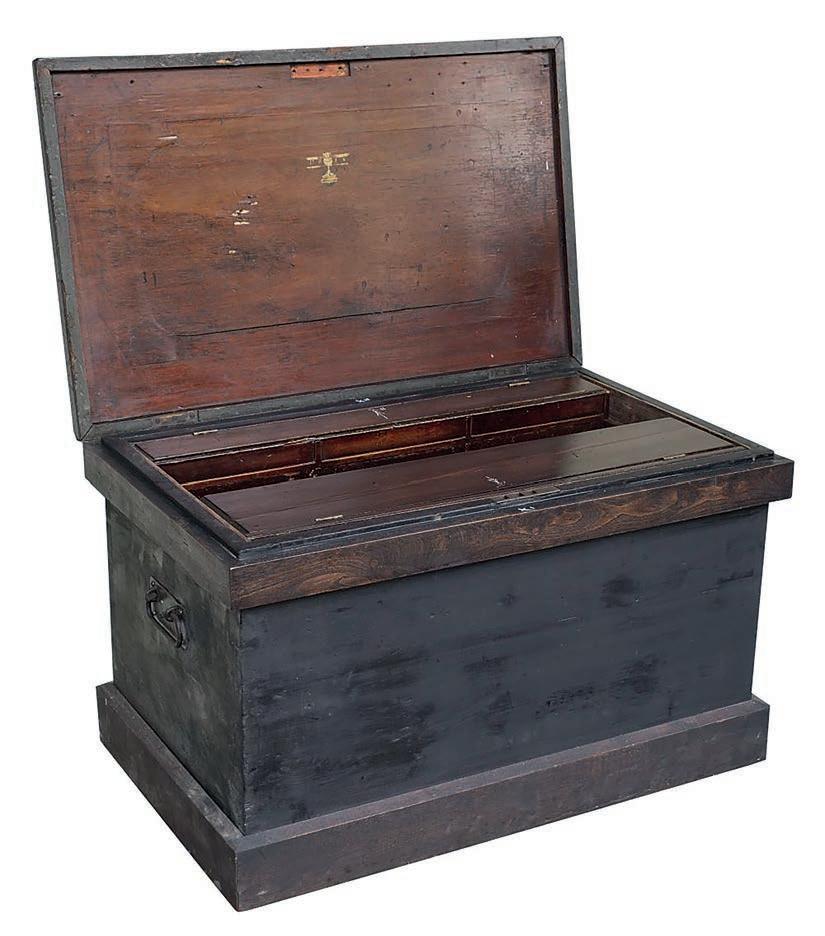



362* Propeller. A substantial WWI period propeller blade, laminated mahogany cut from a two-blade propeller, no markings and therefore, unidentified, 168 cm high x 33cm at its widest, presented on a log for display purposes

(1)
Each lot is subject to a Buyer’s Premium of 20% (Lots marked * 24% inclusive of VAT @ 20%)
363* RAF Trophy. A Royal Air Force silver-plated trophy presented to Air Vice-Marshal D. Parry-Evans, CBE, the trophy formed as a kestrel mounted on an ebonised base with a hallmarked silver plaque engraved ‘Royal Air Force Staff College Air Vice-Marshal D. Parry-Evans CBE, RAF Commandant 1981-1902’, 19 cm high Air Chief Marshal Sir David George Parry-Evans, GCB, CBE (1935-2020) was educated at Berkhamstead School before joining the RAF in 1953. He became Officer Commanding No.214 Squadron in 1974, Commandment of the RAF Staff College, Bracknell in 1981 and then went on to be Air Officer Commanding-in-Chief RAF Germany and Second Tactical Air Force in 1985, and last post as Air Member for Personnel in 1989 before retiring in 1991. He later became President of the Shackelton Association.
(1) £200 - £300
£300 - £500
364* RAF Trophy. An RAF silver trophy cup by Mappin & Webb, London 1930, the two-handle cup with stylised handles and engraved ‘604 (B) Squadron Inter Flight Cup Presented By Wing Commander A.S. Dore, D.S.O.’, the opposite side with the winners from 1931-1937 (inclusive), slightly off to one side, 22 cm high, 11oz Group-Captain Alan Sidney Whitehorn Dore, C.B., D.S.O.

(1) £200 - £300

365* Red Baron. A WWI hardwood box, the cover applied with an aluminium plaque contemporarily engraved ‘This plate was part of Baron Richthoffin’s [sic] aeroplane which was brought down within British lines 21st April 1918’, 8 cm high x 15 cm wide x 10 cm deep, containing a small piece of aircraft fabric inscribed ‘Oct. 14th 1909, covering of the wing of the monoplane made at Oakington by Groose & Feary’, plus a newspaper article from the Glasgow Herald 22 April 1968, ‘German Airman Remembered’ detailing the death of Baron von Richthofen


Manfred Albrecht Freiherr von Richthofen nicknamed Red Barron (18921918) was credited for 81 aerial victories.
A. M. Grose and N. A. Feary designed the Grose & Fearly monoplane in 1909. It was finished in April, 1910, at Oakington, Cambridgeshire. The machine was a single-seater and was powered by a four-cylinder 25 h.p. Advance engine. The wings were equipped with a patented lateral stability device. Span, 26 ft. Length, 25 ft. Wing area 160 sq. ft.
(1) £500 - £700
366* Reflector Gunsight. WWII RAF Reflector Gun Sight Mark II dated 1941 for night fighter service in Spitfire and Hurricane, stamped Stores Ref. No 8B/2666, A.M. Serial No 26865/41 with various patent numbers dating from 1937 to 1938, Air Ministry stamps, a modern 12 volt plug is attached so it can be working, contained in original wooden transport box with original three pin plug 5C/890, a good example with no chips on the glass and rubber in good order

(1) £700 - £1,000

367* Rolls Royce Coffee Table. A novelty coffee table, created from a highly polished Rolls Royce ‘Avon’ jet engine alloy casting, with shatterproof smoked-glass circular top 109 cm diameter

(1) £100 - £150
368* Royal Air Force. WWI Airco DH.2. 7907, hand-built model aircraft, finely detailed with RFC / RAF roundels, approximately 26 cm long x 31 cm

(1)
£200 - £300
369* Royal Flying Corps. WWI period propeller hub tobacco box, laminated mahogany, the cover with a white metal RFC badge and the underside of the cover with an ivorene plaque stamped ‘AeroArt Product guaranteed to be made from British Aircraft Propellers of the War Period 1914-1918.’, foil lined for preservation and green baize to the base, 13 cm high x 13.5 cm diameter, the overall condition is good with recent french polish

(1)
£100 - £150
370* Royal Flying Corps. A fine collection of WWI RFC badges, comprising embroidered cloth brevet, brass pilots wings for field uniform (probably by Gaunt), pair of collar badges, cap badge plus a pair of brass shoulder titles, presented in a period glazed frame, frame size 39 x 30 cm, all sealed in a frame and unable to inspect (1) £200 - £300

371* Royal Flying Corps. A WWI aircraft propeller tip, laminated mahogany with brass sheathing, applied with an RFC brass cap badge and 1914 miniature dress miniature medal group (unattributed) and inset with a cockpit / motoring clock, the circular dial stamped ‘Foreign’ with black Arabic numerals and steel hands, the backplate stamped ‘1299’, 40 cm high (1) £200 - £300

372* Rudder Pedal. WWII Japanese fighter aircraft left rudder pedal recovered from Babo, New Guinea, lightweight aluminium construction numbered 7070 with double inscription, the opposite side inscribed and dated 1941[?], with bound cable, 24 cm long

Provenance: Recovered by the vendor from a small airfield at Babo, western New Guinea circa 1980.
Babo was a Japanese base during WWII and is now well known for the number of aircraft that have been recovered over time. The airfield and aircraft at the base were repeatedely parafrag bombed by the US Air Force. The airfield was used for crew-changing oil exploration workers, transitting between Jeffman Airport, Sorong, (Constructed as a WWII US bomber base) and heli rigs in the jungle. The pedal is probably from a Nakajima-built aircraft.
(1) £300 - £500
Lot 371THE SCHNEIDER TROPHY (LOTS 373-375)
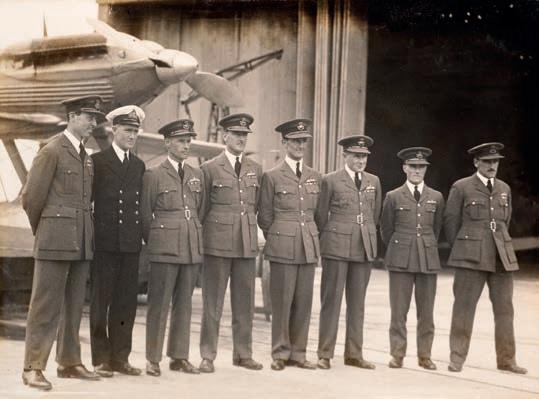

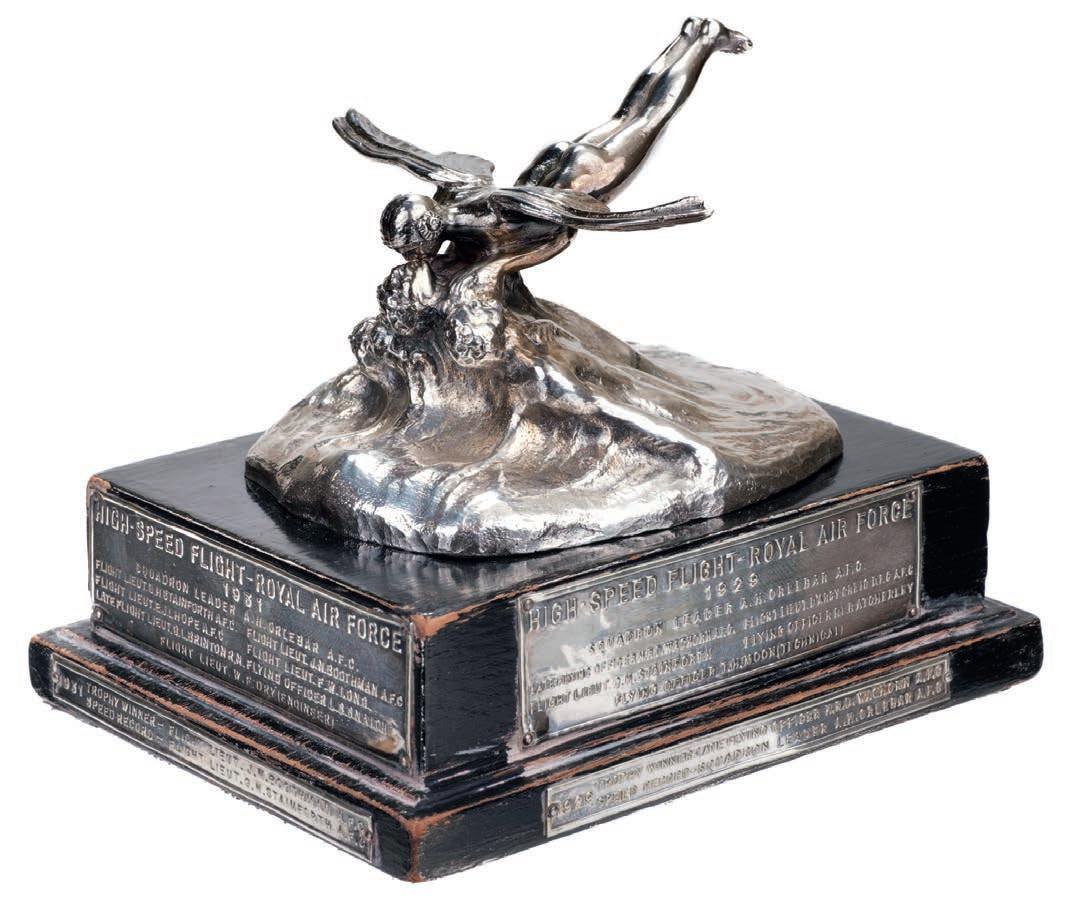
373* Schneider Trophy. An important silver-plated Schneider Trophy miniature presented to Group Captain William Frederick Dry, CBE, mounted on an ebonised plinth applied with nine silverplated plaques recording the International Schneider Trophy winners, World’s Speed Record holders and Royal Air Force HighSpeed Flight members, variously dated 1927-1931, 11.5 cm high x 14.5 cm wide x 11 cm deep, together with a collection of original documents and photographs including a photograph album containing approximately 40 black and white photographs compiled by Dry including the aircraft workshop, Supermarine S.6A, N248, Gloster Napier IVB N222, Supermarine S.5 N219, plus earlier family life and military service in the Royal Flying Corps, nine large format black and white photographs (some press and RAF issued) showing the Schneider Trophy in Venice (1927) and Calshot (1931), a handwritten copy of lecture notes and a further typed copy, the book, The Schneider Trophy Contests (1913-1931) by Ellison Hawks, inscribed ‘W Dry’ and other related items
Provenance: Group Captain William Frederick Dry, CBE (1896-1974) then by family descent.
Group Captain William Frederick Dry, CBE (1896-1974) was the Engineering Officer of the 1931 Schneider Trophy-winning team. He and seven of the winning team were awarded the Schneider Trophy miniature. The full-size trophy is held at the Science Museum.

Dry on leaving school in 1914 enlisted in the Royal Engineers, his role was a motorcycle despatch rider. In 1915 he transferred to the Royal Flying Corps and quickly gained his wings and commission, being based at Netheravon.
The RFC amalgamated with the RNAS to form the RAF on 1 April 1918 and Dry transferred to the RAF and started engineering training, whilst flying squadrons were being established. He served for six years at Martlesham and then posted overseas to India, based near Karachu. Whilst there many pioneer long-distance flights to the Far East and Australia passed through including Arthur Gordon Jones-Williams and Sir Alan Cobham (see lot 375).
At the end of 1930 Dry returned to England and early in 1931 he had the opportunity to join the High Speed Flight as Team Engineer, which set up initially at Felixstowe, later moving to Calshott. This was RJ Mitchell’s dream child and the Supermarine S6B was born.

The seaplane was quite different to contemporary aircraft, being all metal and its fuel contained in the floats, a supercharged boosted Rolls Royce engine, and the whole plane of futuristic aerodynamic styling.
Dry explained in a lecture talk he made (the notes included in the lot) that the seaplane was tricky to handle, particularly at take-off, made even worse more difficult with no forward visibility!
There were significant engineering issues to overcome. The reality was that every occasion the plane ventured out was a test, with great risk of damage, and danger for the pilot.
The advance in air speeds that were achieved that September of 1931, were indeed remarkable. It is little wonder that the Supermarine S6B should be the forerunner of what was to come the Spitfire fighter aircraft.
After the Schneider Trophy excitement, Dry continued in the RAF, and another tour of India later returning to England to take up an appointment at the RAF Staff College. His role became Personal Staff Officer to four successive Assistant and Deputy Chiefs of Air Staff including William Sholto Douglas and Arthur ‘Bomber’ Harris. Dry retired from active service in 1946. Dry could often be seen driving between Camberley and his home Frogmore, Surrey in his pre-war open top Riley sports tourer resplendent with its Supermarine seaplane bonnet mascot. See lots 374, 375.
(1) £5,000 - £8,000
374* Schneider Trophy. A Royal Air Force silver-plated trophy presented to Group Captain William Frederick Dry, CBE who was the Engineer Officer on the winning 1931 Schneider Trophy Contest winning team, the trophy formed as a kestrel mounted in an ebonised base with a plaque engraved ‘Royal Air Force Staff College Presented to Group Captain W.F. Dry, C.B.E., R.A.F. (Ret.) College Secretary 1946-1962’, 19 cm high
See lots 373, 375.
(1) £200 - £300
375* Schneider Trophy. A collection of photographs compiled by Group Captain William Frederick Dry, CBE, who was the Engineer Officer on the winning 1931 Schneider Trophy Contest winning team, including a photograph album compiled by Dry for the period of 1917-1926 (approximately 65 photographs) including Royal Flying Corps at Netheravon 1917, Martlesham 1924-26, Sir Alan Cobham 1926 and his replacement observer, Karachi 1926, airfields, aerial photographs plus nine loose photographs all 6 x 8 inches, including one signed by Squadron Leader Arthur Gordon Jones-Williams and his co-pilot Lieutenant Norman Jenkins with their Fairey long-range monoplane at Karachi 1929
See lots 373, 374.
(1) £150 - £200
376* Scramble Bell. WWII period Aerodrome Station Bell dated 1938, engraved with large crest, the crown stamped 'M.O.A' with war broad arrow, with clapper, in good condition with no cracks and repairs, 28 cm high x 27 cm diameter .



Provenance: The vendor purchased this bell from a site clearance at North Weald, Essex. Reputedly from RAF North Weald. During WWII the airbase was home of 151 Squadron who saw action over the beaches of Dunkirk and played a key role in the Battle of Britain.
(1)
£2,500 - £3,000
Each lot is subject to a Buyer’s Premium of 20% (Lots marked * 24% inclusive of VAT @ 20%)
377* Scramble Bell. WWII 'Battle of Britain' Period Aerodrome Station Bell dated 1940, with small engraved motif, the crown stamped 'G.B.' and with broad arrow, with clapper, in good condition with no cracks or repairs, 28 cm high x 27 cm diameter Provenance: The vendor purchased this at a site clearance at Debden, Essex. Reputedly from RAF Debden which was the home of 85 Squadron during the Battle of Britain. The airfield was attacked by the Luftwaffe several times.
(1)
£2,500 - £3,000

378* Swagger Sticks. A WWI Royal Flying Corps swagger stick, bamboo with plated top embossed with RFC wings emblem, 72.5 cm long, together with another for 2nd King’s Own Yorkshire Light Infantry, 69 cm long
(2) £70 - £100
379* Vickers Varsity. Captain’s seat, aluminium on steel adjustable frame, sandblasted to remove years of grease and dirt, original green paint underside preserved
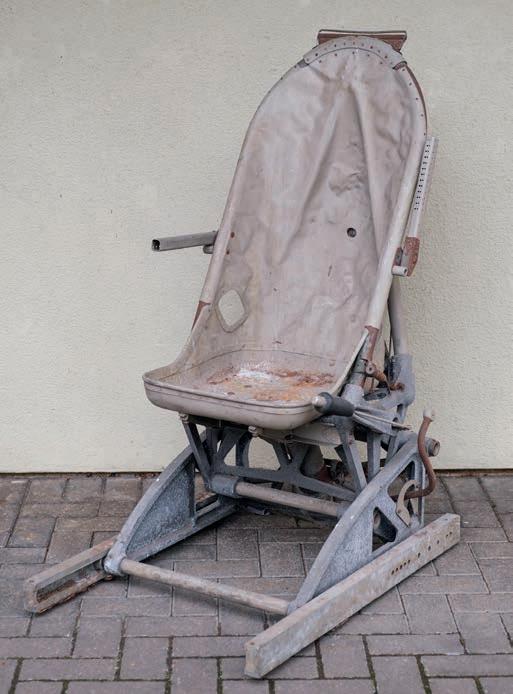
(1)
£200 - £300
380 Wall Plaque. Royal Air Force pottery wall plaque crest, with king’s crown and the motto Ardua Ad Astra, in a blue and white glaze, printed Ridgways Shelton England mark to base, some crazing, 27.5 x 31.5 cm

(1) £50 - £80
381* WWII Aircraft Parts. Spitfire Reflector Gun Sight and control column, the spade grip with firing button, later mounted for display, 115 cm long (overall condition poor), together with a Hurricane tail wheel (relic condition), plus Spitfire rearview mirror support brackets
(3) £300 - £500
 Lot 380
Lot 380
The entire Tonbridge Battle of Britain Museum Collection will physically remain in Tonbridge, Kent, and no lots will be available to view or to collect from Dominic Winter Auctioneers in South Cerney at any time.

Customers wishing to bid in person may do so in South Cerney where the selling of this Collection will follow on from our Military & Aviation Sale on Thursday 18 May. Lots 1-400 (items from other vendors) will be displayed at South Cerney in the usual manner with a catalogue and viewing details available in early May. Commission, phone and online bidding is available throughout the day for both parts of the sale.
VIEWING ARRANGEMENTS (LOTS 401-557)
Viewing in Tonbridge is limited and strictly by appointment only on the following dates:
Tuesday 9 May 10am-4.30pm (strictly by appointment)
Wednesday 10 May 9.30am-4pm (strictly by appointment)
All collections are to be made by prior arrangement from Tonbridge, Kent on the following dates only:
Thursday 25 May 10am-4pm
Friday 26 May 9.30am-3pm
Customers must have settled their invoice with the auction office in full prior to arriving at the Museum. There will be no facility to take payments at the Museum and proof of purchase and payment will be required.
As all the Museum lots will remain on site in Tonbridge, purchasers must make their own collection and shipping arrangements. Dominic Winter cannot offer in-house packing services for any lots sold from the Museum.
Invoices must be paid in full prior to collection by third party shippers who must agree collection dates and times and carry all necessary receipts and paperwork.
Details of local third party couriers and shippers will be available on our website from early May.


When I was a young lad growing up in the village of Hildenborough, Kent, one story, often repeated, was of the Spitfire that crashed behind the Half Moon public house during the Battle of Britain. The mystery surrounding why the Spitfire crashed intrigued me throughout my youth. My parents and many other villagers remembered that cold and misty morning of Sunday 27th October 1940, and hearing a short, loud burst of machine gunfire, followed by the sound of a screaming Rolls Royce Merlin engine. What happened next is history.
Pilot Officer R.J. "Johnnie" Mather of 66 Squadron was on a routine patrol over Maidstone when he broke formation and went into a near vertical dive.
His commanding officer P.O. H. R. Allen saw him break formation and followed him down, shouting down the RT for him to pull out. To avoid crashing himself P.O. Allen came out of the dive and, as he climbed away, he looked back and to his horror saw Johnnie’s Spitfire P7539 hit the ground and explode. The mystery about the crash and knowing Johnnie’s Spitfire was still there behind the Half Moon, buried in the rear garden, was to stay with me and made me determined to find it. After numerous phone calls and meetings I was finally given permission to recover the Hildenborough Spitfire in 1972.
So it was that with a group of friends and locals on a cold February morning we started digging the hard ground with just shovels and spades. We were never short of friendly advice from villagers who would stop and chat, mainly to inform us we were digging in the wrong place and to point out lots of different spots! After a few weeks, I managed to persuade local businessman Don King to give us a hand with his JCB. This was a turning point and at about 15 feet down we could clearly smell aviation fuel and oil. We found railway sleepers and sacking which had been left from the original RAF recovery unit in 1940 and just a little further down we finally found the Spitfire engine. After living with the story for so many years finally finding Johnnie's Spitfire was very emotional. The aircraft was stuck fast in mud but with the use of a skip lorry we eventually broke the engine free from its resting place of 32 years. Along with the engine we recovered the Coffman starter motor, Supermarine rudder pedals, various parts from the instrument panel, cockpit glass and an assortment of other small artefacts.
Having recovered Spitfire P7539, I wanted to find other lost aircraft and their pilots so I started researching and digging local crash sites. Many of the sites were well known and items already recovered. I then met Al Brown and thanks to his brilliant research we were able to find many missing aircraft and pilots from the Battle of Britain. Sadly, the more we recovered, the more the Ministry of Defence tried to stop us. But we continued with the same determination and over the years I was involved with about 25 recoveries. The resulting collection of artefacts and their stories grew into the large collection that is the Tonbridge Battle of Britain Museum. However, after 50 years collecting, the time has now come to close the museum and offer the collection at auction in the hope that these artefacts will be treasured by new owners for many more years to come. The museum was my tribute "to the few" and I hope you will find these historic items and their hidden stories as remarkable as I have.
401* Spitfire P7539. The Rolls Royce Merlin Engine recovered from Spitfire P7539, Pilot Officer John ‘Johnnie’ Romney Mather was killed on 27 October 1940 when his Spitfire crashed at Half Moon Lane, Hildenborough, Tonbridge, the cover stamped Rolls Royce and numbered D8988/1, approximately 125 cm long, currently displayed on a four-wheel stand, with accompanying black and white photograph of Mather (taken 20 hours before he was killed in action), framed and glazed
Provenance: Tonbridge Battle of Britain Museum, Malcolm Pettit. John ‘Johnnie’ Romney Mather (1915-1940) was born in Blackheath, London. He was educated at Dulwich College. Mather joined the RAFVR in June 1937 as an Airman and was called to full-time service when war broke out in 1939.

Mather was commissioned on 1 April 1940 and posted to 66 Squadron at Duxford.
On 10 July 1940 he shared in the destruction of a Do17 and on 2 September shared a He111. He was shot down in combat over the Thames Estuary on 18 September and bailed out unhurt. His Spitfire R6925 is believed to have crashed near Coldred.
On 27 October Mather was killed when his Spitfire, P7539 crashed and burned out at Half Moon Lane, Hildenborough. At around 8.30 am he broke formation and went into a near vertical dive, his commanding officer, Pilot Officer H.R. Allen saw him break formation. Allen followed Mather down, shouting down the radio “pull out Johnnie, for christ’s sake pull out”. Allen pulled out of the dive, and as he climbed away he looked back and saw P7539 hit the ground and explode. It was initially believed the Mather may have suffered from anoxia however, further investigation by Malcolm Pettit suggests he was almost certainly shot down in the defence of London.
Mather is commemorated at St. Margaret’s churchyard, Ifield, Sussex.
The engine was the first aircraft recovery by Malcolm Pettit and has been the focal point of the Tonbridge Battle of Britain Museum since it was excavated by Malcolm in 1972. It was located in the Half Moon public house garden along with two Supermarine rudder pedals, the engine starter motor and various other aircraft parts.
See lots 410, 477 and 503.
(1) £4,000 - £6,000
Each lot is subject to a Buyer’s Premium of 20% (Lots marked * 24% inclusive of VAT @ 20%)
402* Messerschmitt Me109 E-4. The Daimler-Benz DB 601 engine recovered from Messerschmitt Me109 E-4 flown by Lieutenant Frederick Klotz who was shot down and killed by Bunny Currant on 15 September 1940 (Battle of Britain Day), well marked with Bosch data plate and additional data plate stamped Great 9-205 3, and Werk Nr 371991, the lower section dated 20.1.1940 and numbered 9 601 102 0019, approximately 110 cm long, presented on a four-wheel stand
Provenance: Tonbridge Battle of Britain Museum, Malcolm Pettit.
The engine wasrecovered from a Messerschmitt Me109-E (2803) flown by Feldwebel Frederick Klotz 9/JG51, who was shot down and killed on 15 September 1940 (Battle of Britain Day). Klotz had been flying escort to the second wave of bombers heading for London when he was engaged and shot down by Pilot Officer Christopher “Bunny” Currant, DSO, DFC & Bar of 605 Squadron. Currant also claimed two Dornier Do17s on the same day and notched up a final score of 8 destroyed and 5 shared. The Me109 crashed at Mascalls Corner, Paddock Wood, Kent and was excavated by Malcolm Pettit in 1972.



See lots 408, 409, 488 and 543.
(1) £4,000 - £6,000
Provenance: Tonbridge Battle of Britain Museum,
Arthur Deane Nesbitt was born in Montreal, Canada in 1910. He was educated at King’s School and Westmount High. In 1939 Nesbitt joined the Royal Canadian Air Force and when war was declared in Europe he received a commission as Pilot Officer and after further training embarked for the United Kingdom on 10 June 1940 on the Canadian Pacific ship, Duchess of Atholl (one of the “Drunken Duchesses”), given their nickname because of their tendency to roll. The ship arrived in England on 20 June and Nesbitt underwent six weeks further training at Middle Wallop with 111 Squadron. He became squadron operational on 17 August 1940 with 1 Royal Canadian Airforce Squadron.
No 1 squadron were the sole Royal Canadian Airforce Squadron to take part in the Battle of Britain. On 4 September Nesbitt claimed a Me110 and on the 15 September (Battle of Britain Day) Nesbitt scrambled from Northolt and engaged in combat with Messerschmitt Me109s. He shot one down but was attacked from behind. His Hurricane, P3080 caught fire and he was forced to bail out. However, as he was leaving the aircraft the tail’s horizontal stabilizer hit him in the neck and he became unconscious for a few moments. He recovered in time to pull the ripcord of his parachute and landed in a field near to Tunbridge Wells, where local farmers ran towards him with pitchforks thinking he was a German, but Nesbitt was able to convince them he was a Canadian and taken to hospital in Tunbridge Wells. Nesbitt was back in combat on 9 October 1940, his Hurricane was badly damaged by a Me109 but he landed safely, unhurt. Nesbitt was awarded the DFC on 23 September 1941.
See lot 466.
(1)
£1,000 - £1,500
405* Dornier 17Z-3. The BMW 1000 HP Bramo 323P 9-cylinder radial engine recovered from Dornier 17Z-3 shot down by Wing Commander Frederick “Taffy” Higginson on 16 August 1940
Provenance: Tonbridge Battle of Britain Museum, Malcolm Pettit.
On 16 August 1940 Dornier 17Z-3 was attacked by fighters over the North Kent coast. The aircraft had been taking part in a sortie to attack RAF Hornchurch when it was shot down by Hurricane Ace Wing Commander Frederick “Taffy” Higginson of 56 Squadron. The Dornier crashed onto the beach at Whitstable, Kent. The pilot, Brandenburg along with two other ranks were killed. Higginson’s Hurricane was hit by Do17 Z-3 and crashlanded at over 100 mph south of Whitstable, Higginson was unhurt.
An account given by a Heinz Moellenbrok who was in a separate Dornier during the operation recalls “the Dornier to the left was hit and veered off past us, it crashed at Whitstable killing its pilot Oblt. Brandenburg. The attacking Hurricane was flown by flying officer F.W. Higginson 56 Squadron, then Higginson attacked us. The Dornier’s forward-firing cannon managed to hit Higginson’s Hurricane as he came out of his attack on us. Higginson made a forced landing at over 100 mph in a field south of Whitstable” The brave attack had finished off Moellenbrok’s Dornier which crashed near Canterbury.
404*
print,
a side profile of a Spitfire, signed by approximately 35 pilots including Bunny Currant, Peter Brothers, Geoffrey Page and Brian Kingcombe, with an additional 19 signatures tipped in, 40 x 68 cm, mount aperture, framed and glazed, 61 x 88 cm

Provenance: Tonbridge Battle of Britain Museum, Malcolm Pettit.
(1)
£300 - £500
Higginson completed his war service having notched up a final score of 15 damaged or destroyed, 9 of which were for the Battle of Britain. The engine was recovered by Malcolm Pettit in 1990 along with the propeller hub, one propeller, a bomb (now inert), two engine cowling plus other items.


See lots 406, 407, 475, 476, 480, 485 and 547.
(1) £5,000 - £7,000
403* Hurricane P3080. The Rolls Royce Merlin propeller hub crankshaft from Hawker Hurricane P3080 flown by Flying Officer Arthur Dean Nesbitt who was shot down on 15 September 1940 (Battle of Britain Day) Malcolm Pettit. Battle of Britain. Multi signed colour lithographic showing406* Dornier 17Z-3. An inert bomb recovered from Dornier 17Z-3 shot down by Hurricane Ace Wing Commander Frederick “Taffy” Higginson on 16 August 1940, the nose stamped 42 A Ha 161 1336, 110 cm high

Provenance: Tonbridge Battle of Britain Museum, Malcolm Pettit.
See lots 405, 407, 475, 476, 480, 485 and 547.
(1) £500 - £800
407* Dornier 17Z-3. Undercarriage from Dornier 17 3/KG2 recovered from Dornier 17Z-3 shot down by Hurricane Ace Wing Commander Frederick “Taffy” Higginson on 16 August 1940, approximately 152 cm high

Provenance: Tonbridge Battle of Britain Museum, Malcolm Pettit.
See lots 405, 406, 475, 476, 480, 485 and 547.
(1) £500 - £800
408* Messerschmitt Me109 E-4. A section undercarriage recovered from Messerschmitt Me109 E-4 flown by Lieutenant Frederick Klotz who was shot down by Bunny Currant on 15 September 1940 (Battle of Britain Day), numbered 1850R, approximately 137 cm long
Provenance: Tonbridge Battle of Britain Museum, Malcolm Pettit.


See lots 402, 409 and 543.
(1) £400 - £600
409* Messerschmitt Me109 E-4. Relics recovered from Messerschmitt Me109 E-4 flown by Lieutenant Frederick Klotz who was shot down and killed by Bunny Currant on 15 September 1940 (Battle of Britain Day), including a tail wheel with a Continental rubber tyre numbered 290 x 110, tail wheel hydraulic strut, handle from a Walther very pistol, perspex from the cockpit, data plate and other items
Provenance: Tonbridge Battle of Britain Museum, Malcolm Pettit.
See lots 402, 408, 488 and 543. Excavated by Malcolm Pettit in 1972.

(1) £500 - £800
410* Spitfire P7539. Relics recovered from Spitfire P7539, P/O John ‘Johnnie’ Romney Mather who was killed on 27 October 1940 when his Spitfire crashed at the Half Moon Lane, Hildenborough, Tonbridge, including a small bottle of aviation fuel (which was extracted from the engine), various data plates including cross-level datum (point of balance of an aircraft), cardboard off a battery box, rudder bar, dimmer for gunsight, cockpit vent, piston from a compressor pump for the guns, patch out of a parachute and other items presented in a framed display case 85 x 62 cm

Provenance: Tonbridge Battle of Britain Museum, Malcolm Pettit.
See lots 401, 477 and 503.
(1) £1,000 - £1,500
411* Junkers Ju88 A-1. Relics recovered from Junkers Ju88 A-1 which was shot down during a bombing raid on Portsmouth Naval Station on 12 August 1940, including the base of the radio mast, aluminium skin, two bandages from the first aid kit, cockpit panel (the instrument panel on the side of the cowling) and other items, presented in a glazed display case, 63.5 x 61.5 cm
Provenance: Tonbridge Battle of Britain Museum, Malcolm Pettit.
Ju 88 A-1 (5072) 9K+FS of 8/KG51 was shot down whilst on a bombing raid on Portsmouth Naval Station on 12 August 1940. Oberlt E. Wildermuth, Oberlt O. Stark and Uffz H. Droese were all captured and one crew member Uffz K. Rosch was reported missing and believed killed. The aircraft was recovered in the 1980s and Malcolm Pettit was invited to the dig where he was given these items together with other artefacts including the base of a wireless mast, fist aid kit dressing, part of a propeller, an instrument panel from the engine and other items.
See lot 412.
(1) £400 - £600
412* Junkers Ju88 A-1. Part of a propeller recovered from Junkers Ju88 A-1 which was shot down during a bombing raid on Portsmouth Naval Station on 12 August 1940, the boss stamped F12 15883, traces of original green paint, 135 cm high

Provenance: Tonbridge Battle of Britain Museum, Malcolm Pettit.
See lot 411.
(1) £1,000 - £1,500
Lot 412
413* Hurricane P3576. A fragment of the RAF uniform worn by Wing Commander James Nicolson VC when he was shot down on 16 August 1940, Nicolson being the only Battle of Britain pilot to receive the Victoria Cross, presented in a glazed frame with a letter of provenance from his widow Muriel Nicolson, a black and white photograph of Nicolson in uniform plus a copper penny with a note stating it was found in his pocket when he was shot down, 40 x 56.5 cm
Provenance: Tonbridge Battle of Britain Museum, Malcolm Pettit.
James Brindley Eric Nicolson (1917-1945) was born in Hampstead, he was educated at Tonbridge School and joined the RAF on a short service commission in 1936. He joined 72 Squadron at Church Fenton the following year.
He married Muriel Nicolson née Kendall in 1939 before joining 249 Squadron in May 1940 as a Flight Commander.
On 16 August 1940 Nicolson was leading Red Section when his Hurricane P3576 was shot down in a surprise attack by Me109s over Southampton. Wounded in the left foot and with perspex splinter through his left eyelid, Nicolson prepared to abandon his burning Hurricane.
As he did so a Me110 appeared in front of him and he slid back into his seat and fired at the enemy fighter. His cockpit now a mass of flames and he himself badly burnt continued firing until it became impossible to remain and he bailed out at 12,000 feet. His hands were severely burnt, parts of his face and eyelid all but severed, as he was near to the ground the Land Defense Volunteers (LDV) fired on him and Nicolson was wounded in the buttock by a shotgun pellet.
Nicolson had landed at Millbrook and was treated at the scene by a doctor and nurse and he was placed on a lorry to be taken to the Royal South Hampshire Hospital, Southampton. After three weeks of recovery, he was moved to the RAF Hospital, Halton. Nicolson received the VC for his bravery which was gazetted on 15 November 1940.

In April 1945 Nicolson was appointed Wing Commander at 3rd Tactical Air Force HQ at Comilla, Bengal. On 2 May he went on a bombing sortie in Liberator KH210 of 355 Squadron. After taking off from Salbani, the aircraft was 130 miles south of Calcutta when one engine caught fire. The aircraft crashed into the sea killing 9 of the 11 crew including Nicolson. He is commemorated on the Singapore Memorial and his VC is displayed at the Royal Air Force Museum, Hendon.
(1)
£300 - £500
414* Spitfire X4170. Relics recovered from Spitfire X4170 shot down on 25 October 1940, the pilot Bobby Oxspring bailed out unhurt, comprising main engine mount, hydraulic jack for tail wheel, oil filler cap, start button indicator, radio tuner (various pieces), main radio receiver set, engine valve, rubber pig which was a personal item carried by the pilot (probably a good luck charm?)

Provenance: Tonbridge Battle of Britain Museum, Malcolm Pettit. Spitfire X4170 was shot down over Tunbridge Wells at 09.00 am on 25 October 1940. The pilot Group Captain Robert Wardlow “Bobby” Oxspring was forced to bail out and landed on top of a tree. It later transpired that Oxspring was attacked by twelve or more Messerschmitts near Capel, Kent. The aircraft crashed on Maidstone Road, Paddock Wood.
Group Captain Robert Wardlow Oxspring, DFC & Two Bars, AFC (1919-1989) was born in Sheffield, his father was also named Robert who had served with 54 and 66 Squadron during WWI and was credited with several aerial victories and decorated with an MC and Bar. Oxspring joined the RAF on a short service in 1938, and after completing training he joined 66 Squadron at Duxford. He was serving with the squadron at the beginning of the Battle of Britain and by the end of 1940 Oxspring was credited for no less than 8 confirmed and 1 probable kills. The collection was excavated by Malcolm Pettit in 1974.
(1) £500 - £800
415* Messerschmitt Me110C. The undercarriage leg recovered from Messerschmitt Me110C-1, probably shot down by Flight Lieutenant James Brindley Nicolson VC, DFC over North Baddesley, the Continental rubber tyre 100 cm diameter x 170 cm high Provenance: Tonbridge Battle of Britain Museum, Malcolm Pettit. See lots 418, 415, 435, 437 and 471.
(1) £500 - £800
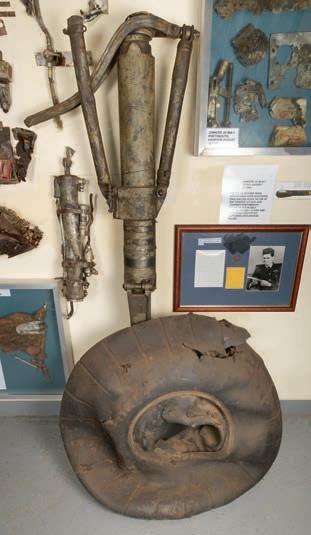
416* Spitfire P9364. Relics recovered from Spitfire P9364 shot down on 27 September 1940, the pilot Sergeant Ernest Scott was reported ‘missing’ and it took 51 years before he was finally laid to rest, the collection includes the right-hand side of the cockpit and undercarriage warning plate plus oxygen jack stamped ‘Scott’, part of the instruments, and the emergency undercarriage pressurised cylinder, elevator trim mechanism, remains of his May West inner tube and pistons and crankshaft, presented in a glazed display case, 84.5 x 62 cm Provenance: Tonbridge Battle of Britain Museum, Malcolm Pettit.

Ernest Scott (1917-1940) was born in Balby, Doncaster and a native of Mansfield, Nottinghamshire. He was educated at St Peter’s School, Mansfield and St John’s College, York. He joined the RAF in 1935 and in 1938 trained as a pilot at 15 FTS, Lossiemouth.
Scott arrived at 12 Group Pool on 24 February, Aston Down and after converting to Spitfires, he was posted to 222 Squadron at Duxford. He served with the squadron at the start of the Battle of Britain and on 3 September 1940 he claimed a Do17 and a Me109 destroyed. On the 5th a probable Me110 and Me109, on the 7th he destroyed a Me109. On the 9th probably destroyed another and on the 11th shot down a He111, but had to return to Hornchurch with his hood shattered after attacking a Me109 on the same day. On the 27 September, Scott claimed a Me109 destroyed but he himself failed to return from an operational sortie in the afternoon and was reported ‘missing’. His Spitfire, P9364 crashed at Greenway Court Road, Hollingbourne, he had been shot down by Luftwaffe ace Major Werner Mölders of JG51. Scott was commemorated on the Runnymede Memorial as having no known grave.

After a failed attempt to excavate the aircraft in 1975, Malcolm Pettit and Al Brown finally excavated the Spitfire in 1990 having traced Sergeant Scott’s brother, Albert. An account of the excavation can be found on the museum’s website but Malcolm Pettit recounts
‘The late Al Brown, god bless him, believe me this man was a god in the aeroplane archaeology world, we worked together on this one. In the past, we had tried many times to get Sergeant Scott recovered, but the farmer at that time had been told that it was the wish of the pilots family that he be left where he crashed, this we knew was not true, as they did not know who the pilot was. Al Brown was adamant it was Sgt Scott, but the problem was we could not trace his family and we desperately needed the backing of his family if we were to get anywhere, this went on for years. Then in 1990 Al had a breakthrough, he put an ad in the Nottingham Observer asking for any information on the whereabouts of Sgt Scott’s family. Al left my address for any reply, I soon had a reply from Sgt Scott’s brother Albert asking what I knew about his brother, I replied to his letter and I gave him my telephone number.
A couple of days later I got a phone call from Sgt Scott’s brother Albert, he asked what I could tell him about his missing brother Ernest Scott. When I told him I knew where he was, he broke down and cried. He then told me that his mother had been told that her son had gone missing over the Wash, off the East Coast. The sad thing is Sgt Scott’s mother died in 1971, not knowing what had happened to her son.
Al Brown had a copy of the Kent Police reports of downed RAF Fighters, which clearly stated Spitfire P9364 had crashed at Greenway Court Hollingbourne. Two days later Albert came down to see me and I took him to Greenway Court and showed him the field where his brother’s remains were buried, or missing no known grave. Albert was in tears, he could not believe it, how cruel the authorities had been to his mother, after all her son had given his life in defence of his country. I took Albert to the farmhouse to see the land owner Hughie Batchelor who was not the easiest of man to deal with. I knocked on his door, the door opened and there stood a rough and ready-looking man. I explained who I was and told him who Albert was, Albert put his hand in his pocket and pulled out a photo of his brother and said, “please sir can you let this man recover my brother’s Spitfire and his remains”. Batchelor replied, have you got a JCB? I replied no, he said I have, you can use that and I have a driver who can do it tomorrow Saturday. We both left very happy, when we got back to Tonbridge I dropped Albert off at his hotel and went home. As I walked in my front door my wife said Hughie Batchelor has phoned and said you are not to go anywhere near that field on Saturday.
I had to phone Albert and tell him what Batchelor had said, he was heartbroken. I told Albert I could do no more, he would have to write to the powers that be. He went back home to Mansfield and started writing, in the end, he wrote to Prince Charles and a few days later it happened. The Police cordoned off the whole area and the RAF recovery moved in, they dug out the remains of Sgt Scott and his Spitfire P9364, I think it was November 1990. The end of the story is, in January 1991 in Margate Cemetery Kent, Sgt Scott was finally laid to rest with full military honours, I attended Sgt Scott’s funeral and met many of his old mates from 222 Squadron, even his rigger who was the last man to strap him into his cockpit and see him alive.’
See lots 417, 478, 481 and 544.
(1) £2,000 - £3,000
417* Spitfire P9364. Relics recovered from Spitfire P9364 shot down on 27 September 1940, the pilot Sergeant Ernest Scott was reported ‘missing’, including a packet of white absorbent lint by Southalls Birmingham Ltd in original packaging, datum longeron, part of an instrument (probably gun hydraulic), presented in a glazed display case 72 x 62 cm


Provenance: Tonbridge Battle of Britain Museum, Malcolm Pettit.
See lots 416, 478, 481 and 544.
(1) £1,000 - £1,500
418* Messerschmitt Me110C-1. Relics recovered from Messerschmitt Me110C-1, probably shot down by Flight Lieutenant James Brindley Nicolson VC, DFC over North Baddesley, including a data plate dated 19 March 1940 and other items, presented in a glazed display case 92 x 123.5 cm
Provenance: Tonbridge Battle of Britain Museum, Malcolm Pettit.
There appears to be a discrepancy about the date of this action, either 13 or 16 August 1940. The aircraft was recovered in a dig by Malcolm Pettit circa 1977 after his lifelong friend Al Browne passed on details of the crash site.

See lot 415, 435, 436, 437 and 471.
(1) £2,000 - £3,000
Each lot is subject to a Buyer’s Premium of 20% (Lots marked * 24% inclusive of VAT @ 20%)
419* Hurricane P2542. Relics recovered from Hurricane P2542 shot down in combat over Tonbridge on 14 September 1940, the pilot Sergeant Brimble was laid to rest in 1980 when the aircraft was excavated, including the remains of an Irvin parachute, an LNER railway ticket from Furlough York to Church Fenton, plus a £1 note

Provenance: Tonbridge Battle of Britain Museum, Malcolm Pettit.
John Joseph Brimble a native of Knowle, Bristol (1915-1940) joined the RAFVR in 1938 as an Airman and untrained pilot, he was called to full-time service on 1 September 1939 and posted after training to No 4 Ferry Pilot Pool on 16 May 1940. Brimble was shot down in combat over Tonbridge on 14 September 1940 whilst serving with 73 Squadron. His Hurricane P2542 came down at Parkhouse Farm, Chart Sutton near Maidstone. An eyewitness account on the ground saw a Hurricane diving, apparently out of control, then momentarily pulling up before diving at full throttle and burying itself into a meadow.
The aircraft was not identified at the time and partial remains were buried at Bell Road cemetery, Sittingbourne as 'an unknown airman'. Brimble was commemorated on the Runnymede Memorial.
Postwar research led to the realisation that the remains were that of Brimble and a named headstone was installed. The crash site was excavated on 14 September 1980 and more substantial remains were found (in the cockpit). His parents had passed away by this time but his only living relative Donald William Brimble was traced and after consultation with the Commonwealth War Graves Commission, it was decided that the original grave and remains should be left undisturbed.

The 1980 remains of Sergeant Brimble were buried with full military honours at Brookwood, Woking, Surrey on 16th October 1980 with his brother present.
See lot 553.
(1) £1,000 - £1,500
420* Junkers Ju88. Relics recovered from Ju88A of 5/kg76 shot down over Ide Hill, Kent on 18 August 1940 (The Hardest Day) all crew killed, including cockpit clock dial by R. Euss, Berlin and other items, presented in a glazed display case, 55.5 x 44 cm Provenance: Tonbridge Battle of Britain Museum, Malcolm Petitt.

Ju88A of 5/ KG76 was shot down on 18 August 1940 by Flight Lieutenant James Gilbert Sanders of 615 Squadron, Pilot Officer Adrian Francis Laws, James Joseph “Orange” O’Meara and Ernest George Gilbert of 64 Squadron, Flight Lieutenant Peter Malam Brothers and Pilot Officer Boleslaw Wlasnowolski of 32 Squadron after attacking Kenley Airfield at 13.30. The aircraft crashed at Ide Hill and Oberfw
A. Eichhorn, Stabsfw
H. Vetter, Fw. K. Geier and Gefr K. Shuthan were all killed. This collection was given to Malcolm Pettit in the 1990s by a family friend who was the gardener at the crash site.
(1) £300 - £500
422* Hurricane P3166. Relics recovered from Hurricane P3166 flown by Group Captain Peter Townsend CVO, DSO, DFC & Bar, which crashed at Bedgbury Park, near Badgers Oak, Goudhurst after a dogfight over Tunbridge Wells on 31 August 1940, Townsend bailed out but was wounded on the foot, including Baker light bulb holder (from a reflector sight), fragments of armoured wind shield, Airinlet brass plaque, cowling fastener, battery casing and other items, presented in a glazed display case, 56 x 55 cm Provenance: Tonbridge Battle of Britain Museum, Malcolm Pettit.
Group Captain Peter Townsend CVO, DSO, DFC & Bar was born in Rangoon, he joined the RAF in 1930 and trained at RAF Cranwell, he was commissioned Pilot Officer in 1935 and on graduation joined No1 Squadron at RAF Tangmere, he advanced to Flight Lieutenant in 1939.
The first enemy aircraft to crash on English soil during WWII was shot down by Hurricanes from No 43 Squadron, RAF Akrington in Northumberland on 3 February 1940. One of the pilots was Peter Townsend, and the Heinkel 111 of 4.KG 26 came down near Whitby.
On 31 August 1940 Hawker P3166 of 85 Squadron flown by Townsend was destroyed in combat operations during a fight with Me110s over Tunbridge Wells. Townsend was shot down and wounded on the left foot by a cannon shell which went through the glycol tank and exploded in the cockpit. He bailed out and landed at Cranbrook Road, Hawkhurst and was later admitted to Hawkhurst Cottage Hospital before being transferred to Croydon. His Hurricane P3166, crashed at Bedgbury Park, near Badgers Oak, Goudhurst. Townsend continued to lead his men from the ground even with an amputated toe and returned to operational flying on 21 September 1940.
Malcolm Pettit dug these items by hand in the mid-1990s.

(1) £1,000 - £1,500
421* Messerschmitt Me110D. Relics recovered from Messerschmitt Me110D Stab / Erprobungsgruppe 210, shot down on 15 August 1940 after a bombing mission on the “Croydon Raid”, presented in a glazed display case, 57 x 51.5 cm
Provenance: Tonbridge Battle of Britain Museum, Malcolm Pettit. Messerschmitt Me110D Stab / Erprobungsgruppe 210 was shot down on 15 August 1940. The aircraft had been taking part in a bombing raid known as “the Croydon Raid” which was an attempt to destroy the aerodrome. It was shot down at 19.00 and crashed in flames at Bletchinglye Farm, Rotherfield, East Sussex. Both the pilot Hptmn Rubensdörffer and the gunner Ludwig Kretzer were killed.
(1) £300 - £500
423* Messerschmitt Me109 E-1. Relics recovered from Messerschmitt Me109 E-1 of 5/JG 27 which was shot down over Elham, Kent on 5 September 1940, comprising inert rounds and cord, presented in a glazed display case 26.5 x 43 cm

Provenance: Tonbridge Battle of Britain Museum, Malcolm Pettit.
Messerschmitt Me109 E-1 was shot down over Elham, Kent on 5 September 1940, whilst flying a fighter escort sortie to England. The aircraft crashed near Appledore Railway Station, Kent. It is reported the aircraft dived into the ground and buried itself in a deep crater and burnt out. The pilot Lieutenant Helmut Strobl was killed and his body was not discovered until 1987. His parents expressed their desire to have his remains repatriated to the family grave at Kolbnitz, Badgastein, Austria.
Malcolm Pettit swapped these items with Winston G. Ramsey, author of The Battle of Britain, Then and Now (1982).
(1) £200 - £300
 Lot 422
Lot 422
424* Hurricane P3208. Relics recovered from Hurricane P3208 which was shot down and crashed at Calcott Hill, Sturry, Kent on 18 August 1940, including a drogue parachute and other items, presented in a glazed display case 124 x 64 cm

Provenance: Tonbridge Battle of Britain Museum, Malcolm Pettit.
Hurricane P3208 was shot down on 18 August 1940 following an attack with JG26 near Calais. P3208 crashed at Calcott Hill, Sturry, Kent and Pilot Officer John Welburn Bland was killed. Bland was shot down by Oblt. G. Schoepfel of JG26. Schoepfel later wrote ‘suddenly I noticed a series of Hurricanes underneath me, they were using the English tactics of the period, flying in close formation of threes, climbing in a wide spiral, virtually sitting ducks’. Schoepfel dispatched four of the Hurricanes in as many minutes earning the award of Ritterkreuz (Knight’s Cross) on 11 September 1940.
These items were given to Malcolm Pettit by John Ellis in the mid to late 1990s, Ellis was in charge of this dig.
(1)
£1,000 - £1,500
425* Heinkel He III. Relics and related items from Heinkel He III H.3 of 3/KG1 which was shot down on 11 September 1940, including a bell push from a local farmhouse, a Voigntländer camera and a flying helmet, presented in a glazed display case 56 x 56 cm Provenance: Tonbridge Battle of Britain Museum, Malcolm Pettit.

Heinkel He III H.3 of 3/KG1 was shot down at 16.33 on 11 September 1940. The aircraft had been severely damaged in an attack on West India Docks (now Canary Wharf), it force landed at Stocks Green Road, Hildenborough, Tonbridge and the pilot Uffz. E. Kramer and crew were captured. The items included in the case were from the local farmhouse where the crew were detained.

Kramer surrendered his Luger to Sir Eric Macfadyen (1879-1966) who at the time served as a Captain in the 21st Company, Home Guard. Macfadyen lived in Hildenborough, Tonbridge he had previously been an MP for Devizes, Wiltshire from 1923-24.
(1) £2,000 - £3,000
426* Heinkel He III. Relics recovered from Heinkel He 111 H-2 5536 of 9/KG53 which crashed into the River Stour on 29 October 1940, including an oil gun from a gunners tool kit, inspection cover, part of saddle drum and petrol coupon numbered Lt Nr 32, presented in a glazed display case, 30.5 x 39.5 cm

Provenance: Tonbridge Battle of Britain Museum, Malcolm Pettit.
Heinkel He 111 H-2 5536 of 9/KG53 crashed in the mud flats at Parkestone Quay on the River Stour, Essex on 29 October 1940. The aircraft was flying from Roubaix to attack RAF Gravesend when it failed to pick up the Knickebein navigation beam and instead tried to find the targets by dead reckoning. The crew further hampered by the loss of electrical power could not operate the wireless. They became hopelessly lost and after jettisoning the bombs flew east in the hope they would fly over the Netherlands. They thought they were over the Netherlands and were unable to locate an airfield to land and bailed out. In fact, they were over East Anglia and all crew survived but were quickly captured. The items were recovered during an excavation by Malcolm Pettit in the 1990s.
See lot 432, 461 and 487.
(1) £300 - £500
427* Spitfire R6642. Relics recovered from Spitfire R6642 which was shot down on 15 October 1940, including parts of the seat, armoured windscreen and hood locking catch, presented in a glazed display case, 125.5 x 64 cm
Provenance: Tonbridge Battle of Britain Museum, Malcolm Pettit.
John Wilfred “Tommy” Lund (1919-1941) was born in Norton, Yorkshire, he was educated at Kingswood School near Bath and Oriel College, Oxford. Lund was a member of the University Air Squadron and was called up for service at the outbreak of WWII.
After completing training in 1940 he was sent to 5 OTU at Aston Down and converted to Spitfires, he joined 611 Squadron at Digby and on 2 July 1940 he shared the destruction of a Do17 and shared another on 21 August. Lund was then posted 92 Squadron at Biggin Hill on 2 October and was shot down by Me109s on 15 October, his Spitfire R6642 crashed into the sea off Bee Ness Jetty, Kent Reach, and Lund was rescued by HMS Nysan, he then went on to damage a Me109 on 1 December.
Lund was killed on 2 October 1941 whilst serving as a Flight Commander with 92 Squadron. He was the leader of three Spitfires which had carried out a low-level Rhubarb operation over Northern France. Whilst returning across the Channel the Squadron was attacked by Me109s from JG2 and all three were shot down. Lund’s Spitfire went down in flames and he was reported ‘missing’, Lund is commemorated on the Runnymede Memorial. (1) £2,000 - £3,000
428* Hurricane P3382. Relics recovered from Hurricane P3382 which was shot down on 6 September 1940, comprising fragments of the propeller hub, wooden propeller, main wheel tyre, the base of radio mast, underlever controller and cover for gun ports, presented in a glazed display case, 76 x 76 cm

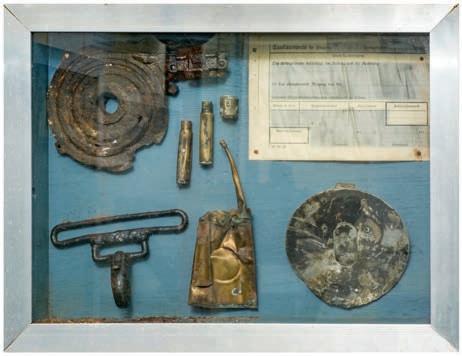
Provenance: Tonbridge Battle of Britain Museum, Malcolm Pettit.
Juliusz Topolnicki (1914-1940) was born in Kiwerce, Poland. He enrolled in the Cavalry Cadet School and after graduating went to the Fighter School at Deblin, he saw service with the Polish Air Force throughout the 1930s before being commissioned in the RAF. Following conversion training, he joined 601 Squadron at Tangmere on 18 August 1940. He shared the destruction of a Me109 on 6 September but was shot down over Mayfield, he bailed out, slightly wounded and was admitted to Leeds Castle Hospital. His Hurricane, P3382 crashed at Boyton Court, Sutton Valence, Kent. Topolnicki was killed in an air accident on 21 September 1940 when his Hurricane, L1894 struck another on take-off at Exeter. Topolnicki is buried in Exeter High Cemetery.
Malcolm Pettit dug this collection by hand in the 1970s.
(1) £1,000 - £1,500
Lot 427429* Hurricane P3536. Relic of one of the bank of Rolls Royce Merlin engines recovered from Hurricane P3536 which was shot down 13 October 1940, the cover stamped Rolls Royce and numbered D6988/1, 80 cm long, presented on a metal stand, total height including stand 110 cm Provenance: Tonbridge Battle of Britain Museum, Malcolm Pettit.
Jack Kenneth Ross (1916-1942) was born in London, he was awarded the Aero Certificate 16624 at Redhill Flying Club in 1938. He joined the RAFVR in 1939 and was called up for service on 1 September, after completing training Ross converted to Hurricanes and was posted to 17 Squadron at Kenley on 25 May serving in France before returning the RAF Tangmere. Ross probably destroyed a Me109 on 14 August 1940, shared a Ju88 on 21 August and shared a Do17 on 3 September. He shared another Do17 on 2 October but had to make a forced landing when he ran out of fuel.

On 6 October he shared in destroying another Do17 and on the 13th he was shot down by anti-aircraft fire during a patrol over Chatham. He bailed out, wounded and was admitted to Gravesend Hospital. His Hurricane, P3536 crashed at Rochester. Ross went on to claim a Do17 destroyed on 27 October and a Ju87 destroyed and probably a second on 11 November, sharing a Ju88 on 11 July 1941.
On 6 January 1942 Ross had to ditch his Spitfire P8393 in the Irish Sea during a convoy escort and was killed, he is commemorated on the Runnymede Memorial. The engine was excavated by Malcolm Pettit in 1990.

See lots 430, 431, 472, 473 and 484.
(1) £2,000 - £3,000
430* Hurricane P3536. Reflector gun sight recovered from Hurricane P3536 which was shot down on 13 October 1940, blackened metal frame with rubber mounts, 17 cm high Provenance: Tonbridge Battle of Britain Museum, Malcolm Pettit.

See lots 429, 431, 472, 473 and 484.
(1) £200 - £300
431* Hurricane P3536. Part of a propeller recovered from Hurricane P3536 which was shot down on 13 October 1940, laminated wood with remains of sheathed edge and yellow painted tip, 108 cm long


Provenance: Tonbridge Battle of Britain Museum, Malcolm Petitt.
See lot 429, 430, 472, 473 and 484.
(1) £500 - £800
433* Group Captain John Alexander Kent, DFC & Bar, AFC. Two contemporary handwritten accounts, the first written whilst serving at RAF Northolt with 303 “Polish” Squadron and dated 31 August 1940, the second dated 2 November 1940, whilst serving at RAF Biggin Hill with 92 Squadron which gives a descriptive account of destroying two Me109s on the 2 November (presumably written on the same day), ‘I held my fire until I was about 150 yards from one of the near pair of Messerschmitts and then let go with a long burst and the aircraft immediately dived straight down trailing a great cloud of smoke ...’ presented in a glazed frame with a period black and white photographic postcard of 303 Squadron, frame size 53 x 54 cm Provenance: Tonbridge Battle of Britain Museum, Malcolm Pettit.


Group Captain John Alexander “Kentski” Kent, DFC & Bar, AFC (1914-1985) was a Canadian fighter ace credited for no less than 13 aircraft destroyed, 3 probable and 3 damaged. He is considered one of the best young squadron leaders of WWII. He served throughout the Battle of Britain with 303 “Polish” Squadron stationed at RAF Northolt.
(1) £300 - £500
Provenance: Tonbridge Battle of Britain Museum, Malcolm Pettit.

See lot 426, 461 and 487.
(2) £500 - £800
432* Heinkel He III. Relics recovered from Heinkel HeIII H-2 5536 of 9/KG53 which crashed into the River Stour on 29 October 1940, comprising rudder mass balance weight, 83 x 71 cm plus a hydraulic plunger434* Messerschmitt Me110C. Tail wheel from Messerschmitt Me110C of 6/ZG26 which crashed near Platts Heath, Lenham, Kent on 18 August 1940, the rubber tyre by Continental numbered 380 x 150, approximately 38 cm






Provenance: Tonbridge Battle of Britain Museum, Malcolm Pettit. Messerschmitt Me110C of 6/ZG26 was shot down by Pilot Officer Maurice Hewlett Mounsdon of 56 Squadron whilst escorting bombers at 13.40 on 18 August 1940. The aircraft crashed at Platts Heath, Lenham and the crew were reported missing, believed killed.
(1) £200 - £300
436* Messerschmitt Me110C. Oxygen bottle recovered from Messerschmitt Me110C-1, probably shot down by Flight Lieutenant James Brindley Nicolson VC, DFC over North Baddesley, the oxygen bottle having exploded on impact now exposing the interior, the neck with various stamps and dated 21 May 1940, 38 cm high Provenance: Tonbridge Battle of Britain Museum, Malcolm Pettit. See lot 415, 418, 435, 437 and 471.
(1) £200 - £300
435* Messerschmitt Me110C. The undercarriage leg recovered from Messerschmitt Me110C-1, probably shot down by Flight Lieutenant James Brindley Nicolson VC, DFC over North Baddesley, with a warning data plate and Continental rubber wheel, approximately 180 cm long, the wheel approximately 78 cm diameter
Provenance: Tonbridge Battle of Britain Museum, Malcolm Pettit. See lot 415, 418, 436, 437 and 471.
(1) £500 - £800
437* Messerschmitt Me 110C. Part of the undercarriage door recovered from Messerschmitt Me110C-1 believed to have been shot down by Flight Lieutenant James Brindley Nicolson VC, DFC over North Baddesley, aluminium riveted construction, 53 cm long, together with part of the brakes system with data plate stamped Muster Grösse 275, Z. Nr 8 2126 A1, Werk Nr 155726, 28 cm diameter
Provenance: Tonbridge Battle of Britain Museum, Malcolm Pettit. See lot 415, 418, 435, 436 and 471.
(2) £200 - £300
438* Heinkel He III P. Relics recovered from Heinkel III P which was shot down by 602 Squadron on 16 August 1940, the items were recovered by a Mr Clout from the crash site at Honeysuckle Lane, High Salvington, Worthing, West Sussex, comprising a data plate by Nordeutsche-Dornier Werke Lizenze Heinkel, H.111. P.2 Z Nr 8.111535, Bau Nr 537, W Nr 1582, Abnahme 3.39, plus a fuse stamped 40V50A, presented in a glazed display case with historical information, 45.5 x 29 cm
Provenance: Tonbridge Battle of Britain Museum, Malcolm Pettit. Heinkel He 111P of 7 Staffel./ Kampfgeschwander 55 and was shot down at 17.05 after a bombing sortie to attack Great West aerodrome (now Heathrow Airport), the aircraft crashed at Rogers Farm, Honeysuckle Lane, High Salvington, Worthing, two crew were killed and three captured.
(1) £300 - £500
439* Spitfire P9372. Part of an airman’s navigational map recovered from Spitfire P9372 which was shot down on 9 September 1940, the map produced by the Ordnance Survey Office Southampton 1933, stamped with the dates 21 Aug 1937, 25 Jan 1938, 23 Feb 1938 and annotated by Pilot Officer William Charles Watling in pencil on the right-hand side, presented in a glazed display case 61 x 43 cm

Provenance: Tonbridge Battle of Britain Museum, Malcolm Pettit. See lots 450, 452, 494, 507 and 508.

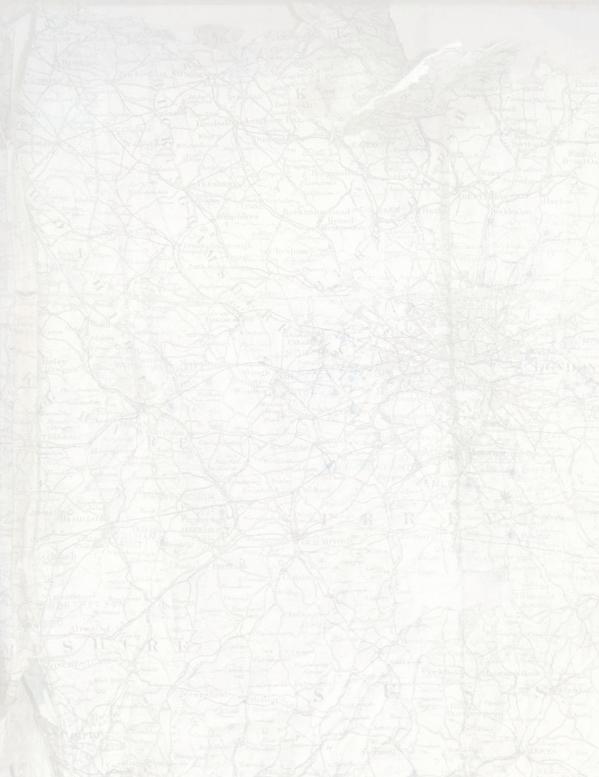
(1) £200 - £300
Each lot is subject to a Buyer’s Premium of 20% (Lots marked * 24% inclusive of VAT @ 20%)
440* Hurricane L1965. Relics recovered from Hurricane L1965 which was shot down on 30 August 1940, Pilot Officer

Colin Dunstan Francis was killed, including Rolls Royce Merlin Engine data plate, indication direction data plate, and other items, presented in a glazed display case 62 x 61.5 cm, together with a letter from Group Captain Tom Gleave to Al Brown, dated 14 April 1974 in which he gives a detailed insight of this action and a record of Francis’s aerial victories

Provenance: Tonbridge Battle of Britain Museum, Malcolm Pettit. Colin Dunstan Francis (1921-1940) was a native of Stoke d’Abernon, Surrey, he joined the RAF in April 1939 and after completing training he converted to Hurricanes and was posted to 235 Squadron at Kirton-in-Lindsey. The squadron moved to Kenley on 29 August 1940 and the following morning Francis took off in a section of three aircraft to join the rest of the squadron in attacking a force of bombers, which was escorted by some thirty fighters. It was his first encounter with the Luftwaffe and he was shot down and reported ‘missing’. His name appears on the Runnymede Memorial.
In 1981 Malcolm Pettit and a team of excavators found an aircraft at Wrotham, on land which had been Percival’s Farm in 1940. It proved to be Hurricane L1965 and Francis’ remains were still in the cockpit. He was later buried with full military honours at Brockwood Military Cemetery.
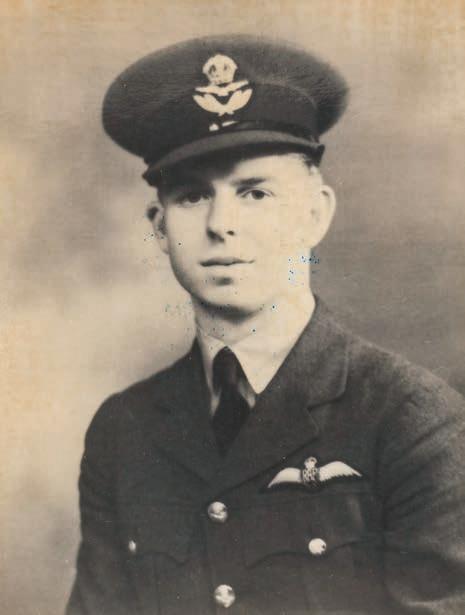
See lots 441 and 509.
(1) £2,000 - £3,000
441* Hurricane L1965. The rudder recovered from Hurricane L1965 which was shot down on 30 August 1940, Pilot Officer Colin Dunstan Francis was killed, aluminium frame with traces of canvas and paint, approximately 130 cm long

Provenance: Tonbridge Battle of Britain Museum, Malcolm Pettit.
See lots 440 and 509.
(1) £2,000 - £3,000
442* Junkers Ju 87 ‘Stuka’. Part of a cockpit dive brake control recovered from Junkers Ju 87-B1 which was shot down on 18 August 1940, with data plate and composite ball grip, 37 cm long

Provenance: Tonbridge Battle of Britain Museum, Malcolm Pettit.
Junkers Ju 87-B1 was shot down by British fighters during a sortie over the Channel at 14.30 on 18 August 1940 (The Hardest Day), the aircraft crashed at Chidham and both crew were reported missing.
The automatic pull-up dive brakes were positioned under each wing to ensure that the aircraft recovered from its attack dive even if the pilot blacked out from the high g-forces.
See lot 443.
(1) £2,000 - £3,000
443* Junkers Ju 87 ‘Stuka’. Oil pump recovered from Junkers Ju 87-B1 shot down over the Channel on 18 August 1940, with data plates stamped Gerät Nr. 127 152 A 2, Werk Nr. 1428477, Anforderz. Fl 22460-3, 37 cm long
Provenance: Tonbridge Battle of Britain Museum, Malcolm Pettit. See lot 442.
(1) £500 - £800
444* Junkers Ju 88. Relics recovered from Junkers Ju 88 A1 which crashed at Folly Farm, South Holmwood, near Dorking on 27 September 1940, including oxygen mask with flexible pipe, flying helmet earpiece, part of seat harness, petrol filler cap, presented in a glazed display case, 47 x 36.5 cm


Provenance: Tonbridge Battle of Britain Museum, Malcolm Pettit.
On 27 September 1940 Junkers Ju 88 A-1 of 2 Staffel./Kampfgeschwader 77 crashed in flames at Folly Farm, Holmwood, near Dorking following an attack by British fighters after a sortie to London. The aircraft’s starboard engine set alight and one crew member was killed the other three survived having bailed out.
Malcolm Pettit joined Winston G. Ramsey on this particular dig and was given these items.
(1) £500 - £800
445* Junkers Ju 87 ‘Stuka’. Relics recovered from Junkers Ju 87 B-5518 shot down on 18 August 1940, including a saddle drum gun magazine (MG15), pilots breathing apparatus comprising oxygen mask with rubber hose and oxygen tank by Draeger numbered 143622 with data plate stamped with Werk Nr 142134 and dated 23 August 1939, presented in a glazed display case, 61.5 x 62 cm

Provenance: Tonbridge Battle of Britain Museum, Malcolm Pettit.
Junkers Ju 87 B-5518 was shot down by Sergeant Jim Hallowes of 43 Squadron during an attack on the airfields at Thorney Island, Ford and the radar station at Polling at 14.30 on 18 August 1940. The aircraft broke up in mid-air and crashed at Fishbourne Creek, near Chichester. Both the crew members bailed out and both were captured, the aircraft was destroyed. This aircraft was one of 18 lost by StG 77 on a day that became known as the “Massacre of the Stukas” and led directly to the Germans withdrawing their Ju87 units from the Battle of Britain.
(1) £2,000 - £3,000
446* Air Raid Siren. 1940/50s hand operated air raid siren by Secomak, Type 447, with original label by Service Electric Co Ltd, Serial No 6912, finished in grey with wooden handle, working, 84 cm high

Provenance: Tonbridge Battle of Britain Museum, Malcolm Pettit. Other examples are displayed in museums for example the Imperial War Museum, London. (1) £200 - £300
447* Air Raid Precaution. WWII London Public Gas Cleansing Centre poster, printed in black, with instructions on what do in the event of a gas attack, published 5011/41-A218 lower left, two holes drilled where the poster has been affixed to the wall and general wear, 76 x 50.5 cm

Provenance: Tonbridge Battle of Britain Museum, Malcolm Pettit.
(1) £80 - £120
448* Hurricane P2680. Relics recovered from Hurricane P2680 shot down over Tonbridge on 9 September 1940, including a night fighter flash eliminator plate, presented in a glazed display case, 46 x 82.5 cm


Provenance: Tonbridge Battle of Britain Museum, Malcolm Pettit.
Hurricane P2680 was shot down in combat with a Dornier Do 17 and Me 109s over Tonbridge on 9 September 1940, the pilot Sergeant Richard Alfred Spyer of 607 Squadron bailed out slightly wounded. His Hurricane, P2680 crashed at Stilstead Farm, East Peckham.
Richard Alfred Spyer a native of Worcester Park, Surrey was born in 1917, he joined the RAF in 1939 and after completing training he was called up on 1 September 1939 and posted to 111 Squadron at North Weald on 25 September and then attached to 607 Squadron at Usworth on 31 May 1940 moving on to squadron at RAF Tangmere 8 September with the squadron. The following day Spyer was shot down in Hurricane P2680. After the Battle of Britain, Spyer went to the Mediterranean and was one of six Hurricanes to take off for Malta led by Flight Lieutenant MacLachlan. His Hurricane V7413 ran out of fuel and Spyer bailed out and was later picked up by a Sunderland flying boat.
Spyer was shot down and killed at Ta Kalo on 22 March 1941, whilst serving with 261 Squadron. He was one of eight Hurricanes to meet ten Ju88s with the loss of five Hurricanes, all pilots killed. Spyer is commemorated on the Malta Memorial.
The relics in the case were recovered by John Ellis for the Tonbridge Battle of Britain Museum.
(1) £300 - £500 Lot
449* Messerschmitt Me 109. Relics recovered from Messerschmitt Me 1909 E1 of 6 / JG3 which was shot down over Thanet on 26 August 1940, including remains of the pilots schwimmweste with printed stores label dated 1940 and werknummer 12442, a section of uniform including shoulder epaulettes, perspex from the wind shield and other items, presented in a glazed display case with copied combat report and other research, 63 x 52.5 cm Provenance: Tonbridge Battle of Britain Museum, Malcolm Pettit.
Messerschmitt Me 109 E-1 of 6 / JG3 was shot down by Flying Officer Ken Marston of 56 Squadron on 26 August 1940. The aircraft was hit on the port wing and radiator and then dived into the clouds, the pilot Uffz Fritz Buchner unsuccessfully attempted to bail out. The Me109 crashed at Stuart’s Farm, St Nicholas-at-Wade and Buchner was reported missing until 1984.
The crash site was excavated in 1984 and the main wreckage was discovered 35-40 feet underground with the remains of the pilot still in the cockpit. Buchner was laid to rest in the presence of serving members of his family with full military honours in the German Cemetery at Cannock Case in 1987. Please note the oxygen bottle and parachute harness were added to this display at a later date and although unconfirmed it is understood they were recovered from the same dig.
(1) £2,000 - £3,000
450* Spitfire P9372. Relics recovered from Spitfire P9372 which was shot down on 9 September 1940, including first aid kits and canvas bag, stamped ‘First Aid Outfit Aircraft’ contents card, RAF labels and other items, presented in a glazed display case, 49.5 x 49 cm

Provenance: Tonbridge Battle of Britain Museum, Malcolm Pettit.
Spitfire P9372 was shot down at 17.30 on 9 September 1940. Pilot Officer William Charles Watling bailed out into the sea off Winchelsea Beach, his face and hands were badly burned and P9372 crashed near East Guldeford, near Rye.

P9372 was excavated by Malcolm Pettit in 1990. See lots 439, 452, 494, 507 and 508.
(1) £500 - £800
451* Compressor. Compressor Pump, type A.V.A-M with brass plaque stamped ‘Replenish with oil DTD 72 Every 10 Hours’ numbered 106 428, the cap stamped CX54688, 17 cm high Provenance: Tonbridge Battle of Britain Museum, Malcolm Pettit.


(1) £100 - £150
452* Spitfire P9372. Wing leading edge recovered from Spitfire P9372 which was shot down on 9 September 1940, aluminium with a 20 mm cannon shell damage which has been patched, 39 cm long Provenance: Tonbridge Battle of Britain Museum, Malcolm Pettit.

See lots 439, 450, 494, 507 and 508.
(1) £200 - £300
453* Westland Whirlwind P6966. Aircraft thermostat recovered from Westland Whirlwind P6966 which crashed on 7 August 1940, with brass plate stamped Teddington Type B.G.A. 3759 No 803100/N, approximately 20 cm long, presented in a glazed display case, 26 x 46 cm
Provenance: Tonbridge Battle of Britain Museum, Malcolm Pettit.
Westland Whirlwind P6966 crashed on 7 August 1940. A tyre burst on takeoff and damaged the undercarriage. The pilot Irving Francis McDermott of 263 Sqaudron bailed out and landed safely and the aircraft crashed on Lanton Farm, Dunmore Moss, near Stenhousemuir, Stirlingshire.
P6966 was excavated in 1979 by John Ellis and the items were donated to the museum. When the aircraft was found, the reason for the burst tyre was that a Hurricane wheel had been fitted and this proved to be incompatible with the Whirlwinds’ faster operating speed on the ground. See lot 454.
(1) £500 - £800
454* Westland Whirlwind P6966. All that remains of a cannon recovered from Westland Whirlwind P6966 which crashed on 7 August 1940, the 20 mm cannon deactivated and in excavated relic condition stamped Hispano 20mm Mk1 No A195 B.M.A.R.C. Birkigt Patents, approximately 253 cm long
Provenance: Tonbridge Battle of Britain Museum, Malcolm Pettit. See lot 453.
(1) £3,000 - £5,000
455* Spitfire X4418. Relics recovered from Spitfire X4418 flown by Flying Officer C.B.F. Kingcombe who was shot down on 15 October 1940, presented in a glazed display case with copy medals comprising DFC, DFM, DSO, VC and 1939-45 Star with Battle of Britain clasp (copy) plus a section of RAF tunic with cloth brevet and DFC ribbon bar, the case 56 x 50 cm


Provenance: Tonbridge Battle of Britain Museum, Malcolm Pettit. Charles Brian Fabris Kingcome (1917-1994) was a WWII ace credited with a final score of eight and three shared destroyed plus a score of probable and damaged. On 17 October 1940, he was shot down by Me109s. Kingcome bailed out wounded and was admitted to the Royal Naval Hospital at Chatham, his Spitfire X4418 crashed at Wybornes Farm, High Halstow.
(1) £200 - £300
456* Messerschmitt Me 109. Relics recovered from a Me109 which was shot down on 29 September 1940, including part of a tail fin with traces of swastika insignia, part of the engine casing, inert 7.92 rounds plus a section of silk parachute, presented in a glazed display case, 81 x 59.5 cm

Provenance: Tonbridge Battle of Britain Museum, Malcolm Pettit.
Messerschmitt Me109 E was flown by Feldwebel H. Hubel who was killed when his aircraft was shot down at 13.45 by Pilot Officer Ronald Berry of 603 Squadron on 29 September 1940. The aircraft crashed at Kennards Farm, Leigh, Tonbridge and the section of parachute included in the display was bequeathed to Malcolm Pettit by a friend who served in the Home Guard.
(1) £2,000 - £3,000
Provenance: Tonbridge
(2) £300 - £500

Provenance: Tonbridge Battle of Britain Museum, Malcolm Pettit. William Henry Rhodes-Moorhouse, DFC (1914-1940) was a WWII RAF fighter ace. His father was William Barnard Rhodes-Moorhouse VC was a WWI RFC ace who was killed in action.
Flight Lieutenant William Rhodes-Moorhouse was the very epitome of what many have thought a Battle of Britain pilot to be, debonair, handsome and courageous. In the case of William Rhodes-Moorhouse, he was also extremely wealthy. On 6 September, he was attacked by Me109s and was shot down, he was initially reported ‘missing’ but his crash site was located by his mother and widow. William Rhodes-Moorhouse’s father-in-law Sir Stephen Demetriadi organised and supervised the operation to recover William’s body near High Broom’s railway viaduct, Tunbridge Wells. RhodesMoorhouse is buried in a private cemetery in the grounds of his family’s former home, Parnham House, Dorset alongside his father.
(1) £300 - £500
459* Air Commodore Alan ‘Al’ Christopher Deere, DSO, OBE, DFC & Bar. A typed account titled Biggin Hill, A Historical Milestone, signed in ink by Al Deere and dated 15 May 1943, the documents give a descriptive insight into the Al Deere’s time a Wing Commander and starts ‘perhaps the highlight of my tour as Wing Leader was the destruction in 1943 of the 1000th enemy aircraft shot down by pilots operating from his famous Battle of Britain airfield ...’, framed and glazed, frame size 47 x 54 cm



Provenance: Tonbridge Battle of Britain Museum, Malcolm Pettit.

Air Commodore Alan Christopher Deere, DSO, OBE, DFC & Bar (1917-1995), was a New Zealand WWII fighter ace, known for several near-death experiences during WWII and author of ‘Nine Lives’.
By the end of the war, he was credited for the destruction of 22 enemy aircraft, ranking him the second-highest-scoring New Zealand fighter ace. Later research has seen his total revised to 17 victories.
(1) £200 - £300
457* Hurricane Wheels. Pair of Hurricane wheels, each with rubber tyre stamped 7.50-10 1/4, the hubs stamped serial no JF, 113112, approximately 55 cm diameter Battle of Britain Museum, Malcolm Pettit. 458* Hurricane P8818. Relics recovered from Hurricane P8818 which was shot down on 6 September 1940, the pilot Flight Lieutenant William H. Rhodes-Moorhouse was killed, including inert Browning .303 rounds and other items, presented in a glazed display case, 56 x 50 cm460* Supermarine Spitfire Mk1 Cockpit Section. An impressive Spitfire Mk1 ‘92 East India Squadron’ cockpit, the cockpit has built by Malcolm Pettit in aluminium to an extremely accurate and high standard and contains original artefacts which have been collected over the years, the control column is built up from various crash sites, with a complete instrument panel, control column, rudder pe dals, undercarriage selector, throttle quadrant, Sutton harness release, radio tuner, pilot seat, Kygas primer, engine starter, compass, hood, complete bullet-proof windshield, reflector sight, cockpit door, approximately 270 cm long Provenance: Tonbridge Battle of Britain Museum, Malcolm Pettit.
The front perspex was recovered from Spitfire P7350, which was shot down on 25th October 1940 The pilot was Pilot Officer Ludwik Martel, a Polish man serving with 603 Squadron from RAF Hornchurch. Martel managed to fly the Spitfire down through 16,000 feet of thick cloud, in pain and fighting to stay conscious, to force land, wheels-up, in a field near Hastings.
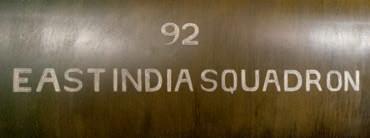

A rudder pedal, gun button on the control column and also the base of the control column plus parts of the pilot’s seat were recovered from Spitfire P7539 flown by Pilot Officer Romney John Mather of 66 Squadron Thong Lane Gravesend, who was shot down at 08.30 am on 27 October 1940.

Two cockpit hood runners were recovered from Spitfire R6642 flown by Pilot Officer ‘’Tommy’’ Lund of 92 Squadron, RAF Biggin Hill. Lund bailed out and came down into the sea, he was rescued by HMS Nysan

The throttle box undercarriage selector radio tuner and one rudder pedal were recovered from Spitfire P9372. This aircraft was damaged in the Battle of France on 24 May 1940, it was being flown at that time by Pilot Officer Tony Bartley of 92 Squadron. P9372 was eventually shot down in combat with Me109s on 9 September 1940, Pilot Officer Bill Watling of 92 Squadron was at the controls. He was severely burned on his hands and face when he came down into the sea at Winchelsea.
Parts of the cockpit door and door frame, the cockpit lamp holder and frame holding the perspex were recovered from Spitfire R6597, flown by Pilot Officer Arthur Roy Watson of 152 Squadron, RAF Warmwell. R6597 was shot down by German Fighter Ace, Helmet Wick. Watson bailed out but fell dead when his parachute failed to open. It is said that his parachute was sabotaged (this is on record).
(1) £40,000 - £60,000
Each lot is subject to a Buyer’s Premium of 20% (Lots marked * 24% inclusive of VAT @ 20%)
Provenance:
Provenance: Tonbridge Battle of Britain Museum, Malcolm Pettit.
Hurricane R4181 was shot down over Chelmsford on 18 August 1940, the Pilot Officer John Basil Ramsay, 151 Squadron was reported ‘missing’ believed killed. The aircraft crashed at Holliwell Point just east of Burnham-on-Crouch.

Hurricane R4181 was excavated by Malcolm Pettit in 1983 and the remains of the pilot were found in the cockpit. Ramsay was buried with full military honours on 25 October 1983. See lot 463.




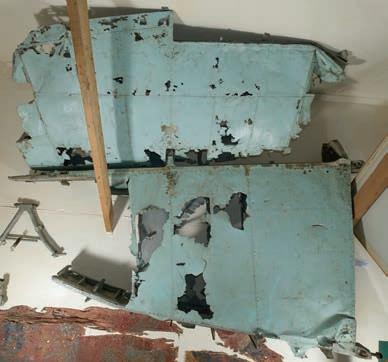
(1)
Provenance:
461* Heinkel He III. Remains of the tail recovered from Heinkel HeIII H-2 5536 of 9/KG53 which crashed into the River Stour on 29 October 1940, traces of light blue paint, in three sections Tonbridge Battle of Britain Museum, Malcolm Pettit. See lot 426, 432 and 487.464* Spitfire R6597. Part of the rudder of Spitfire R6597 which was shot down on 28 November 1940, canvas and aluminium construction, 44cm long, presented in a glazed frame, 62 x 62 cm
Provenance: Tonbridge Battle of Britain Museum, Malcolm Pettit.
Spitfire R6597 was shot down and crashed near Wareham, Dorset on 28 November 1940. Pilot Officer Arthur Roy Watson of 152 Squadron was the 56th and last victim of the Luftwaffe air ace Helmut Wick, who himself was shot down seconds later by Flight Lieutenant John Dundas, 609 Squadron. R6597 took off from RAF Warmwell to intercept an enemy bomber force and its fighter escort. Watson engaged the Messerschmitt Me109 fighter but was shot down. His Spitfire crashed at the village of Arne about sixteen miles east of RAF Warmwell. His body was recovered and returned to his family. Watson was buried at Nottingham Southern Cemetery on 14 December 1940.
(1) £1,500 - £2,000
465* Hurricane N2461. Relics recovered from Hurricane N2461 which was shot down on 18 August 1940, presented in a glazed display case 31 x 29 cm

Provenance: Tonbridge Battle of Britain Museum, Malcolm Pettit.
Hurricane N2461 was shot down by Me109s at 17.30 on 18 August 1940. The aircraft crashed at Wigmore and the pilot, Squadron Leader Michael Crossley of 32 Squadron bailed out unhurt.
(1) £100 - £150
466*
recovered from Hawker Hurricane P3080 flown by Flying Officer Arthur Dean Nesbitt who was shot down 15 September 1940, including control lever, course and speed computer calculator and coupling switch, presented in a glazed display case 65 x 51 cm
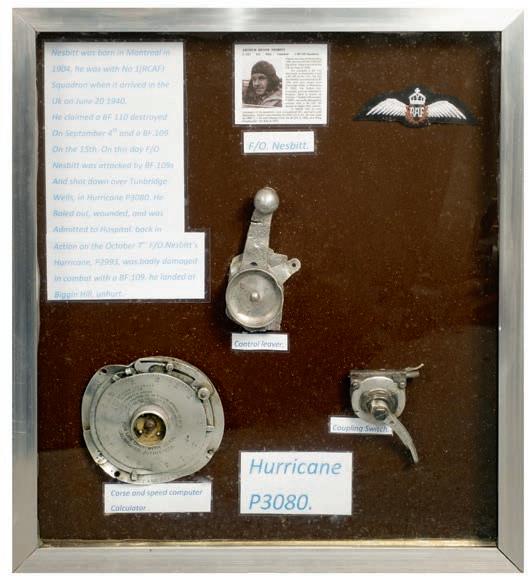
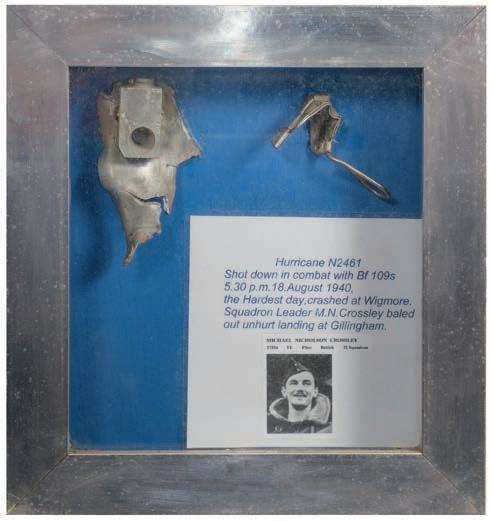
Provenance: Tonbridge Battle of Britain Museum, Malcolm Pettit. See lot 403.

(1) £700 - £1,000
29 x 101.5 cm
Provenance: Tonbridge Battle of Britain Museum, Malcolm Pettit.
Blenheim R3771 of 15 Squadron was shot down in error by British fighters on 4 August 1940, being mistakenly taken for a Ju88. The aircraft crashed at Norduck Farm, Alesbury, all three crew were killed. The crash site was excavated by Malcolm Pettit in 1978.
(1) £500 - £700
468* Hurricane L1298. Relics recovered from Hurricane L1298 which was shot down on 10 October 1940, including a cut throat razor, pepper shaker and other items, presented in a glazed display case, 25 x 51.5 cm



Provenance: Tonbridge Battle of Britain Museum, Malcolm Pettit.
Hurricane L1928 crashed at 15.55 on 10 October 1940. The aircraft crashed into houses at Albion Place, Maidstone, Kent. The cause of the crash was never established (although most likely oxygen failure) but the items in the case were found in the cellar of the house where the pilot Flight Sergeant Harold Henry Allgood of 253 Squadron crashed. The residents were sheltering in the cellar at the time of the crash, hence the aircraft wreckage access to this crash site was gained after the houses were demolished along Albion Street in the 1970s. Flight Sergeant Allgood and three women and five children were all killed in the crash. Allgood had been patrolling at 20,000 feet when one of the aircraft from the squadron went into a steep dive bursting into flames and crashed into numbers 59 and 61 Albion Street. The civilians are all buried at Maidstone Municipal Borough Cemetery.
(1)
£300 - £500
470* Messerschmitt Me 109. Relics recovered from Messerschmitt Me109 E-4 of 8/JG26 which was shot down on 25 October 1940, including aircraft fabric painted with RAF “kill icon” roundels, data plate and other items, presented in a glazed display case, 92.5 x 123 cm
Provenance: Tonbridge Battle of Britain Museum, Malcolm Pettit.
Messerschmitt Me109 E-4 of 8/JG26 was shot down on 25 October 1940. The aircraft had been acting as top cover for a bomber formation when the unit was attacked by Spitfires of 95 Squadron. The pilot Feldwebel Josef Gartner bailed out and the aircraft crashed at Congelow Farm, Yalding, Kent. Gartner later recollects “I saw a shadow behind me to the left and suffered 6-8 hits in my right wing. Immediately a white streak formed and I knew that my cooling system had been hit. I tried to weave about, hoping to turn the cards on the Spitfire, but my own engine got warmer and warmer due to the loss of coolant. The aircraft became slower and almost unmanoeuvrable, then my opponent got me full on, flames shot out of the engine and I had to jump”.
(1) £3,000 - £5,000
469* Hurricane V6699. Relics recovered from Hurricane V6699 which was shot down on 28 September 1940, including coins and an inert round, presented in a glazed display case 49.5 x 40.5 cm

Provenance: Tonbridge Battle of Britain Museum, Malcolm Pettit.
Hurricane V6699 was shot down over Ticehurst, Sussex at 13.55 on 28 September 1940 and crashed in a paddock at Earls Down, Red Pale, Dallington. Flying Officer Peter Guerin Crofts bailed out but his parachute failed to open and he fell to his death at Redpale Farm. Crofts is buried in All Saints’ churchyard, Tilford, Surrey and there is a memorial cross on the spot where he fell.
Hurricane V6699 was excavated by Malcolm Pettit in 1975.
(1)
£200 - £300
471* Messerschmitt Me 110C. Wing radiator recovered from Messerschmitt Me110C-1 probably shot down by Flight Lieutenant James Brindley Nicolson VC, DFC over North Baddesley, in relic condition, 97 cm long
Provenance: Tonbridge Battle of Britain Museum, Malcolm Pettit. See lot 415, 418, 435, 436 and 437.
(1) £200 - £300
472* Hurricane P3536. All that remains of a Browning Machine Gun recovered from Hurricane P3536 which was shot down on 13 October 1940, numbered B2 4103, deactivated and in excavated relic condition, 98 cm long


Provenance: Tonbridge Battle of Britain Museum, Malcolm Pettit.
See lot 429, 430, 431, 473 and 484.
(1) £1,500 - £2,000
473* Hurricane P3536. All that remains of a Browning Machine Gun recovered from Hurricane P3536 which was shot down on 13 October 1940, stamped Browning MkII B.10.786 BSA 1938, deactivated and in excavated relic condition, 98 cm long
Provenance: Tonbridge Battle of Britain Museum, Malcolm Pettit.
See lot 429, 430, 431, 472 and 484.
(1) £1,500 - £2,000
474* Spitfire Propeller. Watts two-blade propeller, a type used on very early Spitfires and Hurricanes, finished in black with yellow painted tips, the boss stamped ‘DII 25 82 ... AG 32 C8 38, restored, approximately 347 cm long and extremely scarce

Provenance: Tonbridge Battle of Britain Museum, Malcolm Pettit.
The Watts propeller was designed by Dr H C Watts M.B.E., D.Sc., M.Inst. C.E., F.R.Ae.S.
Dr Watts was educated at Bristol University from 1911-14 and worked as a Technical Assistant for the Bristol Aeroplane Company where he was in charge of the design and supply of aircraft propellers at the Air Ministry during WWI. In 1932 he joined the Airscrew Company, Weybridge, Surrey as technical director.
The Airscrew Company manufactured the two blade propellers for the early Hurricanes and Spitfires. Watts was also the author of the Design of Screw Propellers: With Special Reference to Their Adaption of Aircraft.
(1) £3,000 - £5,000
Each lot is subject to a Buyer’s Premium of 20% (Lots marked * 24% inclusive of VAT @ 20%)
475* Dornier Do 17 Z 3. Relics recovered from Dornier 17Z-3 which was shot down by Wing Commander Frederick “Taffy” Higginson on 16 August 1940, including a relic 9 mm Luger and other items, presented in a glazed display case 61.5 x 62 cm


Provenance: Tonbridge Battle of Britain Museum, Malcolm Pettit. See lots 405, 406, 407, 476, 480, 485 and 547.
(1)
£2,000 - £3,000
476* Dornier Do 17. Dornier Do 17. 20mm Cannon Drum recovered from Dornier 17Z-3 which was shot down by Wing Commander Frederick “Taffy” Higginson on 16 August 1940, stamped FL.49200, T60C FF, Nr 09255, 26 cm diameter


Provenance: Tonbridge Battle of Britain Museum, Malcolm Pettit. See lots 405, 406, 407, 475, 480, 485 and 547.
(1)
£300 - £500
477*
Armoured Plate recovered from Spitfire P7539, Pilot Officer John ‘Johnnie’ Romney Mather was killed on 27 October 1940 when his Spitfire crashed at Half Moon Lane, Hildenborough, the plate dated 1939, 45 x 74 cm
Provenance: Tonbridge Battle of Britain Museum, Malcolm Pettit. See lots 401, 410 and 503.
(1) £500 - £800
Mather pictured on left Spitfire P7539.478* Spitfire P9364. Relics recovered Spitfire P9364 which was shot down on 27 September 1940, Sergeant Ernest Scott was reported ‘missing’, including a crankshaft presented on a stand, total height 100 cm


Provenance: Tonbridge Battle of Britain Museum, Malcolm Pettit. See lots 416, 417, 481 and 544.
(1) £500 - £800
480 Dornier Do 17. Engine Cowling recovered from Dornier 17Z3 shot down by Wing Commander Frederick “Taffy” Higginson on 16 August 1940, aluminium rivetted construction 74 x 71 cm long
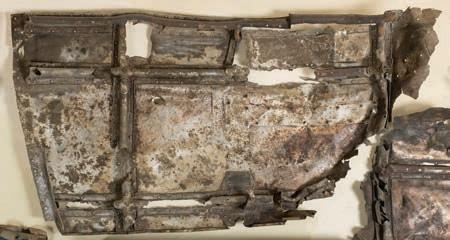
Provenance: Tonbridge Battle of Britain Museum, Malcolm Pettit. See lot 405, 406, 407, 475, 476, 485 and 547

(1) £400 - £600
479* Messerschmitt Me110. Relics recovered from Messerschmitt Me110 C-7 which was shot down on 7 October 1940, including the remains of a parachute and d-ring, some items presented in a glazed display case, 41 x 41.5 cm

Provenance: Tonbridge Battle of Britain Museum, Malcolm Pettit.
Messerschmitt Me110 C-7 was shot down at 17.00 on 8 October 1940. The aircraft had been escorting a bombing raid on the Westland aircraft works at Yeovil. The parachute and the ‘d’ ring included in the lot belonged to the pilot Obergerf. Herbert Schilling who was the wireless operator/air gunner, he was killed when the aircraft crashed at Kingston Russell Dairy Farm, Long Bredy, near Dorchester.
(1) £200 - £300
Each lot is subject to a Buyer’s Premium of 20% (Lots marked * 24% inclusive of VAT @ 20%)
Lot 481
481* Spitfire P9364. References and documents belonging to Sergeant Ernest Scott who was shot down on 27 September 1940 and reported ‘missing’ (51 years later he was finally laid to rest), including his certificate of birth for army purposes, reference from St Johns School, Tiffield dated 12 September 1935, and two manuscript references, presented in a glazed frame, 65 x 59 cm Provenance: Tonbridge Battle of Britain Museum, Malcolm Pettit. See lot 416, 417, 478 and 544
(1) £100 - £150
482* Dornier 3456. Relics recovered from Dornier 3456 damaged on 31 August 1940 and subsequently shot down by Flight Lieutenant Richard Playne Stevens on 16 January 1941 over Hartswood, Essex, the items recovered were the personal effects of Gunner Werner Teichmann, including German coins, the gunners seat, a fire extinguisher, drogue parachute, remains of a spinner and part of the aircraft compass

Provenance: Tonbridge Battle of Britain Museum, Malcolm Pettit.
Dornier 17Z-2 3456 Stab II KG3 was damaged during the Battle of Britain on 31 August 1940 and was subsequently shot down by the RAFs top night fighter Flight Lieutenant Richard Playne Stevens, DSO, DFC & Bar of 151 Squadron on 16 January 1941. All four crew were killed when their aircraft exploded in the tree tops at Hartswood, Brentwood, Essex. It was recovered by Malcolm Pettit in 1982 after an earlier attempt had been made by the ATC in 1975.
The Dornier had fallen victim to Stevens in Hurricane V6934 and was the first of two "kills" credited to him that night. Stevens was a Tonbridge man who was later killed on sorties over the Netherlands on 15 December 1942. He was credited for a final score of 14 enemy aircraft at night.
(1)
£2,000 - £3,000
483* Dornier Do 17. Leading edge wing slat recovered from Dornier Do17 Z-2 1176 which was shot down on 15 September 1940 by Pilot Officer Patrick Stephenson of 607 Squadron. Having exhausted his ammunition supply he rammed his Hurricane into the Dornier which exploded over Goudhurst, aluminium rivetted construction with battle damage, retaining original paint, approximately 130 cm long
Provenance: Tonbridge Battle of Britain Museum, Malcolm Pettit. Dornier Do 17Z-2 1176 was shot down over the Thames Estuary on 15 September 1940, one crew was killed and the other taken prisoner. Pilot Officer Patrick Stephenson of 607 Sqaudron exhausted his ammunition supply and rammed Dornier 17-Z2 which exploded over Goudhurst on 15 September 1940. The wing slat was from this aircraft and was given to Malcolm Pettit by an eyewitness who saw the whole incident from the top of a hill in the village of Goudhurst. He said he was a young lad who had just left school and started working as a gardener of a large house in Goudhurst. He told Malcolm Pettit how he was working in the garden on this particular day of the 15 September, which we know as Battle of Britain day. He said everybody was used to the sound of aircraft overhead and also the sound of many battles in the skies above Goudhurst, he said you just didn't take much notice of it. However, on this day he heard a huge bang which made him look up and what he saw was two aircraft that had just collided with each other as they went down he remembered seeing a parachute and of course we now know this was pilot officer Stephenson. The aircrafts both veered off in different directions and bits of debris falling off as they went down together in a dive one of the pieces fell in the garden not far from where the young lad was working, which turned out to be this wing slat from the Dornier. The damage that Stephenson's Hurricane caused when he rammed it is still quite evident and there are two small fragments of his propeller where he must have impacted the Dornier stuck in the cracks of the wing slat.
(1) £500 - £800
484* Hurricane P3536. Relics recovered from Hurricane P3536 shot down on 13 October 1940, including the top of the pilots seat, power cylinder for flap control and wing spat, approximately 198 cm long Provenance: Tonbridge Battle of Britain Museum, Malcolm Pettit.


See lots 429, 430, 431, 472 and 473.
(1) £1,000 - £1,500
485* Dornier Do 17. Inert rounds and gun magazine recovered from Dornier 17Z-3 which was shot down by Wing Commander Frederick “Taffy” Higginson on 16 August 1940, all in relic condition
Provenance: Tonbridge Battle of Britain Museum, Malcolm Pettit.
See lots 405, 406, 407, 475, 476, 480 and 547.
(1) £200 - £300
 486* Messerschmitt Me 109. Propeller assembly attributed to a Me109 which crashed into the sea off Nore Boom during combat over the Thames estuary on 6 September 1940, the three blades retaining original paint and evidence of a trade label, approximately 206 cm high x 222 cm wide
Provenance: Tonbridge Battle of Britain Museum, Malcolm Pettit.
Attributed to Messerschmitt Me109 E-1 (3736) of 4/LG2 which crashed into the sea off Nore Boom on 6 September 1940. The aircraft was part of 100 Me109s on escort duties and met the bombers off the French Coast and escorted them to the attack on Thameshaven. The Me109 was shot down by a Spitfire on the return journey and the pilot Oblt Werner Schueller was wounded and later captured.
486* Messerschmitt Me 109. Propeller assembly attributed to a Me109 which crashed into the sea off Nore Boom during combat over the Thames estuary on 6 September 1940, the three blades retaining original paint and evidence of a trade label, approximately 206 cm high x 222 cm wide
Provenance: Tonbridge Battle of Britain Museum, Malcolm Pettit.
Attributed to Messerschmitt Me109 E-1 (3736) of 4/LG2 which crashed into the sea off Nore Boom on 6 September 1940. The aircraft was part of 100 Me109s on escort duties and met the bombers off the French Coast and escorted them to the attack on Thameshaven. The Me109 was shot down by a Spitfire on the return journey and the pilot Oblt Werner Schueller was wounded and later captured.
487* Heinkel He III. Oxygen bottle recovered from Heinkel He 111 H-2 5536 of 9/KG53 which crashed into the River Stour on 29 October 1940 retaining original paint and with various stamps dated 25 August 1939, 42 cm high plus hydraulic part [?] with data plate stamped DBU, Gerät Nr FB 16B, Werk Nr 2295, 25 cm long

Provenance: Tonbridge Battle of Britain Museum, Malcolm Pettit.
See lot 426, 432 and 461.
(2) £200 - £300
489* Parachute Mine. WWII Luftwaffe Landmine Parachute Retaining Cone (LMB), domed aluminium construction with traces of paint, 60 cm diameter

Provenance: Tonbridge Battle of Britain Museum, Malcolm Pettit.
Landmine Parachute Retaining Cones were jettisoned in the air to release the parachute within.
(1) £300 - £500
488* Messerschmitt Me109 E-4. An interesting Battle of Britain relic recovered from Me109 E-4 flown by Lieutenant Frederick Klotz who was shot down on 15 September 1940, the brass cartridge case encapsulated in resin, mounted on an oak block, 14 x 9 cm
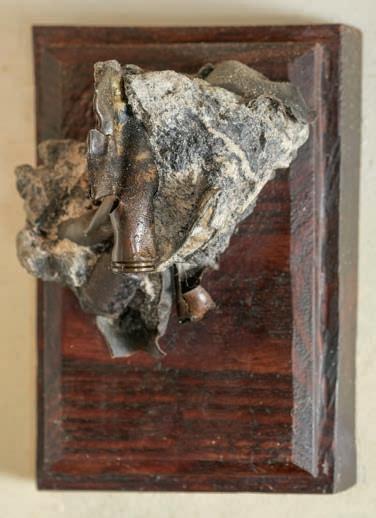
Provenance: Tonbridge Battle of Britain Museum, Malcolm Pettit.
See lots 402, 409 and 543.
(1) £100 - £150
Each lot is subject to a Buyer’s Premium of 20% (Lots marked * 24% inclusive of VAT @ 20%)
490* RAF Uniform. Battle of Britain period RAF uniform, with brass king’s crown buttons and Sergeant’s rank stripes, 40 cm chest, inner arm 45 cm, length 69 cm with trousers, sold with a composite mannequin for display purposes

Provenance: Tonbridge Battle of Britain Museum, Malcolm Pettit.
(1) £200 - £300
491* Dornier Do 17. The highly emotive propeller recovered from Dornier Do17Z 9 KG/76 (3322) which was shot down on 15 September 1940, after more than a hundred British fighters were in the vicinity of the Dornier forming like angry wasps defending their nest, multiple bullet holes and numbered 0-11-1 240, F:14 31/1, approximately 173.5 cm
Provenance: Tonbridge Battle of Britain Museum, Malcolm Pettit.
Dornier Do 17 Z 3322 was shot down at sixteen thousand feet above the London Borough of Brixton on 15 September 1940. An account supplied with records its final moments ...
Throttle wide open Flight Lieutenant Peter Brothers of 257 Squadron swung his Hurricane into a firing position behind Dornier 3322 piloted by Wilhelm Raab, a 25-year-old from Dresden. On his 44th combat mission, Raab had flown 15 times against the English but had never encountered such a determined fighter opposition. More than a hundred British fighters were in the vicinity of Raab’s Dornier forming like angry wasps defending their nest. The raiding formation comprised twenty-four Dornier of Bomber Geschwader 76 including Raab’s Dornier. Flight Lieutenant George Powell-Sheddon of 242 Squadron later commented “we were onto him like a pack of dogs!”. Squadron Leader Brian Lane of 19 Squadron was pulling Spitfire into position for another attack on the enemy formation when Raab’s Dorner came past him “reversing the turn, I followed, firing from the quarter at the starboard engine. As I slipped in astern of the Hun, a Hurricane swam up beside me firing also. I turned to one side and saw two more Hurricanes behind him. Dammit! who saw this Hun first? taking my place in the queue I waited my turn to fire”, Brian Lane observed Raab’s Dornier’s final moments. Later he wrote “throttling back, I dropped one wing to get a better view of the black crossed aircraft behind rushing over the trees and hedges, fields and roads to meet the stricken machine, I saw its shadow as the two came nearer and nearer a house loomed up, apparently in the path of the raider, with a sigh of relief, I watched it miss the obstacle. The shadow and master met a huge gush of flame as the aircraft hit the ground and exploded. The Dornier crashed at Underriver near Sevenoaks, Kent.
One crew was killed and the remaining crew were taken prisoner, the propeller was recovered at the time of the crash and later purchased by Malcolm Pettit. The propeller has been at the heart of the museum.
(1) £40,000 - £60,000

492* Hurricane P3594. Relics recovered from Hurricane P3594 which was shot down on 7 September 1940, including instrument panel, course and speed computer calculator, rudder pedal, undercarriage control throttle quadrant, airscrew level control, hydraulic ram for flaps control, heal board for pilot’s foot, pilots head armour, gunsight and radio mast




Provenance: Tonbridge Battle of Britain Museum, Malcolm Pettit. Hurricane P3594 was shot down on 7 September 1940 following an attack from a He III. The pilot, Flying Officer Patrick Hardy Vesey Wells of 249 Squadron bailed out and the aircraft burst into flames crashing on a farm track near Goodnestone Court, Faversham. Wells’ flying boots came off with the shock of the parachute opening and were later returned by the police however, several personal items were stolen from him as he was being treated.

See lot 501.
£3,000 - £5,000

493* Spitfire X4036. Relics recovered from Spitfire X4036 which was shot down on 6 September 1940, including fuselage panel and other items

Provenance: Tonbridge Battle of Britain Museum, Malcolm Pettit.
Spitfire X4036 was shot down by Me109s on 6 September 1940, Pilot Officer William Hugh Gordon of 234 Squadron was killed and the aircraft crashed at Howbourne Farm, Hadlow Down. Gordon was found in his cockpit when the aircraft was excavated in 2003, he is buried with full military honours at Mortlach Parish Churchyard, Banffshire.

(1) £500 - £800
494*Spitfire P9372. Propeller blade from Spitfire P9372 shot down on 9 September 1940, various stamps including No 2 DRG No 35409 /BR, approximately 160 cm long

See lots 439, 450, 452, 507 and 508.
(1) £1,000 - £1,500
495* Hurricane N2540. Hurricane spade grip and tailwheel from Hurricane N2540, the spade grip with single brass pneumatic gun button, 19.5 cm long, the tailwheel in unused condition numbered 4.00-3 1/2 35111, 26 cm diameter

Provenance: Tonbridge Battle of Britain Museum, Malcolm Pettit.
Hurricane N2540 of 32 Squadron was destroyed on the ground during a bombing raid on Biggin Hill on 30 August 1940. The aircraft was a write-off. The control column spade grip and tailwheel were donated to the Tonbridge Battle of Britain Museum by the son of an aircraft fitter who picked them up at the time and put them in his kitbag as souvenirs.
(2) £1,000 - £1,500
496* Spade Grip. A reproduction control column spade grip, well made in the traditional style, mounted on a wooden block for display, 19 cm high
Provenance: Tonbridge Battle of Britain Museum, Malcolm Pettit.
(1) £100 - £150
498* Spitfire R6832. Piston from Spitfire R6832 which was shot down by “friendly fire” on 28 August 1940, the piston engraved ‘Spitfire R6832 crashed 28 August 1940 at Frid Wood Stockbury Flt A. Deere bailed out from 55 Squadron RAF Hornchurch’, 13.5 cm diameter


Provenance: Tonbridge Battle of Britain Museum, Malcolm Pettit.
Spitfire R6832 was accidentally shot down by another Spitfire while engaged in a dogfight with Me109s. Flying Officer Alan ‘Al’ Deere of 54 Squadron bailed out unhurt. The aircraft crashed at Frid Wood, Stockbury, Kent. The aircraft was excavated in 1979.
See lots 499 and 500.
(1) £500 - £800
497* Ki-Gass Hand Primer Fuel Pump. Air Ministry issue circa 1942, brass with AM stamps, 14 cm long

Provenance: Tonbridge Battle of Britain Museum, Malcolm Pettit.
(1) £200 - £300
Each lot is subject to a Buyer’s Premium of 20% (Lots marked * 24% inclusive of VAT @ 20%)
499* Spitfire R6832. Compressor Pump recovered from Spitfire R6832 which was shot down by “friendly fire” on 28 August 1940, serial number N63082, stamped BT-H Compressor Type A.V.A.M., with brass plaque stamped ‘replenish with oil DTD 72 every 10 hours’, 17 cm high


Provenance: Tonbridge Battle of Britain Museum, Malcolm Pettit.
See lots 498 and 500.
(1) £200 - £300
500* Spitfire Relics. Relics recovered from Spitfire P7539 shot down on 27 October 1940, including a Pobjoy Airmotors & Aircraft Ltd data plate, serial number PAS 6984 and dated 10 November 1939 and a section of windshield, together with a battle damage patch from Spitfire P9372 shot down on 9 September 1940


Provenance: Tonbridge Battle of Britain Museum, Malcolm Pettit. See lots 498 and 499.
(1) £200 - £300
501* Hurricane P3594. Tailwheel recovered from Hurricane P3594 which was shot down on 7 September 1940, the data plate stamped 10 November 1939 with serial number PAS 6984, approximately 115 cm long
Provenance: Tonbridge Battle of Britain Museum, Malcolm Pettit. See lot 492.
(1) £3,000 - £5,000
502* Messerschmitt Me 109. Elevator trim wheel recovered from Messerschmitt Me109-E4, 62 cm long
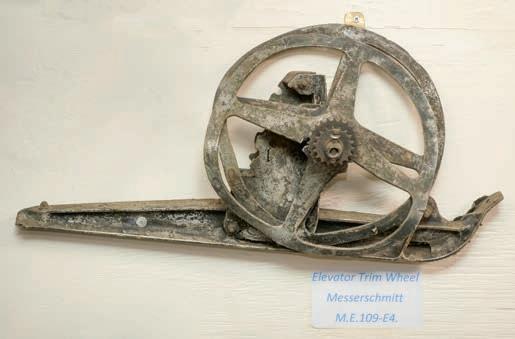

Provenance: Tonbridge Battle of Britain Museum, Malcolm Pettit.
(1) £500 - £800
503* Spitfire P7539. Relics recovered from Spitfire P7539, Pilot Officer John ‘Johnnie’ Romney Mather was killed on 27 October 1940 when his Spitfire crashed at Half Moon Lane, Hildenborough, Tonbridge, including hydraulic ram for the undercarriage control, engine mounting and other items,
Provenance: Tonbridge Battle of Britain Museum, Malcolm Pettit. See lots 401, 410 and 477.
(1) £500 - £800
504* Spitfire N3113. Tail wheel from Spitfire N3113, numbered N9987, 25 cm diameter

Provenance: Tonbridge Battle of Britain Museum, Malcolm Pettit.
Spitfire N3113 was damaged by return fire when it shared in destroying a Me110 on 20 October 1940. The pilot, Flying Officer John Wolferstan Villa force landed near Tonbridge, unhurt.
(1) £200 - £300
506* RAF Hawkinge. WWII enamel sign 'Danger High Voltage Transformer No 3', white font on red ground, 38 x 61 cm, together with 'No Live Ammunition To Be Brought Into This Building', white font on black and green ground, 46.5 x 69.5 cm


Provenance: Tonbridge Battle of Britain Museum, Malcolm Pettit. Both were originally displayed at RAF Hawkinge.
(2) £200 - £300
505* Battle of Britain. Film poster circa 1969, colour lithographic poster printed in Italy Photograph Roma, good artwork with credits beneath, framed and glazed, frame size 89 x 118 cm

Provenance: Tonbridge Battle of Britain Museum, Malcolm Pettit.
(1) £200 - £300
507* Spitfire P9372. Centre section hub for propeller, recovered from Spitfire P9372 shot down on 9 September 1940, 40 cm long

Provenance: Tonbridge Battle of Britain Museum, Malcolm Pettit. See lots 439, 450, 452, 494 and 508.
(1) £300 - £500
Provenance:
(1) £300 - £500
Provenance:
(1)
510*


WWII white silk
finely woven silk, 148 cm across Provenance: Tonbridge Battle of Britain Museum Museum, Malcolm Pettit. Many silk parachutes were adapted to make petty coats and dresses during WWII.

(1) £200 - £300
511* Pilots Signatures. Various WWII pilot’s signatures, including two signed by Adolf Galland, Leonard Cheshire and Geoffrey Wellum, last two on signed letters to Malcolm Pettit, plus a Tangmere Military Aviation Museum programme signed by Wing Commander Herbert James Lempriere ‘Jim’ Hallowes and Julius Neumann of JG 27 (they engaged in combat on 18 August 1940) and after the war became lifelong friends, other signatures include Douglas Bader, Roger Hall and Al Deere

Provenance: Tonbridge Battle of Britain Museum, Malcolm Pettit.
(1) £100 - £150
508* Reduction gear for propeller recovered from P9372 shot down on 9 September 1940, approximately 47 cm long Tonbridge Battle of Britain Museum, Malcolm Pettit. See lots 439, 450, 452, 494 and 507. 509* Hurricane L1965. Propeller hub recovered from Hurricane L1965 shot down on 30 August 1940, 70 cm long Tonbridge Battle of Britain Museum, Malcolm Pettit. See lot 440 and 441. £300 - £500 Parachute Section. parachute section,512* RAF Computer Compass. WWII RAF course and speed calculator

Provenance: Tonbridge Battle of Britain Museum, Malcolm Pettit. (1) £100 - £150
514* Battle of Britain. Combat report signed by Air Commodore Alan ‘Al’ Deere dated 28 August 1940, ‘I led 54 Squadron to intercept German bombers and escort fighter reported approaching Dover, We made contact over Dover and in the ensuing battle with Me109s the squadron split up. I managed to get on the tail of a Me109 which I chased and shot down just off the coast after a few short bursts. I did not see where it came down.’ presented in a frame with other original documents including a letter written by Flying Officer H. Pietrzak of 306 Polish Fighter Squadron, Polish Air Force dated 31 December 1942, three page typed account of the Battle of Britain signed by Air Vice Marshal Harold Bird Wilson, frame size 74 x 75 cm
Provenance: Tonbridge Battle of Britain Museum, Malcolm Pettit.
(1) £300 - £500
513* Battle of Britain. Bentley Priory interest, part of the oak floor with enamel Fighter Command badge and plaque engraved ‘part of the oak flooring of Bentley Priory Headquarters of Fighter Command from where Air Chief Marshal Lord Dowding directed the Battle of Britain’, 11 x 9 cm

Provenance: Tonbridge Battle of Britain Museum, Malcolm Pettit. (1) £70 - £100
Each lot is subject to a Buyer’s Premium of 20% (Lots marked * 24% inclusive of VAT @ 20%)
515* Battle of Britain. A four-page manuscript letter from Douglas Bader to Francis, dated 5 February 1975 on headed notepaper, Bader gives an account of an action during the Battle of Britain, the facsimiles are framed and glazed along with a black and white postcard signed by Bader, frame size 54.5 x 63.5 cm


Provenance: Tonbridge Battle of Britain Museum, Malcolm Pettit.
(1) £200 - £300
516* Battle of Britain. Ten of My Rules For Air Fighting by Sailor Malan a museum-grade print after the original poster, framed and glazed, frame size 53.5 x 40.5 cm

Provenance: Tonbridge Battle of Britain Museum, Malcolm Pettit. These posters would most likely have been hung in air barracks and briefing rooms.
Adolph Gysbert Malan, DSO & Bar, DFC & Bar (1910-1963) was better known as Sailor Malan, he was a South African RAF fighter ace who led 74 Squadron during the Battle of Britain. He finished his fighter career in 1941 with a final score of 21 destroyed 7 shared destroyed and 2 unconfirmed, 3 probable and 16 damaged.
(1) £50 - £70
517* Junkers Ju 88. Relics recovered from Junkers Ju88 A-5 (0293) which was shot down on 27 September 1940, including a piece of the wireless mast, a small piece of the propeller spinner and other items, presented in a glazed display case, 49 x 36 cm

Provenance: Tonbridge Battle of Britain Museum, Malcolm Pettit.
Junkers Ju88 A-5 (0293) was shot down by ground defences and fighter attacks during a raid over London on 27 September 1940. The aircraft crashed at Vexour Farm near Penshurst, Tonbridge and the crew were captured.
(1) £200 - £300
518* Pettit (Malcolm). Some of the Few, a collection of eighteen portrait drawings of airmen in the manner of Cuthbert Orde, two frames each with four portraits and ten frames with a single portrait, framed and glazed

Provenance: Tonbridge Battle of Britain Museum, Malcolm Pettit.
(18) £200 - £300
519* Flying Helmet. WWII Battle of Britain period B type flying helmet, soft brown leather with zip-up ear cups, chamois lining, wired with bakelite bell shaped plug, some wear together with a pair of Mk IVB flying goggles, with split lenses and cord loops

Provenance: Tonbridge Battle of Britain Museum, Malcolm Pettit.
(2) £500 - £800
(1) £100 - £150
Provenance: Tonbridge
(2) £70 - £100

Provenance:
(1) £200 - £300
‘Revo 15 Amps 50 1940’, 27.5 x 20 cm


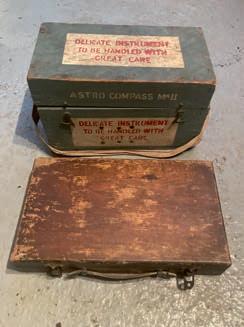


Provenance: Tonbridge Battle of Britain Museum, Malcolm Pettit. These items were recovered from the Startled Saint pub, West Malling when the airfield was strafed by Junkers Ju88. The pub was hit by 20mm cannon fire at 13.20 on 18 August 1940.
(2) £200 - £300
 520* Rolls Royce. WWII Rolls Royce Merlin flame filter, 44 cm long Provenance: Tonbridge Battle of Britain Museum, Malcolm Pettit.
521* Astro Compass. WWII RAF Astro Compass Mk II, numbered 6A/1174 4-H, in the original wooded box, together with a Course & Speed Calculator Mk II by W.G. Pye & Co, serial number 2789/36, stamped with Air Ministry markings plus inscribed with an aircraft number K8770
Battle of Britain Museum, Malcolm Pettit.
522* Flying Boots. Pair of 1936 pattern flying boots, black leather with sheepskin lining, buckles to the front, heel size approximately 29 cm long
Tonbridge Battle of Britain Museum, Malcolm Pettit.
523* Junkers Ju 88. A Battle of Britain period pewter beer mug which was hanging in Startled Saint pub when it was bombed on 18 August 1940, the mug showing bomb damage, 18 cm high, together with an electricity cover, painted in red stamped
520* Rolls Royce. WWII Rolls Royce Merlin flame filter, 44 cm long Provenance: Tonbridge Battle of Britain Museum, Malcolm Pettit.
521* Astro Compass. WWII RAF Astro Compass Mk II, numbered 6A/1174 4-H, in the original wooded box, together with a Course & Speed Calculator Mk II by W.G. Pye & Co, serial number 2789/36, stamped with Air Ministry markings plus inscribed with an aircraft number K8770
Battle of Britain Museum, Malcolm Pettit.
522* Flying Boots. Pair of 1936 pattern flying boots, black leather with sheepskin lining, buckles to the front, heel size approximately 29 cm long
Tonbridge Battle of Britain Museum, Malcolm Pettit.
523* Junkers Ju 88. A Battle of Britain period pewter beer mug which was hanging in Startled Saint pub when it was bombed on 18 August 1940, the mug showing bomb damage, 18 cm high, together with an electricity cover, painted in red stamped
524* Spitfire R6603. Ignition Harness makers plate recovered from Spitfire R6603, serial number T 54 X, oval pressed metal, 75 mm long

Provenance: Tonbridge Battle of Britain Museum, Malcolm Pettit. The plaque was recovered from Spitfire R6603 flown by Douglas Frederick Corfe. Douglas Frederick Corfe was born in Hoylake, Cheshire, he joined the Auxiliary Air Force in the 1930s and was transferred to the RAFVR in 1938 being called up for service on the outbreak of war in 1939. In June 1940 he was serving with 73 Squadron at Church Fenton and then rejoined 610 Squadron at Biggin Hill. He claimed a Me109 on 14 August and was shot down on 22 August during combat with Me109s over Folkstone. His Spitfire R6995 crashed at Hawkridge and Corfe jumped clear before it exploded. Corfe was again shot down on 18 September 1940 over Canterbury. His Spitfire R6603 crashed at Denge Wood, Petham. Corfe was admitted to Chartham Hospital. Corfe was killed in Malta on 25 April 1942, he is buried in the Naval Cemetery, Capuccini, Malta.
(1) £100 - £150
525* RAF Tangmere. An oak newel cap from the staircase of RAF Tangmere, 12 x 12 cm

Provenance: Tonbridge Battle of Britain Museum, Malcolm Pettit.
(1) £70 - £100
526* Messerschmitt Me109. Turn and Bank Indicator recovered from Messerschmitt Me109 E.1. (4851), with data plate and smashed glass

Provenance: Tonbridge Battle of Britain Museum, Malcolm Pettit. Messerschmitt Me109 E-1 (4851) overturned attempting a forced landing near Queen Anne’s Gate, Windsor Great Park following combat with British fighters during a bomber escort sortie on 30 September 1940. The pilot Oblt. Fischer was captured unhurt.
(1) £200 - £300
527* Messerschmitt Me109. A rare instrument panel, the panel itself was made recently to hold the original WWII instruments which include a revi reflector gunsight signed by three Battle of Britain Me109 pilots with original box and gunsight glass signed by Erich Hartmann, plus Junghans cockpit clock and other instruments, 67 x 60 cm

Provenance: Tonbridge Battle of Britain Museum, Malcolm Pettit.

(1) £10,000 - £15,000

Provenance:
Provenance:

A
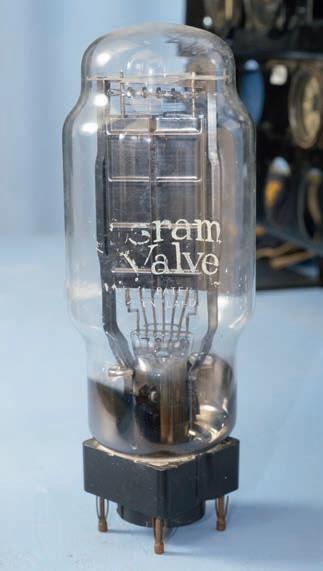

 528* Home Guard. WWII Police steel helmet, white stencilled on dark blue, together with Local Defence Volunteer (LDV) and Fire Guard armbands
Tonbridge Battle of Britain Museum, Malcolm Pettit. (3) £200 - £300
529* RAF Operation Room. An unusual steel helmet, with a microphone system, probably from an operation room Provenance: Tonbridge Battle of Britain Museum, Malcolm Pettit. (1) £200 - £300
530* RAF Hawkinge. Glass valve from the public address system at RAF Hawkinge, stamped DM DA100 4973, 24 cm high Provenance: Tonbridge Battle of Britain Museum, Malcolm Pettit. (1) £70 - £100
531* Radio Receiver. WWII fighter command radio receiver, Type T.E. by Siemens Brothers & Co Ltd, with stores reference plate stamped Ref No 10A/3333, serial number 1548K, contained in an oak case
528* Home Guard. WWII Police steel helmet, white stencilled on dark blue, together with Local Defence Volunteer (LDV) and Fire Guard armbands
Tonbridge Battle of Britain Museum, Malcolm Pettit. (3) £200 - £300
529* RAF Operation Room. An unusual steel helmet, with a microphone system, probably from an operation room Provenance: Tonbridge Battle of Britain Museum, Malcolm Pettit. (1) £200 - £300
530* RAF Hawkinge. Glass valve from the public address system at RAF Hawkinge, stamped DM DA100 4973, 24 cm high Provenance: Tonbridge Battle of Britain Museum, Malcolm Pettit. (1) £70 - £100
531* Radio Receiver. WWII fighter command radio receiver, Type T.E. by Siemens Brothers & Co Ltd, with stores reference plate stamped Ref No 10A/3333, serial number 1548K, contained in an oak case
Provenance:
These


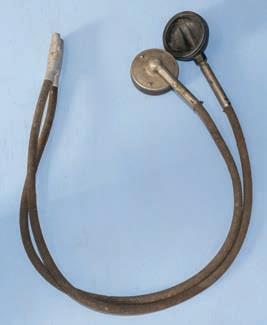
Provenance:
Provenance:
Provenance:

 532* RAF Hornchurch. WWII period gym sweater, embroidered with RAF insignia, together with a morse code key and training headset all from RAF Hornchurch
Tonbridge Battle of Britain Museum, Malcolm Pettit.
items were donated to the museum by an anonymous pilot who flew with 222 Squadron at RAF Hornchurch in 1940.
(3) £200 - £300
533* Flying Boots. Pair of 1939 pattern flying boots, black leather with green vulcanised canvas, sheepskin lining and leather straps, the soles stamped Dodco, 3 1/8
Tonbridge Battle of Britain Museum, Malcolm Pettit. (1) £200 - £300
534* German Dagger. WWII Luftwaffe dagger, the 25 cm plain blade (no maker) with eagle cross-guard and orange celluloid grip, overall length 38 cm, in its scabbard with straps
Tonbridge Battle of Britain Museum, Malcolm Pettit.
(1) £200 - £300
535* Spade Grip. A reproduction Hurricane spade grip, made in the traditional style with brass gun firing button with accompanying engraved brass plaque
532* RAF Hornchurch. WWII period gym sweater, embroidered with RAF insignia, together with a morse code key and training headset all from RAF Hornchurch
Tonbridge Battle of Britain Museum, Malcolm Pettit.
items were donated to the museum by an anonymous pilot who flew with 222 Squadron at RAF Hornchurch in 1940.
(3) £200 - £300
533* Flying Boots. Pair of 1939 pattern flying boots, black leather with green vulcanised canvas, sheepskin lining and leather straps, the soles stamped Dodco, 3 1/8
Tonbridge Battle of Britain Museum, Malcolm Pettit. (1) £200 - £300
534* German Dagger. WWII Luftwaffe dagger, the 25 cm plain blade (no maker) with eagle cross-guard and orange celluloid grip, overall length 38 cm, in its scabbard with straps
Tonbridge Battle of Britain Museum, Malcolm Pettit.
(1) £200 - £300
535* Spade Grip. A reproduction Hurricane spade grip, made in the traditional style with brass gun firing button with accompanying engraved brass plaque
536* Messerschmitt Me 109. Bottom of the rudder recovered from Messerschmitt Me109 E-1 (6281) which crashed on 25 October 1940, remains of painted canvas with bullet holes, 40 cm long
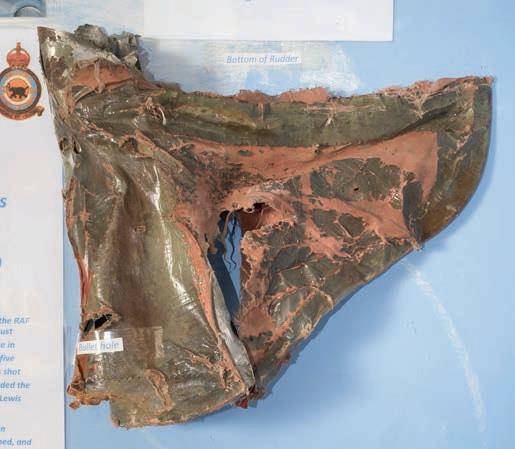
Provenance: Tonbridge Battle of Britain Museum, Malcolm Pettit.
Messerschmitt Me109 E-1 (6281) was shot down by British fighters on 25 October 1940, the aircraft crashed on Lidham Hill Farm, Guestling, Sussex and the pilot Fw. Koslowski bailed out badly burned.
(1) £1,000 - £1,500
537* Luftwaffe Wrist Compass. German AK39 armbandkompass, with black leather strap
Provenance: Tonbridge Battle of Britain Museum, Malcolm Pettit. Luftwaffe airmen carried a compass which could be worn on the wrist or upper arm, they were often tied to the life preserver or belt.

(1) £80 - £100
538* Hurricane V6617. Relics recovered from Hurricane V6617 shot down on 28 September 1940, including stainless steel brackets from the framework, section of the battery and other items


Provenance: Tonbridge Battle of Britain Museum, Malcolm Pettit.
Hurricane V6617 was shot down on 28 September 1940, the pilot Albert Gerald Lewis of 249 Squadron was badly burned and was admitted to Faversham Cottage Hospital. The aircraft crashed at Blackett’s Farm, Tonge, Kent.
(1) £200 - £300
539* Hurricane V6748. Relics recovered from Hurricane V6748 shot down on 30 September 1940, including a Browning machine gun clip and undercarriage selector and other items

Provenance: Tonbridge Battle of Britain Museum, Malcolm Pettit.
Pilot Officer John Dallas Crossman was an Australian pilot, his Hurricane, V6748 was shot down on 30 September 1940 when engaged with enemy fighters. The aircraft crashed in flames at Tablehurst Farm, Forest Row, East Sussex and Crossman was killed.
An excavation by Malcolm Pettit took place in 2013 and after many hours of searching only a small collection of items were found.
(1) £200 - £300
540* Messerschmitt Me 110. An aluminium panel recovered from Messerschmitt Me110 shot down on 29 September 1943 by Flight Lieutenant Bob Braham, DFC , stencilled F234, F234, F237, F238 ..., 25 cm long

Provenance: Tonbridge Battle of Britain Museum, Malcolm Pettit.
Messerschmitt BF.110G-4 of G6+ER Work Nr 5477, flown at that time by Hauptmann Geiger, Staffel Kapitan of 7/NJG1 from Twenthe.Geiger was a well-known night fighter pilot responsible for a large number of RAF losses, both he and his wireless operator were killed.
When they were shot down into the IJsselmeer on the night of 29 September 1943 by a Bristol Beaufighter flown by a legendary night fighter pilot and Battle of Britain pilot Flight Lieutenant Bob Braham, DFC, and his navigator. Me110 was given to Malcolm Pettit by the late Major Gerrit. Zwanenburg, leader of the Dutch Airforce recovery from 1961 until he died in 1988. He recovered over 100 aircraft and their crews. Malcolm Pettit had the honour to meet this legend of a man in 1976, when he invited him over to have a look at his museum in Holland. The relic is a small piece of the Me110, it has grey paint, and there are some remains of numbers painted in white.

(1) £100 - £200
Provenance: Tonbridge Battle of Britain Museum, Malcolm Pettit. The drogue parachute was given to an Air Raid Warden in Tovil, near Maidstone. A pilot had landed there in August 1940 and according to the notes, the pilot gave the parachute to the warden.
(1) £100 - £200
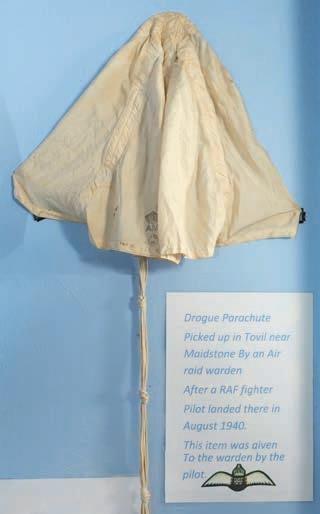
542* Spitfire Model. An exceptionally well-made model of a Spitfire circa 1990s, aluminium sheet construction mounted on a curved stand, 60 cm long x 76 cm wingspan, with articulated propeller blades and wheels
Provenance: Tonbridge Battle of Britain Museum, Malcolm Pettit.
(1) £2,000 - £3,000
543* Messerschmitt Me109 E-4. Armoured plate recovered from Messerschmitt Me109 E-4 flown by Lieutenant Frederick Klotz who was shot down and killed by Bunny Currant on 15 September 1940 (Battle of Britain Day), grey painted finish and rare, 118 cm long

Provenance: Tonbridge Battle of Britain Museum, Malcolm Pettit.
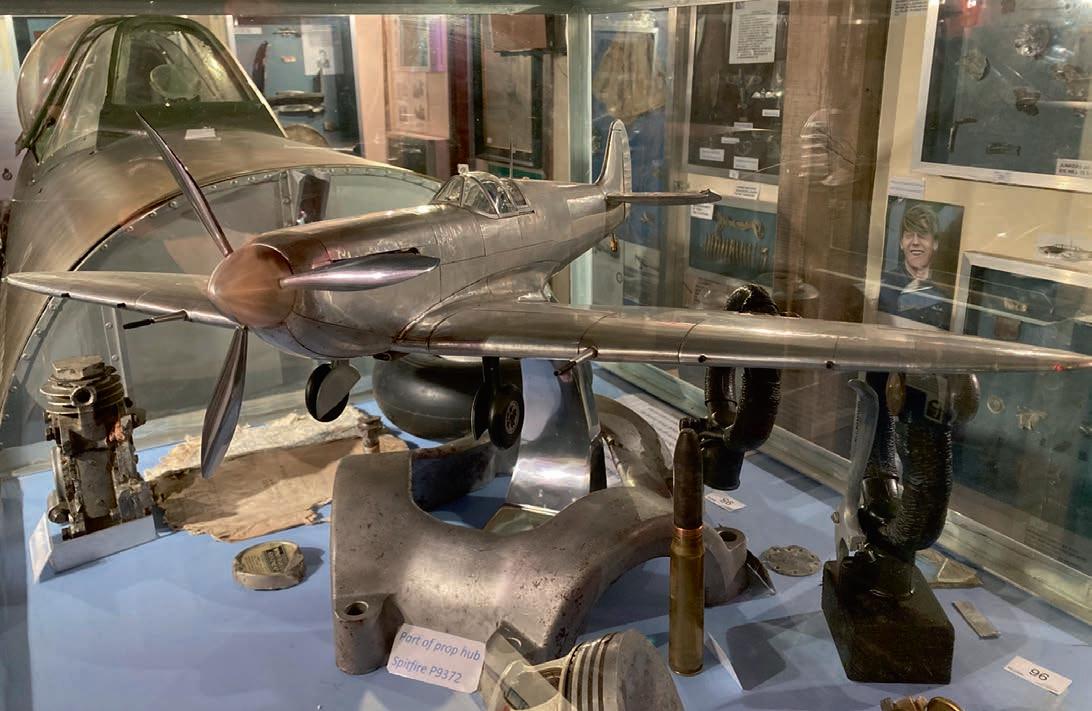
See lots 402, 408, 409 and 488.
(1) £1,000 - £1,500
544* Spitfire P9364. Tribute mirror and effects relating to Sergeant Ernest Scott, who was shot down on 27 September 1940 in Spitfire P9364, the tribute mirror encompassing a photograph of Sergeant Scott and flowers, 45 x 35.5 cm, together with a wooden box containing personal effects including Scott’s technical training books and other items


Provenance: Tonbridge Battle of Britain Museum, Malcolm Pettit. The mirror was the only place where Sergeant Scott’s mother could put flowers every 27 September as her son had no known grave. Sadly Sergeant Scott’s mother died in 1971, never knowing what had happened to her son. See lots 416, 417, 478 and 481.
(1) £300 - £500
Each lot is subject to a Buyer’s Premium of 20% (Lots marked * 24% inclusive of VAT @ 20%)
545* Battle of Britain. Brass plaque, ‘Above This Roof The Battle of Britain Was Fought and Won, August 8 - October 10 1940, This Plate is Dedicated to “The Few” A.T.I. 1946’, 15 x 25 cm

Provenance: Tonbridge Battle of Britain Museum, Malcolm Pettit. These plaques were unique to the Tonbridge area.
(1) £200 - £300
546* Mölders (Werner, 1913-1941). Black and white portrait print, period frame, glazed, frame size 68.5 x 57 cm,

Provenance: Tonbridge Battle of Britain Museum, Malcolm Pettit.
Werner Mölders was a WWII Luftwaffe pilot, wing commander and leading German fighter ace in the Spanish Civil War. He became the first pilot in history to shoot down 100 enemy aircraft and was highly decorated for his achievements. He died in a plane crash as a passenger in 1941.
(1) £100 - £150
547* Dornier Do 17. Shovel found in the sand at Whitstable during the recovery of Dornier 17Z-3 shot down by Wing Commander Frederick “Taffy” Higginson on 16 August 1940, broken point, wooden handle, 76 cm long

Provenance: Tonbridge Battle of Britain Museum, Malcolm Pettit. Presumably, the shovel was broken at the time of crash and discarded in the sand along with the aircraft wreckage. It was found by Malcolm Pettit during the dig.
See lots 405, 406, 407, 475, 476, 480 and 485.
(1) £100 - £150
548* Hurricane P3049. Relics recovered from Hurricane P3049 which was shot down on 7 September 1940, including inert rounds and a message note, presented in a glazed frame with information, frame size 46 x 46.5 cm, plus a section of an airman’s map also recovered from P3049 (this loose)

Provenance: Tonbridge Battle of Britain Museum, Malcolm Pettit.
Hurricane P3049 was shot down in combat over the Thames Estuary on 7 September 1940. The aircraft crashed at Elmley, Spitend Point, Sheppe. The pilot, Flight Lieutenant Hugh Richard Aden Beresford of 257 Squadron was reported ‘missing’.
The aircraft was excavated in 1979 and revealed that his remains were still in the cockpit. Beresford was buried at Brookwood Military Cemetery on 16 November 1979.
(2) £150 - £200
549* Meteor MK1V. Relics recovered from Meteor MK1V, flown by Wing Commander Henry Neville Ramsbottom-Isherwood when it crashed over Tonbridge in 1950, including a heliograph, presented in a glass display case, 34 x 51 cm
Provenance: Tonbridge Battle of Britain Museum, Malcolm Pettit.
Wing Commander Henry Neville Ramsbottom-Isherwood (1905-1950), was born in Wellington, New Zealand. He served with the New Zealand Rifles as a Second Lieutenant from 1924 until 1930. He moved to England to join the Royal Air force Fighter Command and after basic training he was sent to India in the 1930s, returning to England in 1935 when he joined 54 Squadron. Later he served with 35 Squadron. He was promoted to Flight Lieutenant in 1936, and served with the staff of the aeroplane and armaments experimental establishment, here he tested new aeroplanes for the RAF. He became Sector Commander of 9 Group Fighter Command. Between 1941-1942 he led 151 Squadron as Wing Commander in the Soviet Union. The wing was flying Hurricanes and was sent there to help the Soviets in their struggle against the German forces. For this, he was given royal permission to wear the order of Lenin on the 31st of March 1941. On his return to England, he was appointed AOC of RAF Church Stanton. After which he was sent to India. He became commander of 342 Wing in Burma and South East Asia, he stayed in Asia until 1947. After this, he came back to England and was appointed commanding officer of RAF West Malling. He was tragically killed in a flying accident in bad weather on 24 April 1950, when he was flying a Meteor MK1V. These few items in this case are from the Meteor that he was flying, they were found by a friend of Malcolm Pettit's who was cleaning out ditches sometime in the 1980s in a field near Tonbridge in Kent.
(1) £100 - £150
550* Cockpit Instruments. A collection of Luftwaffe cockpit instruments including a clock numbered J30BZ, 644066, 45 mm diameter, not working, an artificial horizon, an 8 day clock and other items, signed by Major Günther Rall


Provenance: Tonbridge Battle of Britain Museum, Malcolm Pettit. Major Günther Rall of JG52 was credited for 275 kills. He served alongside Gehard Barkhorn on the eastern front.
(6) £300 - £500
551* Oxspring (R.W.). Typed report signed by Bobby Oxspring, 66 Squadron circa 1960, titled the White Hart, Brasted, the account records a dinner at the White Hart in the village of Brasted which included Jamie Rankin, Paddy Barthropp, Bobby Oxsping and Sailor Malan, framed and glazed, 59 x 31.5 cm, together with a charcoal portrait of Oxspring, framed and glazed, framed size 43 x 34 cm

Provenance: Tonbridge Battle of Britain Museum, Malcolm Pettit.
(2) £150 - £200
552 Spitfire X4261. All that remains of the propeller recovered from Spitfire X4261 shot down on 5 September 1940, in relic condition
Provenance: Tonbridge Battle of Britain Museum, Malcolm Pettit.
Flight Lieutenant Frederick William Rushmer (1910-1940) was born in Sisland, Norfolk, he served with 603 Squadron, Auxiliary Air Force from 1934 and in 1939 was called to full-time service and appointed leader of Red Section. On 30 July 1940 Rushmer shared in destroying a He111 south-east of Montrose and his aircraft was hit by return fire.
On 29 August he made a forced landing at Bossingham in Spitfire P9459 after combat over Deal, he was slightly wounded.
Rushmer failed to return from combat with Do17s and Me109s over Biggin Hill on 5 September 1940. His Spitfire X4261 could have been that which crashed at Buckman Green Farm, Smarden. The pilot from this aircraft was buried as 'unknown' in All Saints' churchyard, Staplehurst on 11th September.

Rushmer was reported 'missing' and his name is on the Runnymede Memorial, Panel 4. However, Malcolm Pettit attended a memorial service at All Saint’s church in the 1990s. He attempted to resolve this and Rushmer’s headstone was changed from an unknown airman to Flight Lieutenant Frederick Rushmer which was carved into the portland stone and organised by Ted Sturgeston. The remains of the propeller was purchased by Malcolm Pettit from the London Air Museum when it closed.
(1) £300 - £500
553* Hurricane P2542. Cockpit seat recovered from Hurricane P2542, which was shot down in combat over Tonbridge on 14 September 1940, rivetted aluminium construction, 70 cm high Provenance: Tonbridge Battle of Britain Museum, Malcolm Pettit.
See lot 419.
(1) £500 - £800
554* Dambusters. A collection of relics recovered from Lancaster AJ-M (M Mother) flown by John Vere ‘Hoppy’ Hopgood on the Dambuster Raid, 16/17 May 1943, including a section of backplate spinner, presented in a glazed display case, 46 x 45.5 cm Provenance: Tonbridge Battle of Britain Museum, Malcolm Pettit.



John Vere Hopgood, DFC & Bar (1921-1943) was a pilot with 617 Squadron, he was killed in action while taking part in Operation Chastise otherwise known as the Dam Busters raid.
Hopgood joined the Royal Air Force Volunteer Reserve in 1940 and qualified as a pilot in 1941. He was awarded the DFC in 1942 after completing 47 operations, his second award bar followed in 1943.
Guy Gibson selected Hopgood as his deputy for the attack against the Möhner Dam 16/17 May 1943. Hopgood took off in the first group alongside Gibson and Mick Martin. Hopgood’s aircraft AJ-M (M Mother) was hit by flak while passing the airfield at Dülmen. Hopgood and two other crew were injured but they continued the attack.
The damaged aircraft reached the dam where they attacked at 00:32 ten minutes after Gibson. However they were struck again and their bomb was released too late. It bounced over the dam and exploded on a power station the other side. AJ-M crashed in a field near Ostönnen, 6 km from the dam. The bodies of Hopgood and crew were found inside. Hopwood is buried at the Rheinburg War Cemetery.
Malcolm Pettit excavated these items from the crash site in 1987.
(1) £200 - £300
555* Dambusters. A collection of relics recovered from Lancaster AJ-M (M Mother) flown by John Vere ‘Hoppy’ Hopgood on the Dambuster Raid, 16/17 May 1943, including a section of backplate spinner, presented in a glazed display case, 46 x 45.5 cm Provenance: Tonbridge Battle of Britain Museum, Malcolm Pettit. See lot 554.
(1) £200 - £300
556* Spitfire R6926. Relics recovered from Spitfire R6926 which was shot down on 22 August 1940, including instrument dial and inert round, presented in a glazed frame, 46 x 45.5 cm

Provenance: Tonbridge Battle of Britain Museum, Malcolm Pettit.
Spitfire R6926 was shot down over the Channel by Me109s on 22 August1940, the pilot Flying Officer Hugh Spencer Lisle 'Cockey' Dundas of 616 Squadron bailed out and was admitted to Kent and Canterbury Hospital with arm and leg wounds. The aircraft crashed in flames at Runninghill, Elham.
(1) £150 - £200
557* Pettit (Malcolm). A large collection of Battle of Britain prints, mostly framed and glazed

Provenance: Tonbridge Battle of Britain Museum, Malcolm Pettit.
(15) £200 - £300
Online Results: If you weren’t present or able to follow the auction live, you can find results for the sale on our website shortly after the sale has ended.
Payment: The price you pay is the amount at which the auctioneer’s hammer falls (the hammer price), plus a buyer’s premium (a percentage of the final hammer price) and vat where applicable. You will be issued with an invoice made out to the name and address provided on your registration form.
Please note successful bids made via live bidding cannot be invoiced or paid for until the day after an auction. A live bidding fee of 3% + VAT (Dominic Winter / Invaluable) or 4.95% + VAT (the-saleroom) will be added to your invoice.
Cheque: Cheques will only be accepted on the day of the sale by prior arrangement (please contact our office for further information). Cheques by post will be accepted but a period of 5 working days will be required for the cheque to clear before purchases can be collected or posted.
Cash: Payments can be made at the Cashier’s Office, either during or after the sale.
Debit Card: There is no additional charge for purchases made with debit cards in the UK.
Credit Cards: We accept Visa and Mastercard. It is advisable to let your card provider know in advance if you are intending to purchase. This reduces the time needed to obtain authorisation when the payment is made.
Bank Transfer: All transfers must state the relevant invoice number. If transferring from a foreign currency, the amount we receive must be the total due after the currency conversion and the deduction of any bank charges.
Note to Overseas Clients: All payments must be made by bank transfer only. No card payments will be accepted unless by special prior arrangements with the auctioneers.
Collection/Postage/Delivery: If you attend the auction in person and are successful in your bid, you are free to collect your item once payment has been made.
Successful commission or live bids will be invoiced to you the day after the sale. When it is possible for our in-house packing department to send your purchase(s), a charge for postage/packing/insurance will be included in your invoice. Where it is not possible for our in-house packing department to send your item you will be required to make your own arrangements or to contact Mailboxes etc (tel: 01793 525009) or Pack and Send (tel: 01635 887237) who may be able to help.
We provide a monthly delivery service to Central London, usually on Wednesday of the week following an auction. Payment must be received before this option can be requested. A charge will be added to your invoice for this service.
Lots marked with AR next to the lot number may be subject to Droit de Suite.
Droit de Suite is payable on the hammer price of any artwork sold in the lifetime of the artist, or within 70 years of the artist's death. The buyer agrees to pay Dominic Winter Auctioneers Ltd. an amount equal to the resale royalty and we will pay such amount to the artist's collecting agent. Resale royalty applies where the Hammer price is 1,000 Euros or more and the amount cannot be more than 12,500 Euros per lot.
The amount is calculated as follows:
Royalty For the Portion of the Hammer Price (in Euros)
4.00% up to 50,000
3.00% between 50,000.01 and 200,000
1.00% between 200,000.01 and 350,000
0.50% between 350,000.01 and 500,000
Invoices will, as usual, be issued in Pounds Sterling. For the purposes of calculating the resale royalty the Pounds Sterling/Euro rate of exchange will be the European Central Bank reference rate on the day of the sale.
Please refer to the DACS website www.dacs.org.uk and the Artists’ Collecting Society website www.artistscollectingsociety.org for further details.
1. The Seller warrants to the Auctioneer and the buyer that he is the true owner or is properly authorised to sell the property by the true owner and is able to transfer good and marketable title to the property free from any third party claims.
2. (a) The highest bidder to be the buyer. If during the auction the Auctioneer considers that a dispute has arisen he has absolute authority to settle it or re-offer the lot. The Auctioneer may at his sole discretion determine the advance of bidding or refuse a bid, divide any lot, combine any two or more lots or withdraw any lot without prior notice.
(b) Where goods are bought at auction by a buyer who has entered into an agreement with another or others that the other or others (or some of them) shall abstain from bidding for the goods and the buyer or other party or one of the other parties is a dealer (as defined in the Auction Biddings Agreement Act 1927) the buyer warrants that the goods are bought bona fide on joint account.
3. The buyer shall pay the price at which a lot is knocked down by the Auctioneer to the buyer (“the hammer price”) together with a premium of 20% of the hammer price. Where the lot is marked by an asterisk the premium will be subject to VAT at 20% which under the Auctioneer’s Margin Scheme will form part of the buyer’s premium on our invoice and will not be separately identified (the premium added to the hammer price will hereafter collectively be referred to as “the total sum due”). By making any bid the buyer acknowledges that his attention has been drawn to the fact that on the sale of any lot the Auctioneer will receive from the seller commission at its usual rates in addition to the said premium of 20% and assents to the Auctioneer receiving the said commission.
4. (a) The buyer shall forthwith upon the purchase give in his name and permanent address and pay to the Auctioneer immediately after the conclusion of the auction the total sum due.
(b) The buyer may be required to pay down during the course of the sale the whole or any part of the total sum due, and if he fails to do so after such request the lot or lots may at the Auctioneer's absolute discretion be put up again and resold immediately.
(c) The buyer shall at his own expense take away any lot or lots purchased no later than five working days after the auction day.
(d) The Auctioneer may at his own discretion agree credit terms with a buyer and extend the time limits for collection in special cases but otherwise payment shall be deemed to have been made only after the Auctioneer has received cash or a sterling banker’s draft or the buyer's cheque has been cleared.
5. (a) If the buyer fails to pay for or take away any lot or lots pursuant to clause 4 or breaches any other condition of that clause the Auctioneer as agent for the seller shall be entitled after consultation with the seller to exercise one or other of the following rights:
(i) Rescind the sale of that or any other lots sold to the buyer who defaults and re-sell the lot or lots whereupon the defaulting buyer shall pay to the Auctioneer any shortfall between the proceeds of that sale after deduction of costs of re-sale and the total sum due. Any surplus shall belong to the seller.
(ii) Proceed for damages for breach of contract.
(b) Without prejudice to the Auctioneer's rights hereunder if any lots or lots are not collected within five days or such longer period as the Auctioneer may have agreed otherwise, the Auctioneer may charge the buyer a storage charge of £1.00 + VAT at the current rate per lot per day.
(c) Ownership of the lot purchased shall not pass to the buyer until he has paid to the Auctioneer the total sum due.
6. (a) The seller shall be entitled to place a reserve on any lot and the Auctioneer shall have the right to bid on behalf of the seller for any lot on which a reserve has been placed. A seller may not bid on any lot on which a reserve has been placed.
(b) Where any lot fails to sell, the Auctioneer shall notify the seller accordingly. The seller shall make arrangements either to re-offer the lot for sale or to collect the lot and may be asked to pay a commission not exceeding 50% of the selling commission and any special expenses incurred in cataloguing the lot.
(c) If such arrangements are not made within seven days of the notification the Auctioneer is empowered to sell the lot by auction or by private treaty at not less than the reserve price and to receive from the seller the normal selling commission and special expenses.
7. Any representation or statement by the Auctioneer in any catalogue, brochure or advertisement of forthcoming sales as to authorship, attribution, genuineness, origin, date, age, provenance, condition or estimated selling price is a statement of opinion only. Every person interested should exercise and rely on his own judgement as to such matters and neither the Auctioneer nor his servants or agents are responsible for the correctness of such opinions. No warranty whatsoever is given by the Auctioneer or the seller in respect of any lot and any express or implied warranties are hereby excluded.
8. (a) Notwithstanding any other terms of these conditions, if within fourteen days of the sale the Auctioneer has received from the buyer of any lot notice in writing that in his view the lot is a deliberate forgery and within fourteen days after such notification the buyer returns the same to the Auctioneer in the same condition as at the time of the sale and satisfies the Auctioneer that considered in the light of the entry in the catalogue the lot is a deliberate forgery then the sale of the lot will be rescinded and the purchase price of the same refunded. "A deliberate forgery" means a lot made with intention to deceive. (b) A buyer's claim under this condition shall be limited to any amount paid to the Auctioneer for the lot and for the purpose of this condition the buyer shall be the person to whom the original invoice was made out by the Auctioneer.
9. Lots may be removed during the sale after full settlement in accordance with 4(d) hereof.
10. All goods delivered to the Auctioneer's premises will be deemed to be delivered for sale by auction unless otherwise stated in writing and will be catalogued and sold at the Auctioneer's discretion and accepted by the Auctioneer subject to all these conditions. In the case of miscellaneous books, the Auctioneer reserves the right to extract and dispose of books that, in the opinion of the Auctioneer at his absolute discretion, have no saleable value and, therefore, might detract from the saleability of the rest of the lot and the Auctioneer shall incur no liability to the seller, in respect of the books disposed of. By delivering the goods to theAuctioneer for inclusion in his auction sales each seller acknowledges that he/she accepts and agrees to all the conditions.
11. (a) Unless otherwise instructed in writing all goods on the Auctioneer's premises and in their custody will be held insured against the risks of fire, burglary, water damage and accidental breakage or damage. The value of the goods so covered will be the hammer price, or in the case of unsold lots the lower estimate, or in the case of loss or damage prior to the sale that which the specialised staff of the Auctioneer shall in their absolute discretion estimate to be the auction value of such goods.
(b) The Auctioneer shall not be responsible for damage to or the loss, theft, or destruction of any goods not so insured because of the owner’s written instructions.
12. The Auctioneer shall remit the proceeds of the sale to the seller thirty days after the day of the auction provided that the Auctioneer has received the total sum due from the buyer. In all other cases the Auctioneer will remit the proceeds of the sale to the seller within seven days of the receipt by the Auctioneer of the total sum due. The Auctioneer will not be deemed to have received the total sum due until after any cheque delivered by the buyer has been cleared. In the event of the Auctioneer exercising his right to rescind the sale his obligation to the seller hereunder lapses.
13. In the case of the seller withdrawing instructions to the Auctioneer to sell any lot or lots, the Auctioneer may charge a fee of 12.5% of the Auctioneer's middle estimate of the auction price of the lot withdrawn together with Value Added Tax thereon and any expenses incurred in respect of the lot or lots.
14. The Auctioneer’s current standard notices and information (i.e. Collation and Amendments) will apply to any contract with the Auctioneer as if incorporated herein.
15. These conditions shall be governed by and construed in accordance with English Law.
